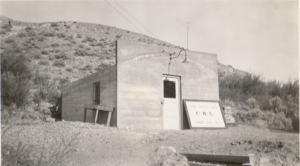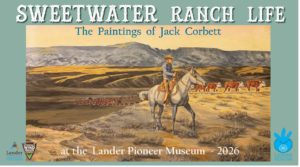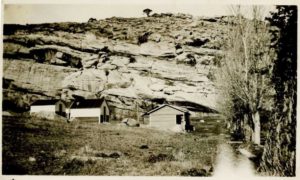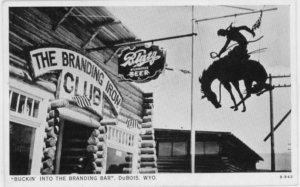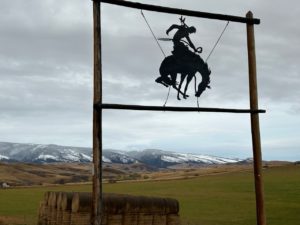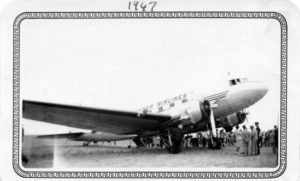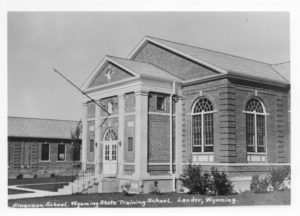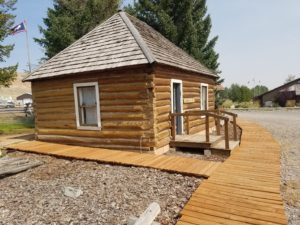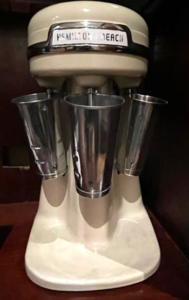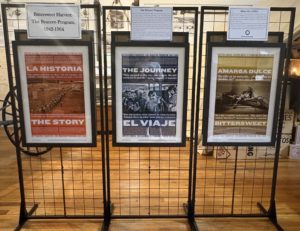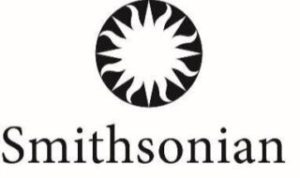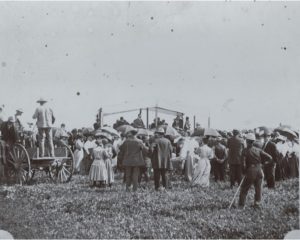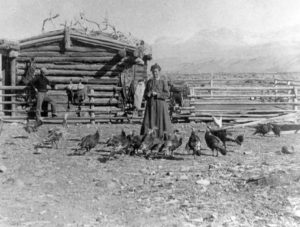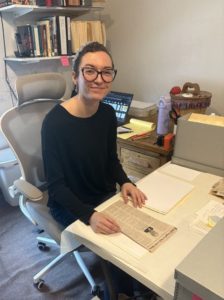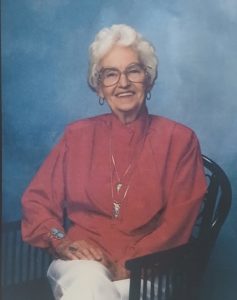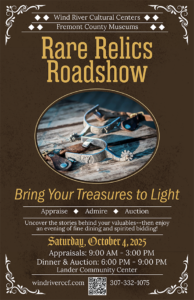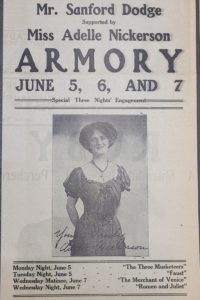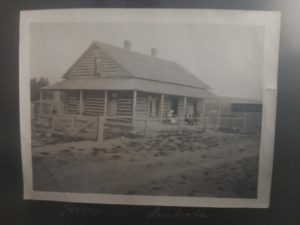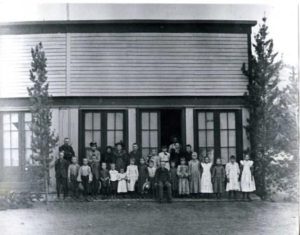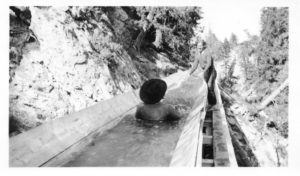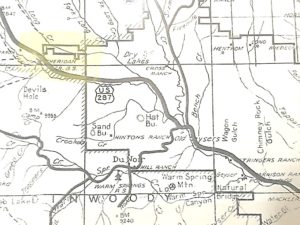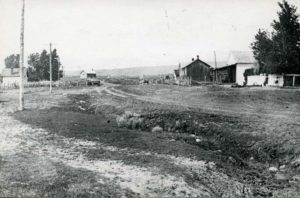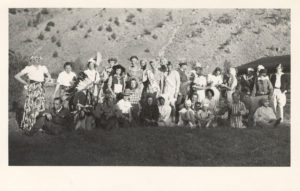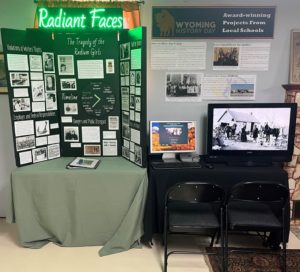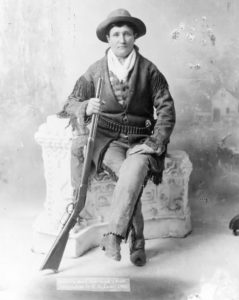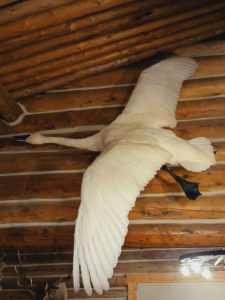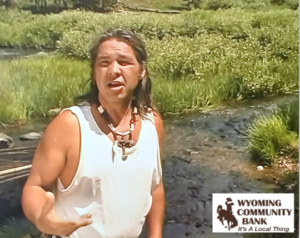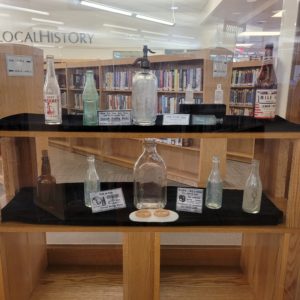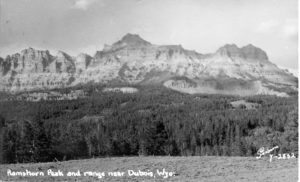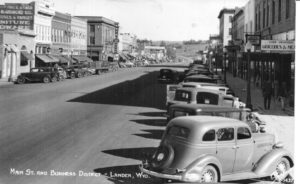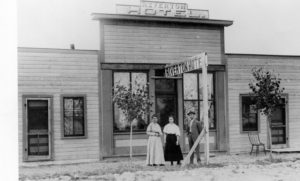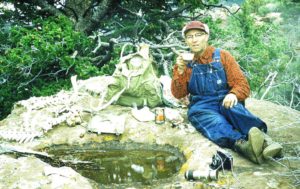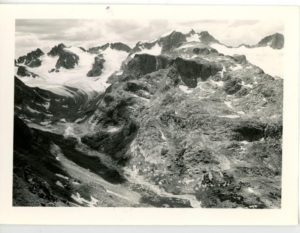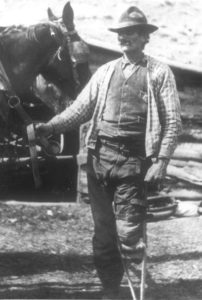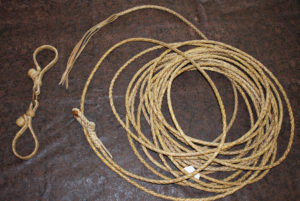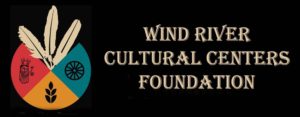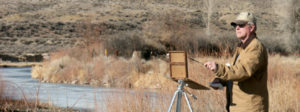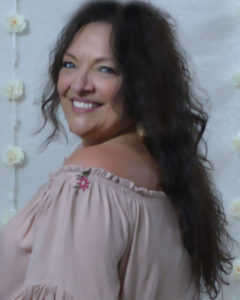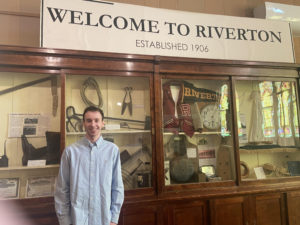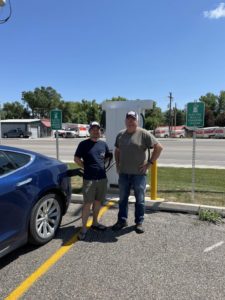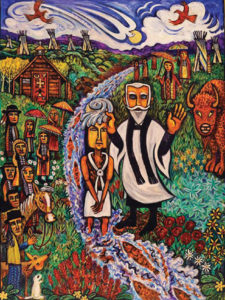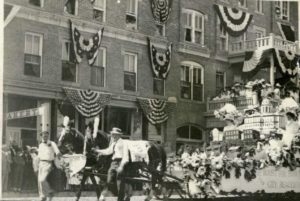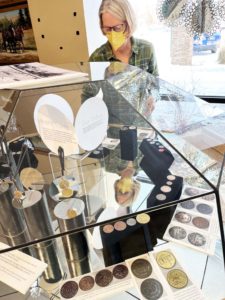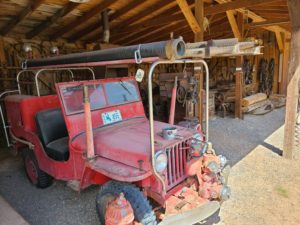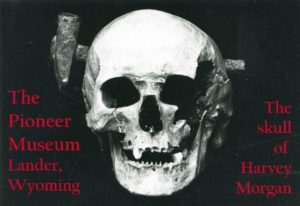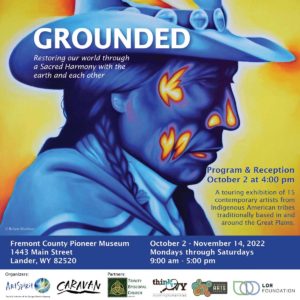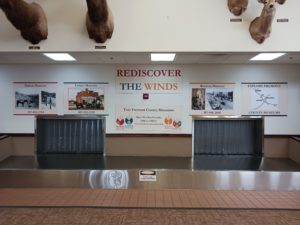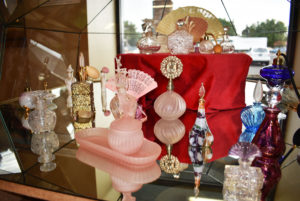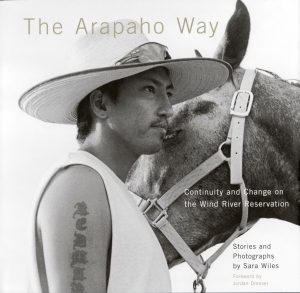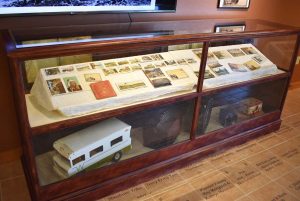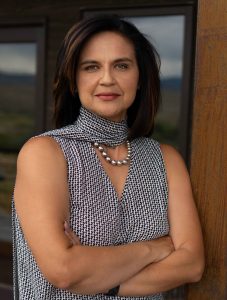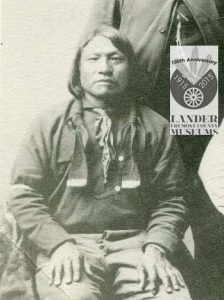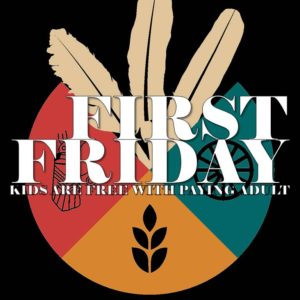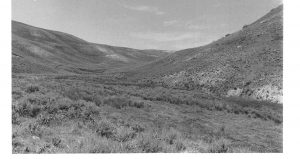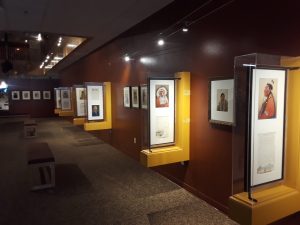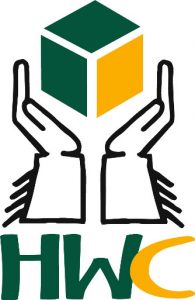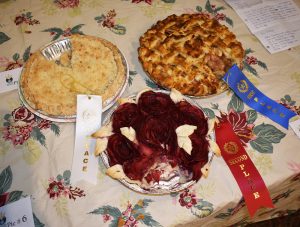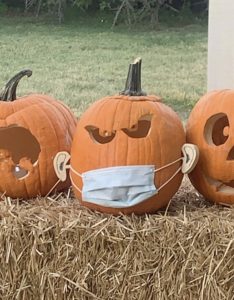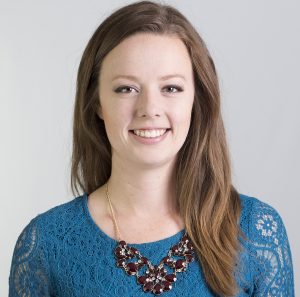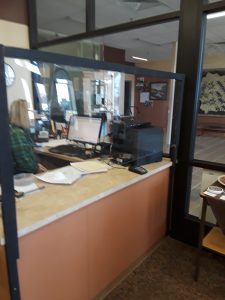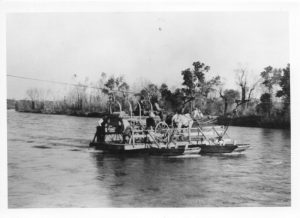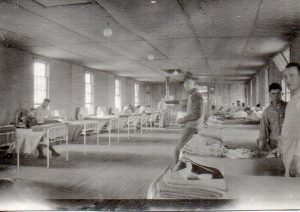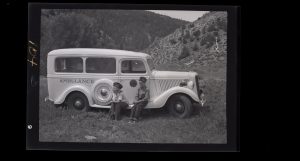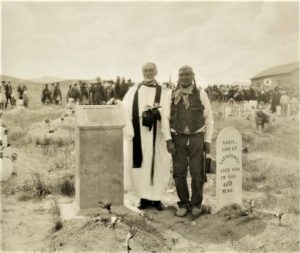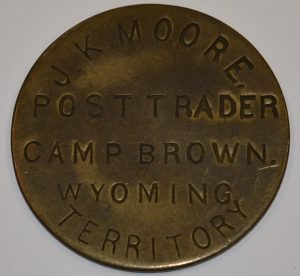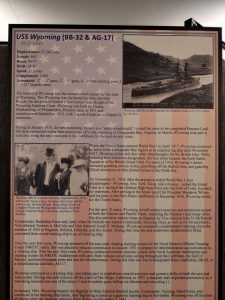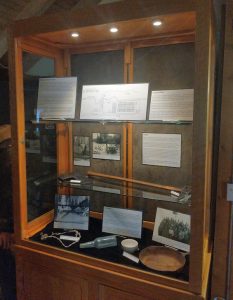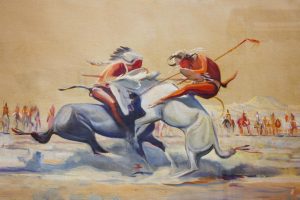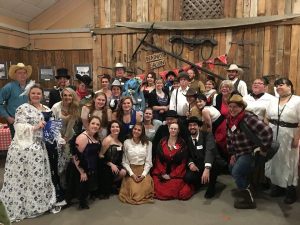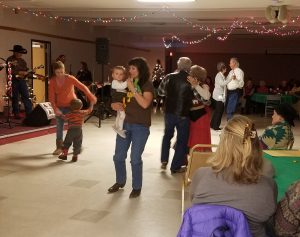December 9, 2025
Dubois Museum Seeking Collections Manager
Collections Manager:
The Dubois Museum: Wind River Historical Center in Dubois, WY seeks an energetic professional to manage the collections for one of Fremont County’s three Museums. This individual will work collaboratively with other museum staff and other museum professionals within the Fremont County Museum System.
Position Description
Collections Manager
- Oversee all aspects of collection management including planning, care, loans, conservation, accessions, storage, research, archival management, exhibits etc.
- Perform historic research and assist with research requests
- Manage part time staff, volunteers, interns
- Work collaboratively with FCMS staff to advance the mission of all three county museums
- Deliver talks and lectures for public programs and special events
- Assist with educational initiatives for various Museum audiences which may include developing and leading public curatorial and gallery talks, meeting with classes and other written materials for various audiences, leading group hikes into a variety of historic sites and areas in the area surrounding Dubois.
- Assist in planning and implementation of special events
- Work with museum support groups to promote and advance the mission of the museum
- Ability to research and write professional historic journal articles
- Assist in preparation and production of ReDiscover the Winds: A Wyoming History Podcast
- Fund raising experience a plus
Qualifications/Experience
- Minimum Bachelor’s Degree in museum studies, history, art history, American Studies or related field: 1-2 years of curatorial experience preferred; MA preferred
- Ability to work in an environment where teamwork professional respect, personal ethics and character are the foundation for achievement
- Excellent organizational skills, computer literacy skills, preferred Past Perfect experience
- Candidate must possess effective oral and written communication skills and the ability to effectively manage multiple staff and volunteers.
- Published writer a plus
- Exhibit and Interpretation experience preferred
Compensation/Benefits
- $38,780.00 per year plus very competitive benefit package that includes excellent retirement, health insurance, 10 paid holidays per year, sick leave and vacation leave.
- This position will be open until filled.
Applicants
- Send, resume, cover letter and 3 professional references and unofficial transcripts to Fremont County Museums, Central Director, Scott Goetz, 450 N 2nd Rm 320 Lander, WY 82520 or email to goetz@fremontcountywy.gov
Dubois, WY is a small community located in the gorgeous Upper Wind River Range of Wyoming within an hour and a half of Yellowstone and Grand Teton National Parks. Dubois is an outdoor enthusiasts dream!
December 2, 2025
The Dubois Jail
The Dubois Jail
-Seth McFarland
Slammer. Stockade. Dungeon. Bastille. Jail. Clink. Pokey. Hoosegow. When someone broke the law, they got to experience time in one of these. The word “jail” has its roots in old Latin meaning “cage.” Jail is usually a locally controlled way of containing those convicted of minor offences, or those awaiting trial. During the territorial days, most prisoners were kept in stockades at the various forts. In the 1860s, jails were required to be erected in every county in Wyoming. The sheriff was responsible for their maintenance. In most western towns, the jail was one of the first structures to be built, although they were often rudimentary and crude.
Early territorial jailhouses were usually basic small single-room wood buildings with barred windows, and the conditions were usually very primitive and often without heating. Many early jails used stacked two-by-four lumber construction made as temporary accommodations until a dedicated dwelling could be built.
Companies like the E.T. Barnum Wire & Iron Works in Detroit, Michigan made custom-made iron jail cells for prisons and asylums. The iron cells could be installed inside buildings, or left outside, or mounted on wagons to haul prisoners. Iron cells became common for many communities at the turn of the twentieth century.
The Civil Works Administration (CWA) was a temporary U.S. Government program created in 1933 to provide winter employment during the Great Depression. After the 1929 stock market crash, the United States needed a way to recover. Franklin Deleno Roosevelt (F.D.R.) promised wide-reaching economic and social plans during his 1932 presidential campaign. The CWA program was part of F.D.R.’s New Deal, and the CWA hired millions of unemployed people to work on temporary infrastructure and public projects such as roads, school buildings, libraries, city halls, jails, and fire stations from 1933-1934. In July of 1934, James Roosevelt, the son of the president, was reported to have visited Dubois for some fly fishing.
This program was a temporary program which served as the precursor to the more permanent federal Works Progress Administration (WPA). The CWA projects were often photographed with a CWA sign after the project was completed, demonstrating what the program had achieved. The Civil Works Administration completed two projects in the Dubois area, constructing the jail in Dubois and the original airport. In 1938, the Wyoming Archaeological Survey was completed as part of a WPA project. This provided one of the first surveys of the archaeology around Dubois and throughout the Wind River.
Communities throughout the country used the labor of CWA workers for repairs, renovations, remodeling and new construction. Dubois did not receive a city hall as many communities did, but the town did receive a new jail. The jail was built out of concrete as the western base of Cemetery Hill, just south of the St. Thomas’ Church.
Dubois was truly a colorful town in the 1930s. A few years before in 1928, the Dubois Marshal Ginger had complaints of aggravated assault brought against them. In the March 15, 1928 Riverton Review, it was stated “Dubois was without a jail, suitable in which to house a prisoner at this time of the year. It was cold, and illness might result to any person left there, making the town of Dubois liable.”
In the early years of Dubois, the mayor determined where the town council met. According to Harold Boedeker in the 1930s, the meetings were usually held in the mayor’s office or in the barber shop. From 1931 to 1937 there were seven town marshals. From 1933 to 1935, J. W. Michael was elected as the mayor and also served for four months as town marshal. He owned a trucking business and had been a write-in candidate as a practical joke in 1933. According to Dubois historian Mary Allison, Michael had to be bailed out of jail for writing bad checks so that he could be sworn in to office.
In 1960, the town hall was built behind the Dubois Cold Storage with the north addition used for a fire hall. The town jail was in the rear of the building with two cells, complete with a stool, shower and lavatory.
Next up for the Fremont County Museum
December 13, 2pm at the Riverton Museum, “Santa’s Workshop” Bailey Tire/Pit Stop Children’s Exploration Series
December 13, 10-4pm at the Riverton Museum, “Christmas Open House”
December 13, 6-8pm at the Pioneer Museum, “Old Fashioned Christmas in the Pioneer Village’ Bailey Tire/Pit Stop Children’s Exploration Series
December 13, 11-3pm at the Dubois Museum, “Holiday Open House”
Thru December, 9-5 at the Riverton Museum, “History Day Exhibits” Shoshone Schools
Call the Dubois Museum 1-307-455-2284, the Pioneer Museum 1-307-332-3339 or the Riverton Museum 1-307-856-2665 for detail regarding their programs.
The Dubois Museum, the Pioneer Museum in Lander and the Riverton Museum need your financial support. In the current economic environment, the museums are more reliant than ever on donations from the private sector to continue to provide the quality programs, collections management, exhibits and services that have become their hallmark over the last four years. Please make your tax deductible contribution through the Wind River Cultural Centers Foundation www.windriverccf.com or by sending a check to Fremont County Museums 450 N 2nd Rm 320 or taking it directly to the museum you choose to support.
November 14, 2025
“Sweetwater Ranch Life, The Paintings of Jack Corbett”
“Sweetwater Ranch Life, The Paintings of Jack Corbett” opens January 24 at the Lander Pioneer Museum.
The new exhibit premiers to the public the work of a Fremont County rancher and Artist. Ribbon cutting and opening reception January 24, 3 to 5 p.m.
Ranch life is hard, with dawn to dusk work during all seasons and in all kinds of weather. With the work load it is hard to imagine time for creative outlets, yet many ranchers played music, wrote or created art. Jack Corbett, who ranched along the Sweetwater River in Fremont County painted – capturing the ranch life of his family and friends on canvas. The work has never been seen by the general public, but will get a premier at the Lander Pioneer Museum January 24, from 3 to 5 p.m. in the museum’s main gallery.
A reception with appetizers and a brief talk by members of the artist’s family Following will be a ribbon cutting for the exhibit. The public is invited to come and enjoy the afternoon. The art will then be on display through 2026.
“Over the last few years, we have featured nationally famous art and artists of the American west like Joe Scheurle, Frederick Remington and J.K. Ralston,” said Museum curator Randy Wise. “We also are proud of show the work of local artists.” A recent exhibit at the museum by Arapaho artist Al Hubbard presented a contemporary Indigenous artist’s vision. The year before Hudson painter Jerry Antolick had a painting display at the museum. “We are thrilled to be able to showcase the excellent work of another local artist,” said Wise. “It’s very exciting that the public will be able to see this work for the first time.”
John (G) Corbett was born December 16, 1938 in Lander, Wyoming to Thad and Mary Noble Corbett. He was the eldest of seven children and worked on his great Uncle Sanford Mills’ Red Bluff Ranch as a young kid. Jack then began working for Sweetwater area ranchers in the summer of his teenage years. Later Jack settled with Albert and Barbara Myers on their ranch on the Sweetwater for thirteen years, breaking horses for the Myers’ and various other ranchers. He married Jean Ann Rogers, and they continued at Myers; and leased the Walt Hurner Ranch on Long Creek.
After moving to the ranch on Long Creek, they had two children, Troy and Stacie and later purchased the Hurner Place. In 1979, Jack and Jean leased the JJ Ranch on Sweetwater and later added the lease of the Hoffmeister Ranch, all of which the family continue to operate.
Jack became a Brand Inspector in 1970, as well as board member on the Popo Agie Conservation District. He served on the Jeffrey City School Board for several years in the 1980’s. Jack was also involved in the Sweetwater Roping Club and Sweetwater Firefighters.
He became an artist at a young age and painted a good many oil paintings that showed the life on the ranch and painted pictures of his neighbors doing their work.
Jack enjoyed his horses, still riding young horses and working with his eight grandsons doing what he had always done, with his neighbors and his cattle.
“Sweetwater Ranch Life” kicks off a packed 2026 at the museum. The museum will offer its very popular events like Sheep Shearing Day, and Apple Fest, Halloween Night at the Museum and the always exciting Trek, Speakers and Children’s Programs throughout the year.
For more information visit the museum website at www.fremontcountymusuems.com, on Facebook at Pioneer Museum Lander Wyoming or call 307-332-3373.
Press contact Randy Wise, 307-332-3373 or randywisepioneermuseum@gmail.com
Pine Bar Dude Ranch
Dude Ranching has a long history, starting in the late 1800’s with Howard Eaton, who ran the first dude ranch and is credited with coining the term ‘dude’ as a definition of the guests whom he hosted at his ranch. As cattle prices fell and ranchers looked to other means to make money, dude ranching started to gain popularity in the West and Wyoming certainly was no exception. Dude ranches cropped up across the state, offering paying customers the chance to experience the West, be guided along trails, and see a much different way of life.
Their popularity was at its height in the 1920’s, with several around Yellowstone in particular. This decade also saw the creation of the Dude Rancher’s Association, which strove to set industry standards, and also helped conservation efforts as many acted as guides and saw the need to protect wild places. Lander itself had a dude ranch operation, which also had its heyday in the 1920’s.
Situated in the North Fork Canyon, this ranch was first set up as a Dude Ranch by a group of gentlemen in 1916. Created under the incorporation of the “Rocky Mountain Resort Company”, Frank Hudson was president, Frank V. Marsh was the secretary and treasurer, and John W. Erhart and L.G. Hoffner were the first ranch managers. The next year, Mr. Hoffner bought out John Erhart’s share of the company and ramped up operations.
Pine Bar Ranch had the North Fork river nearby, and lakes within trekking distance as they took visitors on guided trails. They had fish stocked to boost their fishing capabilities, installed a telephone line early on, and had an apple orchard as well. Cabins were added as time went on, to better accommodate larger groups as well as make the grounds scenic and inviting.
In 1921, the ranch again exchanged hands and newspapers noted that there would be improvements made. Dinners were served at the ranch, and visitors were still coming out for extended stays. Reed Allen was the ranch manager at this time, and hosted many visitors including bigger groups. The Lander Kiwanis utilized the space to host the Casper Kiwanis in 1924.
Despite the seeming success, there was a foreclosure sale in January of 1925 and the property was sold to Felix Wilson. Reed Allen stayed on for a few more years as the ranch manager, and continued to increase traffic to the dude ranch. In the summer of 1925, he hauled a boat up to Grave lake, hosted Riverton Brownies, and family reunions were held at the dude ranch.
Felix ended up selling the property in 1926 to Ben Weeks, and Ben ramped up efforts. For the next several years, Ben worked hard at promotion and improvements on the dude ranch. September of 1926 saw Judge Fourt set out for a trek of Dickinson Park with a photographer to promote the mountains of the area, guided by Ben. August of 1927 saw a group from Chicago, the “Prairie Club”, come out for a guided trek to view the glaciers. Many trail guides were outfitted at the Pine Bar over the years.
The ranch was host to several large groups, from Boys and Girls to out of state visitors, and hosted the state wide Extension Club annual meeting of “Mothers and Leaders” in 1928. Promotion of the area as a tourist destination was bolstered by guests and local newspapers praising the resort as one of merit. Ben kept in touch with the local community, continuing to raise apples in the orchard and hosting dinners and dances for locals to attend, and allowing visitors to come and fish the river on site.
Eventually, Ben Weeks went on to other ventures, becoming the deputy for the Wyoming state Dairy, Food and Oil division of the Department of Agriculture in 1930. Pine Bar Ranch has had various owners over the years, and the past echoes of dudes may still be heard. The heyday of the dude ranch may have been the 1920’s, but it is still a proud tradition in the state today.
Next up for the Fremont County Museum
November 15, 1pm at the Pioneer Museum, “Christmas Stocking Party” Bailey Tire/Pit Stop Children’s Exploration Series
December 13, 2pm at the Riverton Museum, “Santa’s Workshop” Bailey Tire/Pit Stop Children’s Exploration Series
December 13, 10-4pm at the Riverton Museum, “Christmas Open House”
December 13, 6-8pm at the Pioneer Museum, “Old Fashioned Christmas in the Pioneer Village’ Bailey Tire/Pit Stop Children’s Exploration Series
December 13, 11-3pm at the Dubois Museum, “Holiday Open House”
Thru December, 9-5 at the Riverton Museum, “History Day Exhibits” Shoshone Schools
Call the Dubois Museum 1-307-455-2284, the Pioneer Museum 1-307-332-3339 or the Riverton Museum 1-307-856-2665 for detail regarding their programs.
The Dubois Museum, the Pioneer Museum in Lander and the Riverton Museum need your financial support. In the current economic environment, the museums are more reliant than ever on donations from the private sector to continue to provide the quality programs, collections management, exhibits and services that have become their hallmark over the last four years. Please make your tax deductible contribution through the Wind River Cultural Centers Foundation www.windriverccf.com or by sending a check to Fremont County Museums 450 N 2nd Rm 320 or taking it directly to the museum you choose to support.
November 7, 2025
BH&R (Bucking Horse and River)
BH&R (Bucking Horse and Rider)
Our culture is filled with symbols and icons. They are used on every electronic device, on social media, and to convey messages on our highways, packages, and to represent companies. Wyoming’s bucking horse and rider is such a longstanding symbol that anyone recognizes the connection to Wyoming’s cowboy spirit, resilience, and how it embodies the state’s tough, independent nature. Two forces of nature - cowboy who cannot be thrown, and a horse which cannot be ridden.
The bucking horse and rider icon is a registered trademark of the state of Wyoming because of its long history in the state. It has become a cultural icon for Wyoming, but a symbol that has been adopted by other cultures and institutions as well. There have been many versions of the identities of the famous Wyoming duo, and many origin stories as well. Versions of the figure date back as early as 1918.
Many Wyoming residents know of the stories of George Ostrom’s 1918 icon used by the Wyoming National Guard E Battery, Third Battalion, 148th Field Artillery Regiment in France during World War I.
Others have contested that Dewey Jones’ version which he used in the U.S. Army Air Service also during World War I is the original. A few years after World War I, the University of Wyoming began using an insignia that was different from the versions of either Jones or Ostrom. A similar logo, created by artist Wallace Smith in 1924 was created for and registered by the Pendelton Rodeo.
Over the decades, there were many who argued who was the actual horse and rider used to inspire the Wyoming icon. Today, most say that the bronc and rider which inspired the artist Allen True used to design the 1936 Wyoming license plate were Albert “Stub” Farlow and probably Steamboat, the ornery legendary horse with a broken nose which many said could not be ridden. Yet, the debate continues about the true identity of both horse and rider.
According to the Wyoming Secretary of State’s website, in 1935, then Secretary of State Lester Hunt proposed legislation to make changes to the Wyoming license plate to combat problems of wide-spread license plate counterfeiting. Colorado artist Allen Tupper True was commissioned $75 to create a unique license plate which incorporated the bucking bronc and rider. True had been painting murals in the Wyoming House and Senate at the time and had used many images for reference when designing the commissioned artwork for Hunt’s license plate.
Wyoming first required registration plates for residents beginning in 1913. By the 1920s, most states were issuing embossed metal license plates. States began incorporating symbols and slogans to reflect their identity such as the Idaho Potatoes (which began in 1928). 1936 was the first year that Wyoming license plates featured the famous horse and rider. A trademark for the image was acquisitioned that same year.
Both Secretary Hunt and Stub Farlow were from Lander. Another local story that helped inspire the myth of the bucking horse and rider originated in Dubois. In 1934, Leslie (Les) Wright and Tom Hulett opened the Branding Iron Club. Wright had moved to Dubois from Dayton, Wyoming in 1920, and became the president of the Dubois Chamber of Commerce. In a 1974 article in the Sheriden Press, Wright recounted the story. “Since Dubois was, at the time, a ‘tourist’ town, and since it was also noted for its rodeos, I decided to create a bucking horse and rider as an eye-catching sign calling attention to the club.” He explained that he acquired a piece of tank steel, and using chalk, drew an outline of a bucking horse and rider. He then hired a local mechanic to cut out the silhouette with a torch. The finished sign was over six feet tall which he painted with black paint. It became popular with the tourists, and postcards of the sign were produced for sale.
Wright was well acquainted with Lester Hunt, who had been Wright’s dentist in Lander. Upon request, Wright supplied Hunt with images of his new sign. Although the sign’s image was not used by the artist Allen True, Wright claimed that it was still inspiring. The Branding Iron eventually sold in 1939, and the sign was relocated to the ranch of G. H. Sheeley, Wright’s brother-in-law, between Dayton and Parkman. Today, the building which had been the Branding Iron no longer has an image of a bucking horse and rider; however, the new owner has modified the concept by placing a steel horse and skeletal rider on top of the Outlaw Saloon.
The original bucking horse and rider sign created by Wright still hangs over the Sheeley Ranch, a lasting symbol of Wyoming pride.
Next up for the Fremont County Museum
November 13, 6pm at the Riverton Museum, “Preserving Personal Photographs and Heirlooms” Wyoming Community Bank Discovery Speakers Series
November 15, 1pm at the Pioneer Museum, “Christmas Stocking Party” Bailey Tire/Pit Stop Children’s Exploration Series
December 13, 2pm at the Riverton Museum, “Santa’s Workshop” Bailey Tire/Pit Stop Children’s Exploration Series
December 13, 10-4pm at the Riverton Museum, “Christmas Open House”
December 13, 6-8pm at the Pioneer Museum, “Old Fashioned Christmas in the Pioneer Village’ Bailey Tire/Pit Stop Children’s Exploration Series
December 13, 11-3pm at the Dubois Museum, “Holiday Open House”
Thru December, 9-5 at the Riverton Museum, “History Day Exhibits” Shoshone Schools
Call the Dubois Museum 1-307-455-2284, the Pioneer Museum 1-307-332-3339 or the Riverton Museum 1-307-856-2665 for detail regarding their programs.
The Dubois Museum, the Pioneer Museum in Lander and the Riverton Museum need your financial support. In the current economic environment, the museums are more reliant than ever on donations from the private sector to continue to provide the quality programs, collections management, exhibits and services that have become their hallmark over the last four years. Please make your tax deductible contribution through the Wind River Cultural Centers Foundation www.windriverccf.com or by sending a check to Fremont County Museums 450 N 2nd Rm 320 or taking it directly to the museum you choose to support.
October 31, 2025
Riverton Airport
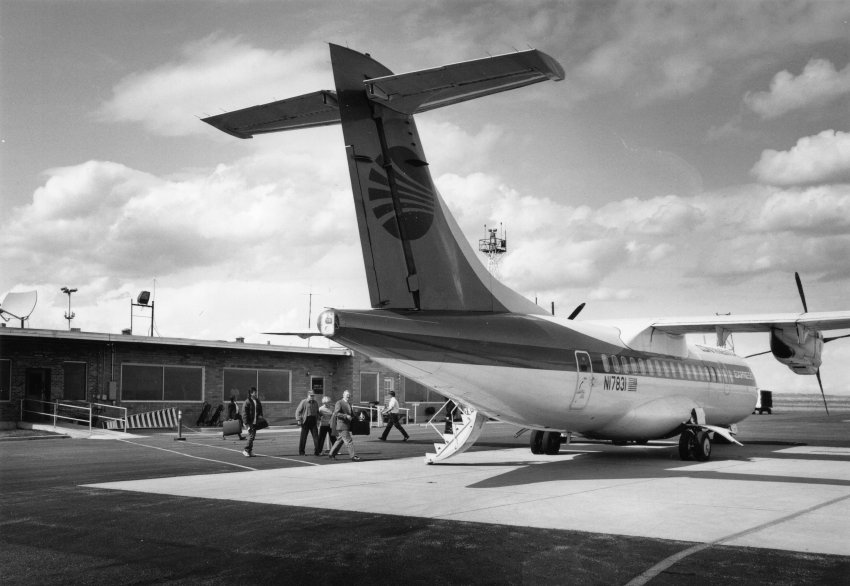
The year was 1934 and there were 1,100 men unemployed in Fremont County. The Great Depression had hit the country and county hard. Looking for ways to boost employment, the mayor and councilmen of Riverton applied for and won authorizations from the Public Works Department for three projects.
One of these projects was the Riverton Airport, now called Central Wyoming Regional Airport after a name change in 2020.
Riverton did have a landing strip that had been in use for a few decades prior to the 1930s but lacked a formal airport. With the authorization, the city acquired 640 acres of land, and it was here they constructed a large steel hangar.
The airport continued to expand from the 30s onward. A building, also built during the Depression, was moved onto the airport site and eventually converted into a popular nightclub, The Sky Club. Other parts of the building were utilized as offices and a terminal for Challenger Airlines. Challenger began regular service in Riverton in 1947. They provided flights to a variety of cities including Albuquerque, Billings, Cheyenne, Cody, Denver, Laramie, and Salt Lake City. At this time, the runways were still sod and gravel and the airline used DC3 planes that were converted from their previous use as cargo and troop transporters during World War II.
In 1950, Challenger, Monarch Air Lines, and Arizona Airways merged to create Frontier airlines. During this time the first section of paved runway was added to the airport. Later, the runways were elongated, taxiways added, and the terminal underwent an expansion. Frontier also retired their use of DC3s and converted to Convair 580s.
By the 1960s, 33 people were employed at Riverton airport, Frontier provided 6 round trips into Riverton each day, and aviation became an important part of Fremont County and Riverton’s economy. Along with the movement of people, goods, equipment, and mail were also flown in. Between the years of 1961 and 1962 over 18,000 pounds of mail had been moved through Riverton airport.
Later on, Riverton was also home to the Riverton Aviation Incorporation which hosted the Cessna Pilot Training Center and instructed student pilots. Riverton Aviation went on to hold a contract to fuel all of Frontier’s planes at the airport. They made headlines in the 1970s when they became the first company in Wyoming to hire women to fuel airplanes. The company even changed the name of the occupation from linemen to line persons to include the women that worked the job.
In the mid-1970s, the airport was in need of updates. The FAA had put out new standards and airlines were switching over to jets. These larger planes were hard to accommodate as Convair 580s were phased out.
By 1974 there was a $4.5 million dollar, improvement plan in the works. In February of 1975 ground had officially been broken on the airport expansion as an additional 1,300 acres of land was acquired. By 1978 jet services had officially started in Riverton.
Seven years later, Frontier’s jets stopped servicing Riverton citing increased operation costs. Since then, a variety of airlines have come and gone at Riverton Airport including Pioneer, Great Lakes Aviation, Continental, and United, which is currently serving the airport.
So, the next time you take to the skies at Central Wyoming Regional Airport think of its humble beginnings and how a key part of the community came out of economic hardship.
Next up for the Fremont County Museum
November 4, 6-8pm with the Riverton Museum, “Trivia Night” at the Riverton Branch Library
November 13, 6pm at the Riverton Museum, “Preserving Personal Photographs and Heirlooms” Wyoming Community Bank Discovery Speakers Series
November 15, 1pm at the Pioneer Museum, “Christmas Stocking Party” Bailey Tire/Pit Stop Children’s Exploration Series
December 13, 2pm at the Riverton Museum, “Santa’s Workshop” Bailey Tire/Pit Stop Children’s Exploration Series
December 13, 10-4pm at the Riverton Museum, “Christmas Open House”
December 13, 6-8pm at the Pioneer Museum, “Old Fashioned Christmas in the Pioneer Village’ Bailey Tire/Pit Stop Children’s Exploration Series
December 13, 11-3pm at the Dubois Museum, “Holiday Open House”
Thru December, 9-5 at the Riverton Museum, “History Day Exhibits” Shoshone Schools
Call the Dubois Museum 1-307-455-2284, the Pioneer Museum 1-307-332-3339 or the Riverton Museum 1-307-856-2665 for detail regarding their programs.
The Dubois Museum, the Pioneer Museum in Lander and the Riverton Museum need your financial support. In the current economic environment, the museums are more reliant than ever on donations from the private sector to continue to provide the quality programs, collections management, exhibits and services that have become their hallmark over the last four years. Please make your tax deductible contribution through the Wind River Cultural Centers Foundation www.windriverccf.com or by sending a check to Fremont County Museums 450 N 2nd Rm 320 or taking it directly to the museum you choose to support.
October 24, 2025
Wyoming State Training School today known as Wyoming Life Resource Center

The early roots of the Wyoming State Training School go back to Territorial Wyoming 1888. In that legislature up to $25,000 was appropriated for a State Poor Farm to care for people who could not care for themselves. Land was purchased close to Borner’s Garden up Sinks Canyon for the project, but little else was done and the remaining funds remained unspent.
In 1906 Governor Brooks became interested in providing institutional care for citizens with disabilities. Two legislators from Fremont County, Dr. Denis Godfrey and Robert Hall introduced a bill in February of 1907, “to establish a home and training school for the feeble minded and epileptic, assigning the lands and property of the State Poor Farm to that purpose making appropriations for the same...”. In 1909 members of the State Board of Charities, which included the Governor, the Secretary of State and the State Superintendent, visited Lander to look for a site for a school for the
“feeble minded and epileptics”. The wording sounds harsh to modern ears, but it was a different time with different sensibilities. They decided on a tract of land of a little more than 100 acres on a bench overlooking the Popo Agie river just east of Lander. The Iiams family was paid $6000 for the land. The tract of land at Borner’s Garden was also sold for $6000 in that same time frame. On March 1, 1911 the name of the school was changed to “Wyoming Home for Defectives.” Dr. Thomas Maghee, an early physician who had served at Camp Auger was appointed Superintendent of the School and the first patients were admitted June 20, 1912 and by the end of 1912, 23 students lived at the school. Dr. Maghee had some success treating his epileptic charges by calming their seizures with drugs and making many of their lives more functional. On February 21,1921 the name of the school was changed to The Wyoming State Training School. By 1923 the population of the school had increased to 156. In the early days elderly and orphans were also housed at the Training School.
An unsigned editorial in the paper from 1923 complained about the number and the expense of keeping feeble minded people. It seemed to link everything from rising crime to tuberculosis and venereal disease to the feeble minded and seemed to advocate for forced sterilization. The article quotes from a publication by the National Committee for Mental Hygiene:
“Mentally defective persons, by reproducing their kind, provide an endless stream of defective progeny who are a serious drain upon the resources of the nation.”
The pseudoscience of eugenics was growing in popularity at the time and would culminate in Nazi Germany with the theory of a superior Aryan Nation and the deaths of six-million European Jews in the Holocaust. In spite of this, the Wyoming State Training School continued to provide compassionate care for their students in accordance with the standards of the time.
Mrs. Betty Henry started working at the State School in 1920 and spent a 40-year career there working as a teacher. She taught music, weaving and knitting and for a time kindergarten to residents of the school. When she was interviewed upon her retirement, she was supervising a knitting class who were making gifts for Parents’ Day.
In 1931 the ground was broken for the Emerson Building. The building would include a gymnasium which could accommodate a theater. It also contained classrooms and living quarters. The Emerson building became the social center of the school.
The State School continued to grow. Today agricultural land has been added and the Honor-Farm inmates manage a herd of cattle on the property. Luckey Pond, named for former residents of the State School, is used as a fishing pond and picnic area by many Lander people. Many of the resident’s cottages were named for former governors or former superintendents. Today, the campus covers 474 acres.
The school reached its highest enrollment in 1972 with 740 students living at the State Training School. That year Public Law 94-142 mandated that students with disabilities from age 3 to 21 must be educated in the least restrictive environment and with their general education peers to the maximum extent possible. Grants were obtained and The Community Entry Service started operating in the old federal building assisting former state school residents in finding placements in the community. Enrollment steadily dropped at the State School as students were returned home or placed in group homes or independent living homes.
In 1990, before the Americans with Disabilities Act, a class action suit titled, Weston vs Wyoming State Training School was brought before a judge. The court found in favor of Weston, and reforms were instituted at the Training School such as more individualized assessment of the students and more privacy for residents. The changes improved the quality of life for the residents.
In 2008 the name of the school was changed again to the Wyoming Life Resource Center. They no longer serve minors but, “provide high-level intermediate and long term care and services to individuals in Wyoming who are hard to place, who have high medical needs or with exceptionally difficult behaviors.” People with acquired brain injury are also served at the Life Resource Center. Today the census at the center is 47 with a waiting list. They could accommodate up to 100 individuals if staff was available.
Society’s treatment of the disabled has evolved since the state first instituted a school for the disabled in 1906. Treatment has become a much more humane, compassionate and inclusive way to treat our fellow citizens.
Next up for the Fremont County Museum
October 24 & 25, 11am at the Dubois Museum, “Kids Corner: Spooky Halloween Characters” Bailey Tire/Pit Stop Children’s Exploration Series
October 25, 2pm at the Riverton Museum, “Fall Fun Fest”
October 25, 3pm at the Dubois Museum, “Annual Halloween Carnival
November 4, 6-8pm with the Riverton Museum, “Trivia Night” at the Riverton Branch Library
November 13, 6pm at the Riverton Museum, “Preserving Personal Photographs and Heirlooms” Wyoming Community Bank Discovery Speakers Series
November 15, 1pm at the Pioneer Museum, “Christmas Stocking Party” Bailey Tire/Pit Stop Children’s Exploration Series
Thru December, 9-5 at the Riverton Museum, “History Day Exhibits” Shoshone Schools
Call the Dubois Museum 1-307-455-2284, the Pioneer Museum 1-307-332-3339 or the Riverton Museum 1-307-856-2665 for detail regarding their programs.
The Dubois Museum, the Pioneer Museum in Lander and the Riverton Museum need your financial support. In the current economic environment, the museums are more reliant than ever on donations from the private sector to continue to provide the quality programs, collections management, exhibits and services that have become their hallmark over the last four years. Please make your tax deductible contribution through the Wind River Cultural Centers Foundation www.windriverccf.com or by sending a check to Fremont County Museums 450 N 2nd Rm 320 or taking it directly to the museum you choose to support.
October 17, 2025
Thomas Holmes Cabin: At the Dubois Museum
Thomas Holmes Cabin
Thomas Holmes was born in Kansas in 1872. In 1899, he worked for Frank Welty on his ranch in the DuNoir, and Holmes was listed as a farmer in the 1900 Fremont County census. By 1903, Holmes was known as a Dubois ranchman. In 1905, he applied for a homestead located five miles west of Dubois on the Wind River in sections 33 and 34. The original homestead certificate for Mr. Holmes was signed by President Theodore Roosevelt in 1905. The cabin he built was later relocated to the Dubois Museum property. Also in 1905, Jim Stewart was awarded the contract by the U.S. Government to cut timber on Sheridan Creek.
Holmes was said to be a prominent merchant at the time. In 1914, Holmes sold 160 acres to Charles Peterson. Then in 1918, Peterson sold 156 acres to William Carson. William (W.K.) Carson operated the Carson Trading Company store, which was sold to F.A. Welty in 1907. Carson owned a ranch on Jakey’s Fork which sold that year. He dealt with real estate, specializing in ranch and town property, and had been business partners with Jim Stewart. Carson was killed in a dynamite accident in 1922 and left his property to Jim Stewart including the ranch on the Wind River. The Holmes cabin on the property now owned by the Stewarts remained vacant for several decades. The cabin was donated and relocated to the Dubois Museum in 2017.
The cabin is typical of homestead buildings around the turn of the 20th century. Two exceptions found in this building are the large windows and the relatively high ceiling. Most early cabins tended to be squat with low ceilings and narrow, horizontal windows making it easier to heat.
Western homesteaders faced harsh living conditions in the new environments in which they settled. Often, they were immigrants from other parts of the world and arrived poorly prepared for a new life of arid conditions and other challenges such as isolation, economic hardships, illness, and limited resources. Yes, most also met this new life with determination and saw new opportunities such as self-reliance and independence. Homesteading provided economic and social opportunities for some and gave a platform for some to rise above their former lives. The life tested the grit and wherewithal for the individuals and families. It was not an easy life, and the strong survived. The west became a cultural melting pot which communities developed their own unique identity. Some communities either folded or were mixed into larger communities. Other communities transitioned over time and remain as testaments to those who first settled and established roots.
Imagine living in a rustic cabin without modern amenities, and managing to live with struggles such as disease, loss, culture clash, pests, predatory animals, intense climatic conditions, floods, droughts, loneliness. Yet, it was these hardships that built the strong characters of the survivors. They saw the value of their community, and persevered by being independent, freedom, competition, open space, community, and opportunities to try new professions.
The museum has left the cardboard and newspaper insulation on the kitchen’s back wall in place to show visitors how homesteaders used what materials they had available. Given that the estimated R-factor, the measure of an insulation material’s resisting ability to prevent heat from or cold from passing through, for crumpled newspaper is roughly R-0.5 to R-1 per inch, you can imagine what winters must have been like in 1905.
Lander Clipper/Wyoming State Journal May 5, 1905
Next up for the Fremont County Museum
October 17 & 18, 6-9pm at the Pioneer Museum, “Halloween Night at the Museum” Bailey Tire/Pit Stop Children’s Exploration Series
October 18, 5:30 with the Riverton Museum, “Downtown Riverton Haunted Trek” Wind River Visitors Council Adventure Trek Series
October 24 & 25, 11am at the Dubois Museum, “Kids Corner: Spooky Halloween Characters” Bailey Tire/Pit Stop Children’s Exploration Series
October 25, 2pm at the Riverton Museum, “Fall Fun Fest”
October 25, 3pm at the Dubois Museum, “Annual Halloween Carnival
Thru December, 9-5 at the Riverton Museum, “History Day Exhibits” Shoshone Schools
Call the Dubois Museum 1-307-455-2284, the Pioneer Museum 1-307-332-3339 or the Riverton Museum 1-307-856-2665 for detail regarding their programs.
The Dubois Museum, the Pioneer Museum in Lander and the Riverton Museum need your financial support. In the current economic environment, the museums are more reliant than ever on donations from the private sector to continue to provide the quality programs, collections management, exhibits and services that have become their hallmark over the last four years. Please make your tax deductible contribution through the Wind River Cultural Centers Foundation www.windriverccf.com or by sending a check to Fremont County Museums 450 N 2nd Rm 320 or taking it directly to the museum you choose to support.
October 14, 2025
Relic of Culinary Past
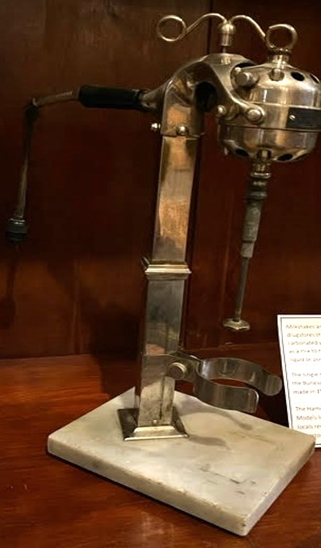
At first glance, this object may seem like no more than a metal bucket with a peculiar lid. This artifact, however, is a descendant of a key piece of culinary history. It is an antique ice cream mixer from the 1940s-1950s. In fact, the museum houses a few other ice cream related artifacts including a 1915 single stem malt milk mixer used in the local Burleson’s drugstore and a 1950s milkshake machine!
Today, most of us enjoy our ice cream ready-made, purchasing it from local grocers or ice cream parlors, but this is a modern luxury.
Until the mid-1800s ice cream was reserved as a treat for the wealthy who could afford private cooks and ice houses. The first step towards more people being able to enjoy this dessert was in 1718 when Mary Eales published the first English cookbook with an ice cream recipe.
But it wasn’t until 1843 when American Nancy Johnson patented the first hand-cranked ice cream mixer that this frozen treat could truly be enjoyed by the masses. Her invention was called the “Artificial Freezer.” It was a wooden tub that contained salt and ice fitted with a hand crank and paddles. This meant that when cream was added, it could be churned whilst being cooled.
This small, home cook friendly invention made the production of ice cream accessible to ordinary people, who if they were willing to use a bit of muscle, would be rewarded with a sweet dessert.
It is a testament to Johnson’s ingenuity that hand cranked ice cream machines continued on even a century later as is evidenced by the ice cream mixer housed at Riverton Museum. Even modern electric ice cream makers still use the same principles as Johnson’s creation.
Another key development in the history of ice cream was the ice cream cone. You can thank one Agnes Marshall for that sweet invention. Marshall, a Victorian culinary pioneer, often referred to as the “Queen of Ices,” founded a culinary school in London and wrote many cookbooks. She created molds and appliances that made frozen treats accessible to a wider variety of people. Her invention of the ice cream cone is attributed to her 1888 cookbook which is the first mention that ice cream could be enjoyed “on the go” with the use of a baked cone.
So, come check out these relics of the culinary past. The milkshake machine and single stem malt mixer are currently on display at Riverton Museum. And to all you ice cream lovers, next time you find yourself enjoying an ice cream (cone or otherwise) consider saying a thank you to these innovative women who democratized this sweet treat for the masses.
Next up for the Fremont County Museum
October 15, 6pm at the Riverton Museum, “Fremont Haunts w/Alma Law” Wyoming Community Bank Discovery Speakers Series
October 17 & 18, 6-9pm at the Pioneer Museum, “Halloween Night at the Museum” Bailey Tire/Pit Stop Children’s Exploration Series
October 18, 5:30 with the Riverton Museum, “Downtown Riverton Haunted Trek” Wind River Visitors Council Adventure Trek Series
October 24 & 25, 11am at the Dubois Museum, “Kids Corner: Spooky Halloween Characters” Bailey Tire/Pit Stop Children’s Exploration Series
October 25, 2pm at the Riverton Museum, “Fall Fun Fest”
October 25, 3pm at the Dubois Museum, “Annual Halloween Carnival
Thru December, 9-5 at the Riverton Museum, “History Day Exhibits” Shoshone Schools
Call the Dubois Museum 1-307-455-2284, the Pioneer Museum 1-307-332-3339 or the Riverton Museum 1-307-856-2665 for detail regarding their programs.
The Dubois Museum, the Pioneer Museum in Lander and the Riverton Museum need your financial support. In the current economic environment, the museums are more reliant than ever on donations from the private sector to continue to provide the quality programs, collections management, exhibits and services that have become their hallmark over the last four years. Please make your tax deductible contribution through the Wind River Cultural Centers Foundation www.windriverccf.com or by sending a check to Fremont County Museums 450 N 2nd Rm 320 or taking it directly to the museum you choose to support.
October 7, 2025
Riverton Museum Presents “Bittersweet Harvest: The Bracero Project, 1942–1964”
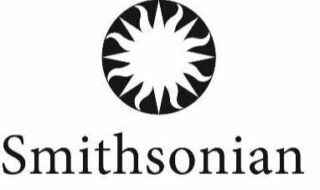
Riverton Museum is proud to announce the opening of Bittersweet Harvest: The Bracero Project, 1942–1964, a compelling exhibition that sheds light on a little-known chapter of American history. The exhibition will be on view at the museum from October 1 through March 31.
Through six interpretive posters featuring historic photographs by Leonard Nadal, Bittersweet Harvest explores the Bracero Program, which from 1942 to 1964 brought millions of Mexican laborers to the United States. Launched during World War II to address labor shortages, the program made significant contributions to American agriculture and industry, while also raising complex questions about immigration, labor rights, and cultural exchange.
“This exhibition offers an important opportunity to reflect on the contributions and experiences of Mexican workers whose labor supported the nation during a critical period,” said site manager April Peregoy. “The story of the Bracero Program is as relevant today as it was decades ago, inviting us to consider ongoing conversations about migration, labor, and identity.”
Bittersweet Harvest: The Bracero Program was organized by the Smithsonian’s National Museum of American History in partnership with the Smithsonian Institution Traveling Exhibition Service (SITES). The exhibition received federal support from the Latino Initiatives Pool, administered by the Smithsonian Latino Center.
October 3, 2025
“Central City: A Wyoming Town Lost to Time”
Central City, Wyoming is a town lost to time. A name certainly not known, it was once the rival to the town of Riverton when lands were ceded from the Wind River Reservation.
The year of 1906 was quite an eventful one, with the railroad activity and opportunities for settlers to come and claim land under homestead rights. Alongside this, new towns came into being like Hudson and Shoshoni. In August of 1906, we see first mention of a possible townsite at the Big Bend of the Wind River as C.H. King received permission from the Department of the Interior to build a storefront in this area, as Mr. King had been setting up stores in tandem with railroad development across the state, including in Casper and Shoshoni.
Mr. King was far from the only person trying to capitalize on this area. A group of men in Lander came together to create a new company they called the “Lander Locating Company”, whose goal was to help settlers locate land claims that they noted could be irrigated by private enterprise. E. J. Farlow was the president of this group, with Roy McAdams as the secretary and also Newton H. Brown, Robert H. Hall, R. F. Webster, Tom Gray and Guy Higby. McAdams, Brown, and Hall all had experience in surveying land.
At nearly the same time, a man named Forest M. Gill and several others put in a petition to the Interior Department to request that 160 acres be set aside for the purpose of a townsite, under the law at the time known as ‘squatter’s rights’, and a portion of land near the Wind River was withdrawn to be set aside for a townsite, near the big bend of the Wind River. Mr. Gill lived in Shoshoni, and ran a newspaper there known as the Shoshoni Gazette and the other petitioners were not named, though likely Shoshoni residents as well.
Alongside the opening of the Reservation lands and the excitement of the potentials, it was uncovered that the state had contracted with a company backed by Chicago businessmen to build a system of irrigation to which they were going to require settlers to use as they would not give permits to irrigate from the Wind River to settlers themselves. The businessmen (incidentally, two men of the Morton family, of the salt empire) and state officials involved were seen by many as being a large impediment to any new potential settlers and infringing on their rights to irrigate their lands as they saw fit. This was reflected in the different groups vying to build a new town at the government given townsite.
The opening day, August 15th, drew in people excited for a chance to get a claim of land, as the day was for the lottery drawing of who could get first claims. There was also some confusion as to when people could actually go onto the land to locate a claim, either on opening day or if they had to observe the 60-day rule from the President’s proclamation. Since the land was also on the Reservation, Indian agent Major Wadsworth had to request clarification from his superiors on if he still needed to patrol and keep anyone without a permit off Reservation land.
Unfortunately, since there was confusion over this, many people did in fact go over to the area of the new townsite the day of August 15th in an attempt to stake out a town lot claim (or two). Some people banded together, there was mention in the newspapers of surveyors assisting, and cars and horses were on hand to help settlers rush lots. All of these people thought that they could, under squatter’s rights, be legally able to start claiming lots. Around 500-600 or so people met near the new townsite the evening of August 14th and took a vote on how to best proceed with lot claiming, with E. H. Rathbone, another newspaperman, leading the meeting alongside Newton Brown. The article in the Clipper about the incident notes that the Shoshoni group that had petitioned the government for the townsite tried to state that they deserved the chance to pick lots first, but were promptly denied by the rest of the people there. The votes were instead in favor of a lottery system like the land opening, with everyone coming back at 9:00 in the morning of August 15th. Before this could happen, some people snuck out in cover of darkness and staked lots, and by the time the morning came the troops from Fort Washakie had arrived to clear the land per Major Wadsworth, with orders from Washington, D.C. stating that they must wait until October 15th. The soldiers from Fort Washakie and even the militia from Lander were over in the area of the new townsite for several days, while trying to ascertain who had jurisdiction of the area, be it state, county, or federal.
As arguments over when people could claim lots, how many they could claim, and how to hold them started becoming larger issues, it grew into two camps of people. On one side, the petitioners with F.M. Gill who were working towards the Riverton Townsite, and on the other were a group trying to vie for a Central City townsite, a separately platted townsite from Riverton but in the same area laid out by the federal government.
Tensions ran somewhat high between the two groups, with Lander newspapers generally calling the townsite ‘Central City’, noting people who were going over and setting up stores while things developed. The Riverton group was doing the same, and everyone was trying to maintain control over their lots with temporary shelters, tents, or actual buildings. Tensions could and did spill over into the different newspapers of the area, with the Wind River Mountaineer and the Shoshoni Gazette in particular exchanging words or accusations against each other. This was greatly apparent in one issue of the Wind River Mountaineer from August 24th, 1906; while arguing when it can legally be settled before October 15th, who has legal jurisdiction (federal vs county), the newspaper was calling some people ‘lot jumpers’ as people were vying for plots and contesting who has entitlement to them. Same newspaper states after people were cleared out by the troops on the 15th, a group from Shoshoni came in and set up a townsite group of elected officers and were drafting certificates for the lots to be handed out. Since the contingency of the Central City people had returned to Lander, they were unaware of this at the time and were upset to see another group trying to gain an upper hand without their input.
This progressed into the group backing Central City to ask a local judge, Judge C. E. Carpenter, to become the trustee for Central City and petition on their behalf for a patent in order to get Central City officially and legally recognized. This eventually led to litigation in October, with P.B. Coolidge representing the Riverton townsite and L.E. Winslow the opposing townsite of Central City, for permission of the Riverton Townsite to incorporate. Ultimately, the Riverton Townsite was able to apply for incorporation in October of 1906.
Riverton was incorporated and elected its first town officers in November, with W. E. Young elected as the first mayor of the town, and the first order of business was straightening out the ownership of town lots. There was still litigation over this, and Young applied for proof on the townsite in March of 1907. The official patent for the town came in August of 1907, and the townspeople could apply for deeds a year after the patent was issued.
Central City ultimately became not a town of its own, but merely a distant memory that is mostly forgotten.
Next up for the Fremont County Museum
Oct 4, 6pm at the Lander Community Center, “Rare Relics Roadshow” Wind River Cultural Centers Foundation
October 15, 6pm at the Riverton Museum, “Fremont Haunts w/Alma Law” Wyoming Community Bank Discovery Speakers Series
October 17 & 18, 6-9pm at the Pioneer Museum, “Halloween Night at the Museum” Bailey Tire/Pit Stop Children’s Exploration Series
October 18, 5:30 with the Riverton Museum, “Downtown Riverton Haunted Trek” Wind River Visitors Council Adventure Trek Series
October 24 & 25, 11am at the Dubois Museum, “Kids Corner: Spooky Halloween Characters” Bailey Tire/Pit Stop Children’s Exploration Series
October 25, 2pm at the Riverton Museum, “Fall Fun Fest”
October 25, 3pm at the Dubois Museum, “Annual Halloween Carnival
Thru December, 9-5 at the Riverton Museum, “History Day Exhibits” Shoshone Schools
Call the Dubois Museum 1-307-455-2284, the Pioneer Museum 1-307-332-3339 or the Riverton Museum 1-307-856-2665 for detail regarding their programs.
The Dubois Museum, the Pioneer Museum in Lander and the Riverton Museum need your financial support. In the current economic environment, the museums are more reliant than ever on donations from the private sector to continue to provide the quality programs, collections management, exhibits and services that have become their hallmark over the last four years. Please make your tax deductible contribution through the Wind River Cultural Centers Foundation www.windriverccf.com or by sending a check to Fremont County Museums 450 N 2nd Rm 320 or taking it directly to the museum you choose to support.
September 30, 2025
Episode 2 Season 2 of ReDiscover the Winds podcast: “The Railroad in Fremont County”
September 26, 2025
“Feast to Flock” This weeks #lookback
With Thanksgiving just around the corner, the nation’s attention turns—as it has for more than a century—to one dish that symbolizes the holiday more than any other: the turkey. Whether roasted, stuffed, or smoked, the bird has become so deeply tied to Thanksgiving that many Americans can scarcely imagine the meal without it.
Yet the turkey’s rise from wild game to centerpiece of the nation’s holiday table is a story of both tradition and innovation. Native peoples were the first to hunt and domesticate the wild turkey, long before Europeans arrived. Spanish explorers carried the bird back to Europe in the 1500s, where it was further domesticated and eventually returned to North America with settlers.
For centuries, turkeys remained semi-wild, raised on open range farms for local consumption. That began to change in the early 20th century. With the invention of the incubator and the development of new breeds—such as the Broad Breasted Bronze—the commercial turkey industry took off. Thanksgiving itself played a central role in this boom. Declared a national holiday by Abraham Lincoln in 1863, it soon became synonymous with images of golden-roasted turkeys, cementing the bird’s place on the American table. By the 1920s, the turkey market revolved almost entirely around the holiday season.
Here in Fremont County, the 1920s also marked the start of an ambitious local experiment to turn Wyoming into a turkey powerhouse.
In February 1926, Riverton turkey producer Mabel Piggott declared boldly in The Riverton Chronicle:
“Wyoming can and will be one of the largest turkey producing states in the Union, and the Riverton Valley with its wonderful climate, its clear running water, the dry atmosphere, abundant sunshine, and its fine fields of growing grain and alfalfa, is an ideal range for turkeys.”
Piggott had started modestly in 1918 with three hens and a tom. By her second season, she was convinced of the bird’s potential. “I could have sold five times as many had I had them,” she wrote.
Her enthusiasm reflected a wider local movement. In 1925, Fremont County turkey growers formed the Wind River Cooperative Market Association, modeled after the state’s livestock associations. The cooperative united producers from Riverton, Lander, Hudson, Arapahoe, Shoshoni, Dubois, and Sweetwater, allowing them to market their birds together and secure better prices. By Christmas of that year, more than 140 growers had signed on.
The strategy worked. Buyers competed for Wind River turkeys, and prices reached record highs. County agent T.S. Brown predicted even greater success, announcing a five-year program to improve flocks and boost production. He foresaw a jump from five to twelve railroad cars of turkeys shipped in 1926, with each car worth some $7,000—a tidy profit for local families.
By 1927, turkey raising had spread to 400 producers across the county. Interestingly, the work was often considered “women’s business,” a side income managed by wives alongside their husbands’ grain and alfalfa harvests. That same year, Riverton hosted a milestone event: a turkey show at the Tonkin schoolhouse. It was the first such exhibition not just in Wyoming, but the first in the Rocky Mountain region, and only the second in the entire nation. University of Wyoming extension agents judged birds and held programs on breeding, raising, and marketing.
Pictured from left are Joe Vincent, Evelyn, and Margaret Lawer with their mother’s (June) turkeys on Jackson Street in Riverton (near the current grade school) in 1928.
For a moment, it seemed Fremont County might indeed become a national turkey hub.
But the promise was short-lived. By the late 1920s, southern states with longer growing seasons and easier access to markets began to dominate. Overproduction drove down prices, and Wyoming’s distance from major buyers proved costly. By the early 1930s, enthusiasm dwindled and the Wind River Cooperative Market Association faded away.
While commercial turkey farming never took root in Wyoming, the bird found a different niche in the state’s story. In 1935, the Wyoming Game and Fish Department introduced wild turkeys into the state. The experiment flourished, and today turkey hunting is a thriving tradition. Thousands of licenses are issued each year, turning the once-domesticated dream of Fremont County into a modern conservation success.
So as families gather around their Thanksgiving tables this year, carving the bird that has become the holiday’s hallmark, it is worth remembering that nearly a century ago, Fremont County once dreamed of leading the nation’s turkey trade. Though the boom went bust, the legacy of that bold experiment still lingers—in old newspaper clippings, family memories, and the wild gobbles echoing across Wyoming’s hills.
By April Peregoy: Riverton Museum
Next up for the Fremont County Museum
September 27,10:30am at the Dubois Museum, “Kids Corner: Cyanotype Print Making” Bailey Tire/Pit Stop Children’s Exploration Series
October 2, 6pm at the Riverton Museum, “Riverton in Color: The Art of Dan Weeks”
Oct 4, TBA at the Lander Community Center, “Rare Relics Roadshow” Wind River Cultural Centers Foundation
October 15, 6pm at the Riverton Museum, “Fremont Haunts w/Alma Law” Wyoming Community Bank Discovery Speakers Series
October 17 & 18, 6-9pm at the Pioneer Museum, “Halloween Night at the Museum” Bailey Tire/Pit Stop Children’s Exploration Series
October 18, 5:30 with the Riverton Museum, “Downtown Riverton Haunted Trek” Wind River Visitors Council Adventure Trek Series
October 24 & 25, 11am at the Dubois Museum, “Kids Corner: Spooky Halloween Characters” Bailey Tire/Pit Stop Children’s Exploration Series
October 25, 2pm at the Riverton Museum, “Fall Fun Fest”
October 25, 3pm at the Dubois Museum, “Annual Halloween Carnival
Thru December, 9-5 at the Riverton Museum, “History Day Exhibits” Shoshone Schools
Call the Dubois Museum 1-307-455-2284, the Pioneer Museum 1-307-332-3339 or the Riverton Museum 1-307-856-2665 for detail regarding their programs.
The Dubois Museum, the Pioneer Museum in Lander and the Riverton Museum need your financial support. In the current economic environment, the museums are more reliant than ever on donations from the private sector to continue to provide the quality programs, collections management, exhibits and services that have become their hallmark over the last four years. Please make your tax deductible contribution through the Wind River Cultural Centers Foundation www.windriverccf.com or by sending a check to Fremont County Museums 450 N 2nd Rm 320 or taking it directly to the museum you choose to support.
September 23, 2025
Fremont County Museums Wins Wyoming Historical Society Award
The WHS Annual 1st Place Award for Website goes to the Fremont County Museums, which include the Dubois, Lander, and Riverton museums. These museums are dedicated to preserving their rich history and sharing it with future generations. They invite you to visit their museums or join one of their many exciting programs.
Their programs include the Children's Exploration Series, Adventure Treks, Discovery Speakers, and Historic Building Walking Tours.
We were impressed by the website's attractive design, featuring their eye-catching logo and stunning photos of local historic sites. The site is user-friendly and encourages visitors to sign up for programs at any of their museums. https://fremontcountymuseums.com/
Well done, Fremont County Museums! Congratulations!
September 22, 2025
Wind River Country History: Riverton Tour Officially Open
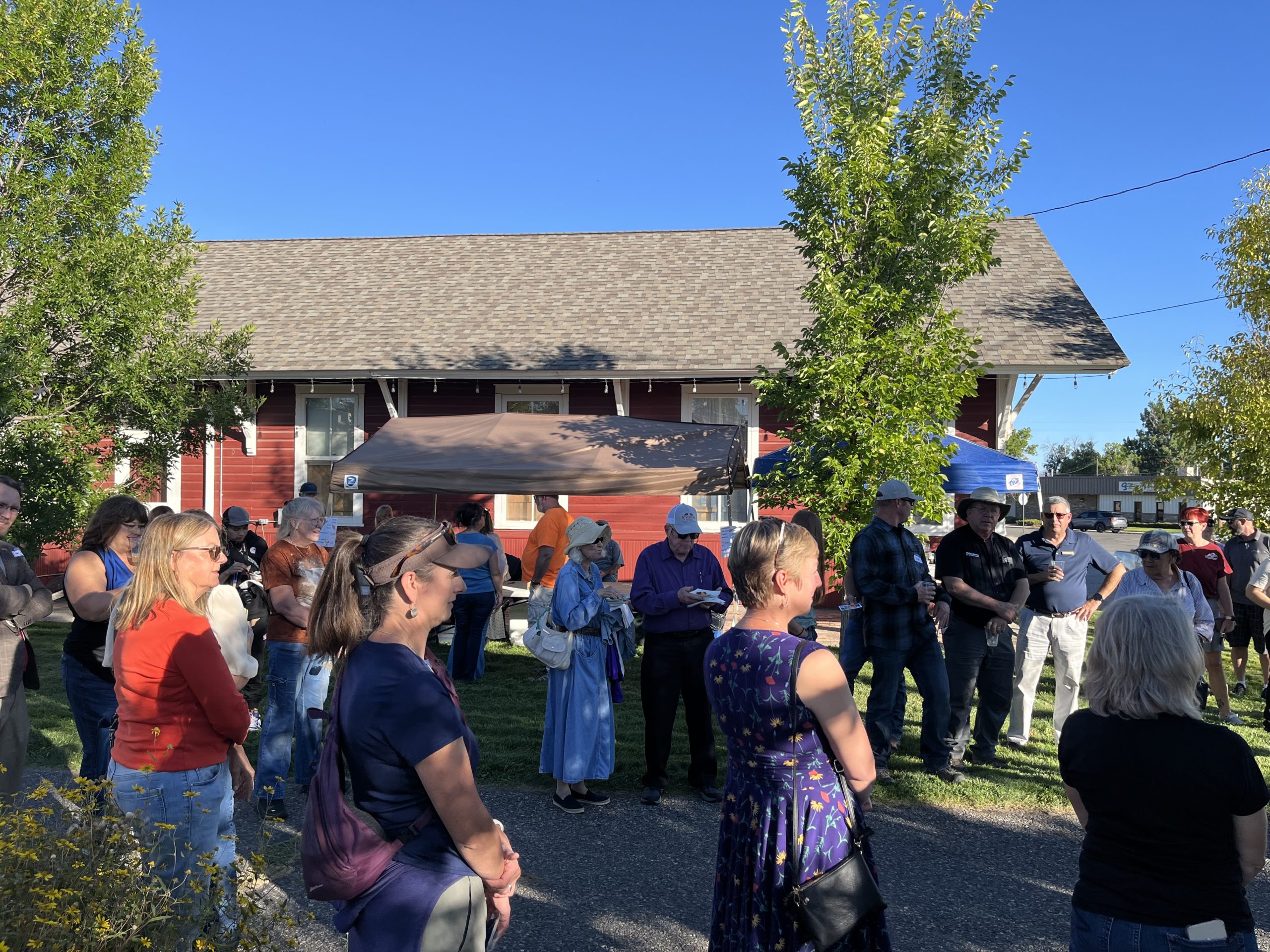
The Wind River Country History: Riverton Tour had its official opening on September 18th. A ribbon cutting ceremony unveiled new interpretative signage that has been placed (and will continue to be installed) along the Wyoming Heritage Trail and Riverwalk.
Riverton Museum, one of the sponsors for the project, contributed photographs and information for the signs as well as the companion audio tour.
The trail itself is the former site of the Chicago and Northwestern railroad that once ran from Casper to Lander. Hence the trail’s other name “Rails to Trails.” A 22-mile section of the railroad from Riverton to Shoshoni was preserved as a walking trail after the railroad ceased operations in the 1980s.
This addition to the trail will allow tourists and locals alike to connect to and learn about Riverton’s history. There is much on offer as the tour covers a variety of topics including natural history, paleontology, tribal histories, homesteading, and industry in the area.
“We greatly appreciate Cathy Cline asking us to be a part of this huge undertaking” said Anne Gebo, program coordinator at Riverton Museum. “It is wonderful to be able to participate in a project with so many other cultural and historical institutions. These signs will help keep alive and relevant the stories of Riverton and the Wind River area for many years to come.”
September 19, 2025
Hailey Reddon Accepted into Leadership Fremont County 2025-26 Class
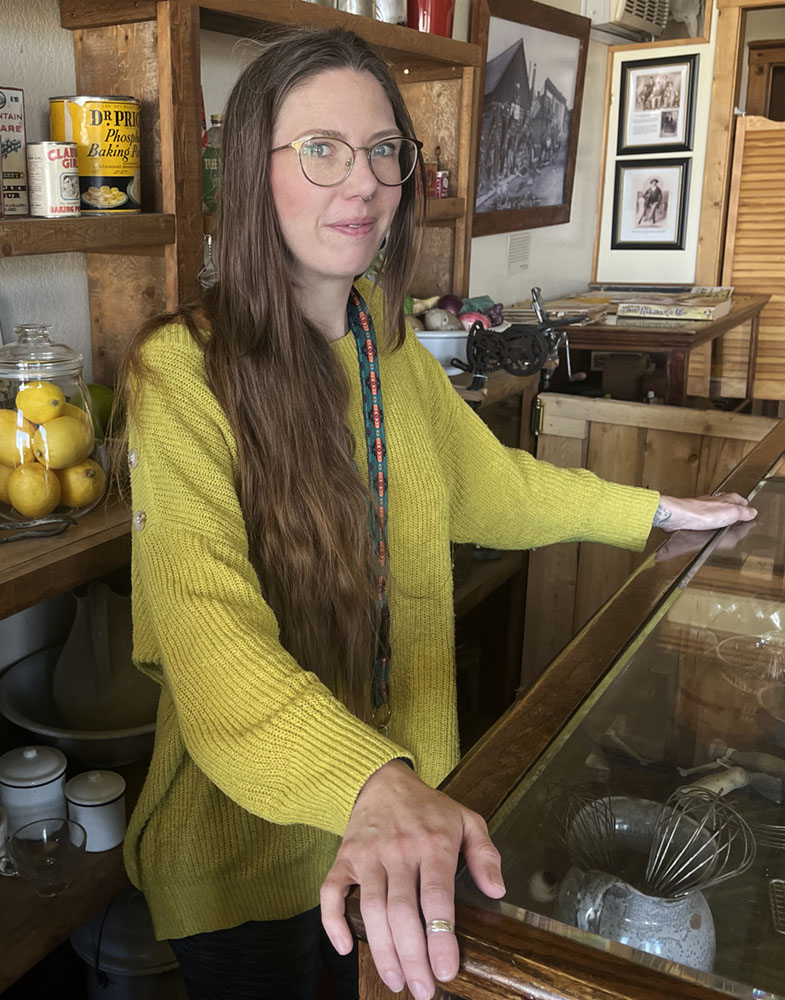
Congratulations to the Pioneer Museum’s Programs/Education Coordinator Hailey Reddon! Hailey has been accepted into this year’s class of Leadership Fremont County.
Leadership Fremont County began in 2003, started jointly by the Lander and Riverton Chambers of Commerce. The Mission of Leadership Fremont County is to provide leaders who are committed to excellence and progress in Fremont County the opportunity to better understand the general public policy issues, economic and social diversity and the challenges facing our county; and to prepare them, through shared mutual interests and the leadership skills developed, to be active in building a better Fremont County.
“In this role, I am hoping to connect with our local community and provide a sense of pride in our rich cultural heritage,” said Hailey. “By participating in the Leadership Fremont County training, I will gain a better understanding of engaging as a leader with confidence to provide for local visitors, and providing a better experience for tourism to help bolster our local economy.
“By participating in this excellent training, I will be able to emerge confident in leadership skills that will further the Fremont County Museums mission of relation building and community engagement. I am very grateful to be able to attend this training on behalf of the museum and look forward to utilizing the skills to enhance every visitor’s experience.”
September 15, 2025
Jami Cannon Colorado-Wyoming Digital Collections Stewardship Cohort for 2025-26
Fremont County Museum is proud to announce that Jami Cannon, Collections Manager for the Riverton Museum, has been accepted into the Colorado-Wyoming Digital Collections Stewardship Cohort for 2025-26. This is a distinguished program that supports and advances the skills of digital collections professionals across the Colorado and Wyoming region.
Through this cohort, Jami will engage in eight months of intensive learning, peer collaboration, and professional development focused on current best practices in digital stewardship. This includes topics such as metadata standards, preservation workflows, digitization techniques, digital accessibility, and sustainable management of digital assets. Participation in the cohort underscores Riverton Museum’s commitment to ensuring that our collections are preserved, accessible, and usable for future generations.
“I am honored to be selected for this cohort,” said Jami. “This opportunity will allow me to deepen my expertise and bring new approaches to the museum, ultimately benefiting our patrons, researchers, and the larger community.”
The Colorado-Wyoming Digital Collections Stewardship Cohort is a collaborative program for staff at libraries, museums, archives, and historical societies who want to develop skills in managing and preserving digital collections. The program is led by the Colorado State Library (CSL) and the Wyoming State Library (WSL) in partnership with OCLC/WebJunction. It is designed specifically for the needs of smaller cultural institutions.
September 12, 2025
Archaeology Awareness Month
September in Wyoming is Archaeology Awareness Month. Wyoming has both the Wyoming Association of Professional Archaeologists and the Wyoming Archaeological Society, and the Archaeology Fair will be held at the Wyoming Territorial Prison State Historic Site this September 13th. The Office of the Wyoming State Archaeologist has conducted over 3,000 cultural resource investigations since 1973. Every year, they perform on average 60 surveys, five test excavations, and one large scale excavation.
The National Register of Historic Places recognizes properties which are significant to local, state and national history. Fremont County has several sites listed through the registry, one of which includes the Helen Lookingbill Site. In 1968, Helen Lookingbill and her husband Art discovered the site at their hunting camp in the Absaroka Mountains near Dubois. She had belonged to the Archaeological Club and had discovered a few projectile points in the elk footprints from the elk who had passed through their hunting camp. The next year, she showed the points to Dr. George Frison, former Wyoming State Archaeologist. The famous archaeologist and father of Wyoming archaeology noticed unusual qualities about the points and would begin excavating the site in 1972. He found that the site was a stratified open-air prehistoric campsite that had been occupied for many centuries.
Helen Lookingbill (1913-1994)
It is estimated that the Lookingbill site was reoccupied repeatedly over the course of 12,500 years from the late Paleoindian to the Late Prehistoric. Over 125,000 prehistoric artifacts were obtained, and the site yielded one of the largest samples of Early Plains Archaic side-notched points in the Central Rocky Mountains. This and other high-altitude signs have helped answer questions concerning human occupation during the Pleistocene and late Holocene. The site contains the remains of many animals, and quartzite and chert stone tools.
The use of x-ray fluorescence spectroscopy helped determine four obsidian sources located west and northwest of the site. Such findings help archaeologists get a better understanding of the influences and distribution of obsidian. Research also provided a better understanding of the nature of the site occupation, regional cultural dynamics, and high-altitude hunter-gather adaptations.
Sites in Fremont County include both historic and prehistoric sites. Bison jumps, bighorn sheep traps, petroglyphs and other ancient cultural sites can be found throughout the county at all elevations. More information can be found at the Fremont County Museums in Lander, Riverton and Dubois. The museums work with the state and federal agencies to inform the public, but to also protect these important sites.
Next up for the Fremont County Museum
September 13, 9am with the Riverton Museum, “Gas Hills Uranium Trek” Wind River Visitors Council Adventure Trek Series
September 13, 1-3pm at the Pioneer Museum, “Apple Fest”
September 19, 7pm at the Dubois Museum, “Lunar Eclipse with Astronomer Tom Herret” Wyoming Community Bank Discovery Speakers Series
September 20, 9am with the Riverton Museum, “Sinks Canyon Cave Tour” Wind River Visitors Council Adventure Trek Series
September 20, 1pm at the Pioneer Museum, “Adult Pioneer Craft”
September 27,10:30am at the Dubois Museum, “Kids Corner: Cyanotype Print Making” Bailey Tire/Pit Stop Children’s Exploration Series
Now thru December, 9-5 at the Riverton Museum, “History Day Exhibits” Shoshone Schools
Oct 4, TBA at the Lander Community Center, “Rare Relics Roadshow” Wind River Cultural Centers Foundation
Call the Dubois Museum 1-307-455-2284, the Pioneer Museum 1-307-332-3339 or the Riverton Museum 1-307-856-2665 for detail regarding their programs.
The Dubois Museum, the Pioneer Museum in Lander and the Riverton Museum need your financial support. In the current economic environment, the museums are more reliant than ever on donations from the private sector to continue to provide the quality programs, collections management, exhibits and services that have become their hallmark over the last four years. Please make your tax deductible contribution through the Wind River Cultural Centers Foundation www.windriverccf.com or by sending a check to Fremont County Museums 450 N 2nd Rm 320 or taking it directly to the museum you choose to support.
September 9, 2025
Rare Relics Roadshow Tickets Available
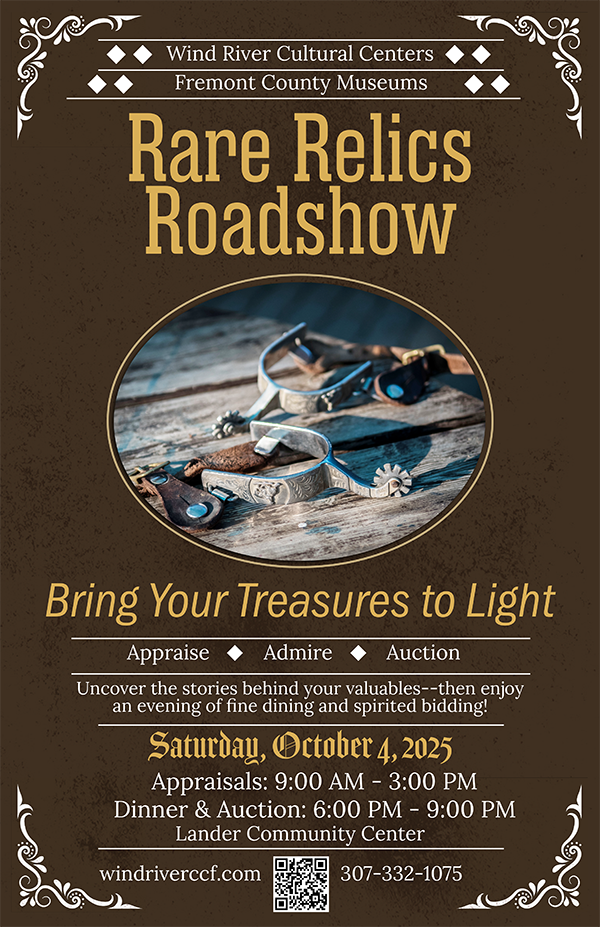
The Wind River Cultural Centers Foundation is hosting the inaugural Rare Relics Road Show on October 4th. Dinner will begin at 6pm with the silent and live auctions to follow. Enjoy seeing the antiques and learn about their appraisals. Proceeds benefit Fremont County Museums (Dubois Museum, Pioneer Museum and Riverton Museum). Tickets are available on-line at https://www.flipcause.com/secure/event_step2/MjMyNTcz/308400
September 5, 2025
#Lookback from the Pioneer Museum, “Edith Nickerson”
September 2, 2025
Dedications and Memorials Available for Supports of Each Museum
The Dubois Museum, Pioneer Museum in Lander and the Riverton Museum each have opportunities to show your support for the Museum and memorialize someone important to you.
Benches and shrubs are just two of the items that can be dedicated in memory to a loved one. Contact the museum you support to find out all of the options available.
Dubois Museum: 307-455-2284
Pioneer Museum: 307-332-3373
Riverton Museum: 307-856-2665
August 27, 2025
Season 2 Episode 1, “Aviation in Riverton” ReDiscover The Winds Podcast
August 22, 2025
Seipt House
Seipt House
On the Dubois Museum grounds sits a log home that was built by Henry Seipt from around the time that the town of Dubois was incorporated in 1914. As described in the 1914 Wyoming State Journal, the “log bungalow, seven rooms in size and of pleasing exterior; located on First Street north of Main Street, commanding a beautiful view of Horse Creek Valley.” The house was built across the street from the Legion Hall.
Henry (Dutch) M. Seipt, Sr. was a naturalized German immigrant born in 1876. He served in the Spanish-American War in 1898. After the war, he arrived in Wyoming in 1899 to serve in the cavalry at Fort Washakie. After his release in 1902, he went to work for Charlie Moore who had been operating out of Fort Washakie. Moore later opened a dude outfit near Dubois. Seipt worked as a hunting guide for Moore for nearly ten years. Beginning in 1904, he began working a gold claim on Horse Creek which he had attempted to mine, but there was not enough gold for a commercial operation. While living in Dubois, he met Ora Jones who had received her teaching certificate in 1912 and began teaching in Lenore (Fremont County) that year. She married Henry in 1913 and moved to Dubois where she taught school, and he opened a blacksmith shop. The shop was located between what is today the St. Thomas Episcopal Church and the V.F.W.
In late 1918, Dutch filed for an abandoned homestead claim located north of Dubois near Horse Creek. After the claim was granted, he, along with Ora and their two children, left Dubois and moved onto the site. They lived temporarily in a tent until a log building could be built. Over the next several years, they developed the Hermitage Ranch, one of the earliest dude ranches around Dubois, which continues to operate to this day as the T-Cross Ranch.
In 1919, the Seipts sold the original log home to Judge John Hanscum. John Hanscum was born in Oswego, New York in 1868. He moved to Wyoming in 1893 and accepted a position as clerk for J.K. Moore who was the post trader at Fort Washakie. In 1899, John purchased the Washakie Hotel and Livery Bar which included the stage line from Fort Washakie to Dubois. He managed the Dubois Mercantile from 1917 to 1920. He then served as the head bookkeeper for the Wyoming Tie and Timber company until 1925. The Hanscums had the house moved 20 feet west from the original spot and remained at that location. John Hanscum passed away in 1929, and the 1932 Commissioner Record noted that the property was sold to his son, Charles, in 1932. The house was sold in 1945 to the Harold and Venus Hickerson. After a few years, it was sold to the Gyer family who had bought the Dubois Mercantile Store.
By 1998, the house was relocated from what would become Lamb Park and moved to the Dubois Museum as a historic home and used as the museum’s Buckman Education and Resource Center. For a brief period, the upper floor was rented as a private residence to generate income for the museum. Today, the house is used to store the museum collection and archive. The three-sided porch was original to the house. The building has stacked log walls with daubing and has post corners at the four main corners. The dormer windows on the second floor were not original. The interior of the building still contains certain elements of the original structure, but the house was modified many times over the past decades. The building originally had two chimneys which were removed over time.
Next up for the Fremont County Museum
August 30, 7am with the Riverton Museum, “Midvale Irrigation District” Wind River Visitors Council Adventure Trek Series
September 6, 10am with the Pioneer Museum, “Red Canyon Petroglyphs Trek” Wind River Visitors Council Adventure Trek Series
September 6, 9am with the Riverton Museum, “J.B. Okie Manor Trek” Wind River Visitors Council Adventure Trek Series
September 10, 6pm at the Riverton Museum, “Murdered and Missing Indigenous Women By Sophie Barksdale” Wyoming Community Bank Discovery Speakers Series
September 13, 9am with the Riverton Museum, “Gas Hills Uranium Trek” Wind River Visitors Council Adventure Trek Series
September 13, 1-3pm at the Pioneer Museum, “Apple Fest”
September 19, 7pm at the Dubois Museum, “Lunar Eclipse with Astronomer Tom Herret” Wyoming Community Bank Discovery Speakers Series
Now thru December, 9-5 at the Riverton Museum, “History Day Exhibits” Shoshone Schools
Oct 4, TBA at the Lander Community Center, “Rare Relics Roadshow” Wind River Cultural Centers Foundation
Call the Dubois Museum 1-307-455-2284, the Pioneer Museum 1-307-332-3339 or the Riverton Museum 1-307-856-2665 for detail regarding their programs.
The Dubois Museum, the Pioneer Museum in Lander and the Riverton Museum need your financial support. In the current economic environment, the museums are more reliant than ever on donations from the private sector to continue to provide the quality programs, collections management, exhibits and services that have become their hallmark over the last four years. Please make your tax deductible contribution through the Wind River Cultural Centers Foundation www.windriverccf.com or by sending a check to Fremont County Museums 450 N 2nd Rm 320 or taking it directly to the museum you choose to support.
August 15, 2025
John T Huff
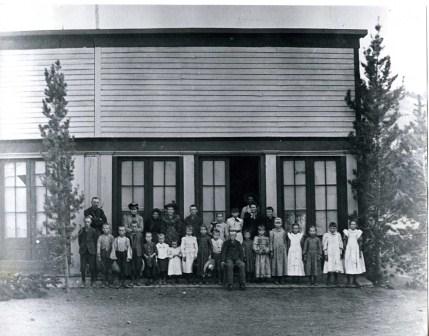
John T. Huff
Photo: The Huff house in Atlantic City
John “Jack” Thomas Huff was born in Waterloo, New York on February 12, 1842 into a patriotic family. His great-grandfather fought in the Revolutionary war, his grandfather fought in the War of 1812, and his father died early in the Civil War. John also fought in the Civil War with the 89th Illinois Infantry before transferring to the First Mississippi Marine and fought at the Battle of Vicksburg. He was also present at the Red River Expedition, which was the last Confederate victory of the Civil War. After the Civil War, John found work for the railroad working as a fireman on the trains in Iowa. He then joined the civil service and moved close to Cheyenne to build Camp Carlin. This camp became the second largest U.S. military depot that provided materials and supplies for all the western forts.
When Huff heard of the gold strikes at South Pass, he quickly moved and started his search for gold in 1867 or 1868. The gold rush was on, and he was among the first to make it to the mining district. He headquartered in Atlantic City, opening three gold mines- the Mary Ellen mine, named for his wife and one of his partners’ wives, the Diane mine and finally the Groundhog mine, so named because a groundhog had taken up residence in the mine. Because none of his mines proved to hold a mother-lode, Huff built a waterwheel and operated a stamp mill where gold bearing quartz could be hammered to release the gold held inside. John was a hard worker and tried his hand at many occupations. He ran cattle and sheep to provide meat for the mining camps. A blizzard at nearby Oregon Buttes wiped out his sheep operation, so he opened a sawmill which was powered by a steam boiler that burned as much wood as the lumber it produced. The sawmill however was profitable providing income until the gold boom ended. He also partnered in a brewery which provided ale for the miners. The area where his brewery was located is today known as Beer Garden Gulch.
John married his wife, Ellen McCarthy in 1874. Ellen had been born in New York also, but met her husband in the mining district. She had run away from home at age 11 because of abuse by her father and worked for a family to earn her room and board. She arrived in Atlantic City with this family about 1870 or 1871.
John and his wife opened a hotel called the Chief Hotel in Atlantic City which was mainly operated by his wife and his four daughters. He also opened a candy shop operated by one of his daughters. He tried his hand at homesteading on Big Sandy Flats with three other men, but it failed when they couldn’t get the required irrigation water to the homestead.
The gold rush quickly fizzled at South Pass and people were leaving in search of new opportunities. The county seat was moved from South Pass to Green River, which was another blow to the mining camp businesses.
In 1906 the townsite of Riverton was opened for settlers about the time the railroad arrived. The Huffs decided to try their luck in the new township. The Huffs took up two lots on Main Street about where the Teton Hotel and another where the Conoco Station is located today and opened a business, but John’s wife Ellen died two years later and John lost interest in his business in Riverton. Ellen is buried in Hudson.
John worked for a time at the Pacific Springs ranch for a friend, but finally moved to California to be close to his daughter. He eventually took up residence in the Old Soldier’s Home in Los Angeles, California along with an old mining partner, Buck Gratrix.
John Huff died in 1931 at age 89 in the National Military Home in Los Angeles He is buried in Los Angeles. He was a true pioneer, who worked hard and suffered many hardships, but left his mark on Wyoming.
Next up for the Fremont County Museum
August 20, 6pm at the Riverton Museum, “Coal Camps at Hudson and Gebo” Wyoming Community Bank Discovery Speakers Series
August 30, 7am with the Riverton Museum, “Midvale Irrigation District” Wind River Visitors Council Adventure Trek Series
September 6, 10am with the Pioneer Museum, “Red Canyon Petroglyphs Trek” Wind River Visitors Council Adventure Trek Series
September 6, 9am with the Riverton Museum, “J.B. Okie Manor Trek” Wind River Visitors Council Adventure Trek Series
September 7, 7pm at the Dubois Museum, “Lunar Eclipse with Astronomer Tom Herret” Wyoming Community Bank Discovery Speakers Series
Now thru December, 9-5 at the Riverton Museum, “History Day Exhibits” Shoshone Schools
Oct 4, TBA at the Lander Community Center, “Rare Relics Roadshow” Wind River Cultural Centers Foundation
Call the Dubois Museum 1-307-455-2284, the Pioneer Museum 1-307-332-3339 or the Riverton Museum 1-307-856-2665 for detail regarding their programs.
The Dubois Museum, the Pioneer Museum in Lander and the Riverton Museum need your financial support. In the current economic environment, the museums are more reliant than ever on donations from the private sector to continue to provide the quality programs, collections management, exhibits and services that have become their hallmark over the last four years. Please make your tax deductible contribution through the Wind River Cultural Centers Foundation www.windriverccf.com or by sending a check to Fremont County Museums 450 N 2nd Rm 320 or taking it directly to the museum you choose to support.
August 8, 2025
Fun on the Flume
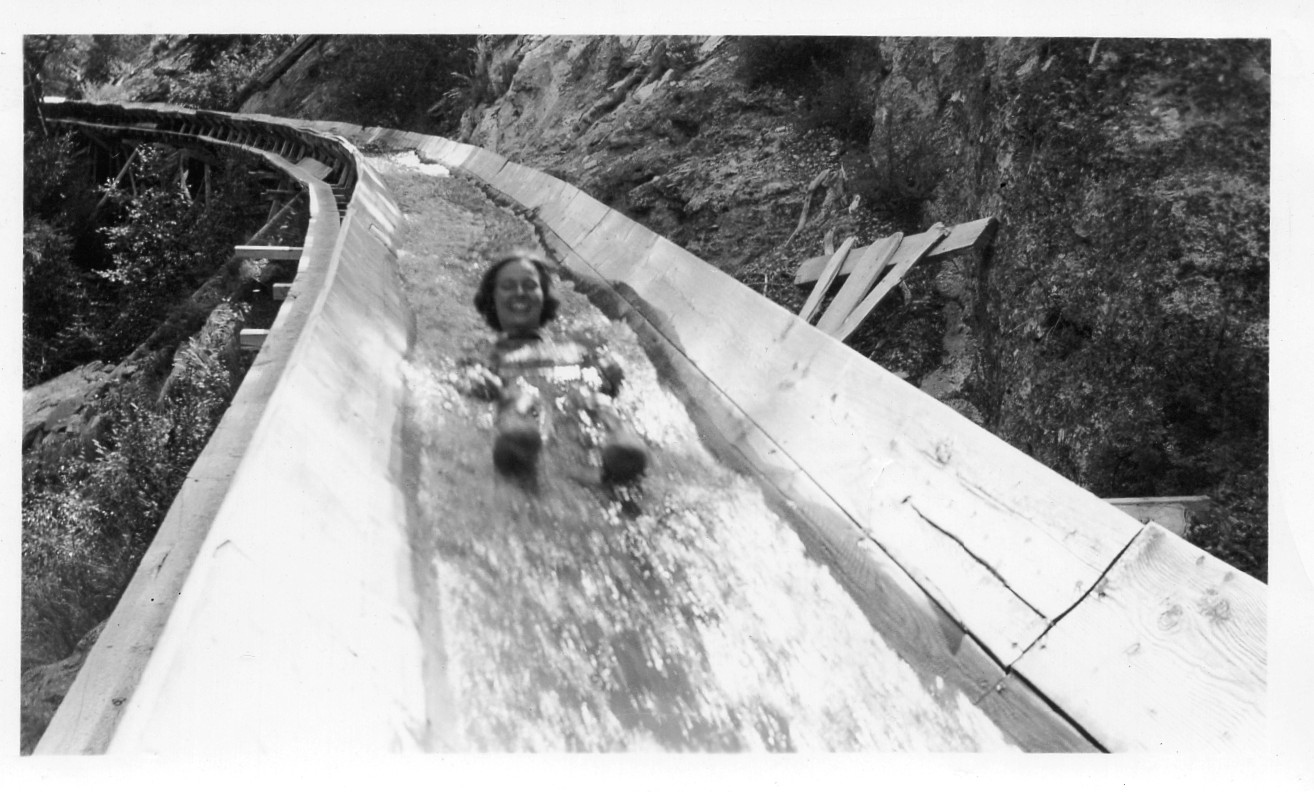
Caption: Peggy Powers riding down a log flume near Dubois, Riverton Museum Archives.
Today, people from all over the world can experience log flume rides at amusement parks. Arguably one of the most famous flume rides is Disneyland’s “Splash Mountain,” recently refurbished to “Tiana’s Bayou Adventure.” This style of ride was created in 1963 by Arrow Development, an engineering and manufacturing company, and was installed in Six Flags Over Texas (Arlington, Texas) amusement park as “El Aserradero.” The ride is still in operation today.
Actual log flumes, though, have been enjoyed by the public long before the 1960s. Log flumes were first developed in 1859 by J. W. Haines. His innovation allowed for timber to be moved more easily through difficult terrain by using a source of flowing water.
“Peggy Powers rides down a log flume near Dubois” is the description on this 1930s-1940s photograph in the Riverton Museum archives. The flume she rode down was part of the technological innovations developed by Martin Olsen and the Wyoming Tie and Timber Company. The Wyoming Tie and Timber Company had been cutting railroad ties out of pine trees in the National Forest. As demand for ties increased, the company looked to expand its operations. In search of more timber, they began to exploit the Union Pass area outside of Dubois.
While this site had ample lumber, it also had a steep canyon that ties would tumble down. This fall would ensure damage to ties. Olsen designed a system of flumes that carried ties from the Union Pass area to the Wind River, avoiding the canyon and utilizing water from the Warm Springs Creek. The flumes were finished in 1928 and spanned over nine miles.
These technological innovations, however, were not just used for tie hacking in Fremont County. Residents like Peggy Powers and Maggie Kahin turned these industrial flumes into a fun ride.
Caption: Maggie Kahin riding down a flume near Dubois; Riverton Museum Archives.
But the flumes weren’t the only thrill. One of the photographs held at the Riverton Museum shows a man giving his infant daughter a ride on a conveyer belt used to move ties from the timber yard to railroad cars.
Next up for the Fremont County Museum
August 7, 6pm at the Dubois Museum, “Bighorn Sheep Bow Making with Tom Lucas” Wyoming Community Bank Discovery Speakers Series
August 10, 6pm at the Dubois Museum, “Music at the Museum: Allan Morton & the Hired Guns”
August 13, 6:30pm at the Pioneer Museum, “Eagle Spirit Dancers”
August 14, 6:30pm at the Pioneer Museum, “What Happened to the Railroad” Wyoming Community Bank Discovery Speakers Series
August 20, 6pm at the Riverton Museum, “Coal Camps at Hudson and Gebo” Wyoming Community Bank Discovery Speakers Series
August 30, 7am with the Riverton Museum, “Midvale Irrigation District” Wind River Visitors Council Adventure Trek Series
Now thru December, 9-5 at the Riverton Museum, “History Day Exhibits” Shoshone Schools
Oct 4, TBA at the Lander Community Center, “Rare Relics Roadshow” Wind River Cultural Centers Foundation
Call the Dubois Museum 1-307-455-2284, the Pioneer Museum 1-307-332-3339 or the Riverton Museum 1-307-856-2665 for detail regarding their programs.
The Dubois Museum, the Pioneer Museum in Lander and the Riverton Museum need your financial support. In the current economic environment, the museums are more reliant than ever on donations from the private sector to continue to provide the quality programs, collections management, exhibits and services that have become their hallmark over the last four years. Please make your tax deductible contribution through the Wind River Cultural Centers Foundation www.windriverccf.com or by sending a check to Fremont County Museums 450 N 2nd Rm 320 or taking it directly to the museum you choose to support.
August 1, 2025
From Forest Reserve to National Forest
National Forests surrounds Fremont County, playing an important role in the life in the Upper Wind River country. Grazing and timber resources support the livestock and timber industries of the area, while wildlife and wilderness continue to provide the basis for recreation and tourism businesses.
President Harrison established the first federal forest lands in 1891, officially designated as “Forest Reserves”. At that time, the forests were understood to be available to everyone, and in 1907, they were officially renamed as the National Forests. This also distinguished between state and federal forests. The Shoshone Forest was established in 1891 as part of the Yellowstone Timberland Reserve, making it the oldest federal forest in the nation. The Wapiti Ranger Station between Cody and Yellowstone is the oldest continuously used U.S. Forest Service station in the United States, starting in 1905. Later, the area was renamed Bonneville National Forest
As the surrounding populations increased due to settlement, additional demand was put on forest personnel. Larger forests were broken down to adjust to the increased staffing demands. On July 1, 1911, the Washakie National Forest was formed from the southern part of the Bonneville National Forest. Its name honored the Shoshone leader, Chief Washakie. By 1916, the western part of the Washakie was added to another forest, while the remaining Bonneville was added to the Washakie National Forest. This allowed all the Wind River drainage to be in the Washakie National Forest. In 1923, Fremont County had four apportionments of the U.S. Forest Reserve Fund which included the Bridger Forest Reserve, Shoshone Forest Reserve, The Teton Forest Reserve and the Washakie Forest Reserve.
The headquarters for the Wind River District of the Shoshone National Forest were first located at the Sheridan Creek Ranger Sation near where Sheridan Creek joins the Wind River 18 miles west of Dubois. The Sheridan District is sixty miles long, and it contains over 375,000 acres. This district was considered prime for railroad tie timber; Jim Stewart and a crew from the Wind River Reservation attempted the first tie drive from Sheridan Creek in 1906. That same year, the first forest ranger arrived in the Dubois area. The Sheridan Ranger Station had a fire lookout station seven miles from the ranger station, with both a tower and a cabin. In 1911, telephone lines connected the ranger station and fire lookout. The cabin pictured was used as a bunkhouse at the site and now sits at the Dubois Museum. It measures seventeen and a half by fifteen and a half feet.
Early forest rangers or guards were charged with protecting vital resources, young men hired by the Forest Service to work the forests out of ranger stations. Life was not easy at these stations. According to A History of the Architecture of the USDA Forest Service written in 1999 for the United States Department of Agriculture, “early Forest Service employees had to rent rooms in town, use abandoned homesteads or camp in tents in the field. The few Government-owned buildings that existed were small, poorly designed by the employees on the ground, and inadequate for conducting day-to-day business.” During the early years, the ranger’s living conditions were described as “primitive,” and the ranger had to pay for their own expenses. In the early years, there was no formal fire detection system and the only training programs for rangers were in Europe.
After 1911, the Forest Service began building lookout towers and fire tool caches. The Dubois Museum features one such fire tool cache. The small steel structure held firefighting tools and were placed in various locations throughout the forests. The general Operations Handbook specified items to be kept in the caches: most usefully, an axe, saw, and shovel. Over time, the number of caches were reduced as tools were kept at the ranger sites, and caches were left at sites where they may not have ever been used. Today, it is unknown how many caches remain.
Next up for the Fremont County Museum
July 31, 9am with the Dubois Museum, “Tie Hack Camp of Union Pass” Wind River Visitor’s Council Adventure Trek Series
August 2, 11am at the Riverton Museum, “Archeology Day” Bailey tire/Pit Stop Children’s Exploration Series
August 6, 7pm at the Pioneer Museum, “Eagle Spirit Dancers”
August 7, 6pm at the Dubois Museum, “Bighorn Sheep Bow Making with Tom Lucas” Wyoming Community Bank Discovery Speakers Series
August 10, 6pm at the Dubois Museum, “Music at the Museum: Allan Morton & the Hired Guns”
August 13, 6:30pm at the Pioneer Museum, “Eagle Spirit Dancers”
Now thru December, 9-5 at the Riverton Museum, “History Day Exhibits” Shoshone Schools
Oct 4, TBA at the Lander Community Center, “Rare Relics Roadshow” Wind River Cultural Centers Foundation
Call the Dubois Museum 1-307-455-2284, the Pioneer Museum 1-307-332-3339 or the Riverton Museum 1-307-856-2665 for detail regarding their programs.
The Dubois Museum, the Pioneer Museum in Lander and the Riverton Museum need your financial support. In the current economic environment, the museums are more reliant than ever on donations from the private sector to continue to provide the quality programs, collections management, exhibits and services that have become their hallmark over the last four years. Please make your tax deductible contribution through the Wind River Cultural Centers Foundation www.windriverccf.com or by sending a check to Fremont County Museums 450 N 2nd Rm 320 or taking it directly to the museum you choose to support.
July 29, 2025
ReDiscover the Winds podcast, “Irrigation in Fremont County”
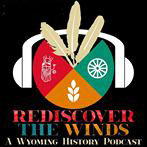
July 28, 2025
Milford, WY

Milford
Over the years, the Lander Valley was comprised of smaller pockets of communities, and one such community was North Fork, later known as Milford. Early settlers to this area included men who traveled to mine first at South Pass, or those that came up with the army to Camp Brown or Fort Washakie, then choosing to homestead and ranch within the valley itself. North Fork, as it was first known, was a community that formed along the North Fork of the Popo Agie river.
The area provided a good place to raise animals and crops, and being near the Reservation and Fort Washakie, but outside its boundary, meant that soldiers could easily come over to patronize the businesses that started to crop up. One of the first people in the area was Hyrum “Hi” Mealman, a man who set up a blacksmith and a log home that served as a stage stop and road house in 1872. Hi also sold land (and also buildings) to several people, including Ed Alton and Ben Sheldon. He also donated land for the first brick school building, built by Charles Harris in 1887. Charles Harris was a stonemason also known to have built several stone buildings out at Fort Washakie as well.
Ed Alton and his wife ran a roadhouse and saloon within the community, and he also served as a Justice of the Peace in 1878 and Postmaster from 1891 until his death, at which time his wife took over as Postmistress until 1901. A note of interest, before the Altons arrived in North Fork, they resided in Piedmont, and Mrs. Alton for a time had hired Calamity Jane as additional help at her roadhouse there. Unfortunately, it did not seem to work out, as Mrs. Alton fired her. Additionally, before they were in Wyoming, they were in Utah for a time and met another gentleman who later relocated to North Fork, Meredith B. Meredith, one of the first Mormon settlers to the area and a man who raised animals and crops such as apples and plums. Mr. Meredith has an interesting note himself, being originally from Wales and finding out later on in life that he and Reverend John Roberts (of the Mission on the Reservation) were both born near to each other in their home country.
Other well-known settlers would be J.K. Moore, who also operated a store in North Fork for a time before moving his operations to Fort Washakie, and Frederick Leseberg, who was a long time settler and rancher who raised cattle, sheep, turkeys, and also had an orchard himself.
Perhaps one of the best known settlers was Asil T. Wilson, known as “Ace”, who came up with the army and worked at the Shoshone agency in 1875, and around 1880 built a three story mill in North Fork called the ‘Northfork Grist Mill’. His family lived in the second story and the mill was run in the bottom half, and he had a pond next to it to help run the mill. This is what gave rise to the name of “Milford” for the community, though you will see notes of Northfork, or even Upper/Lower North Fork, for years afterwards as ranches and homesteads were spread out. Ace also ran sawmills in the area, including Sinks Canyon where the ‘Sawmill Campground’ is, and he continued to have a mining interest with claims in the Twin Creek area. He sold his large mill in 1890 to Noble & Lane, and later on a granddaughter notes that he built a smaller flour mill. The larger flour mill was torn down in 1930.
The Milford/North Fork community worked hard, and had a bustling area for a long time. Dances and community get-togethers were quite popular, and a dance hall was raised with funds compiled and on land donated by C.F. Andrews, Mrs. Alton’s son. This unfortunately was burned in 1908, but when the farmers of Milford created a chapter of the Fremont Pomona Grange, another group effort was made to build a hall and in 1915 the Milford Grange Hall was erected. This was the hub of community events for years to come, hosting dances and meetings and other group events until it too was torn down.
Other group efforts included a community church bolstered by the fundraising of local ladies, with it being built in 1905 and though originally to be nondenominational, it became mostly an Episcopalian church named St. Paul’s. It was later on moved to Kinnear, Wyoming. Three cemeteries also still exist from donations of land, the Alton-Leseberg, the Wilcox-Masonic, and a smaller one off of Mexican Creek. Schools were still in the area, with one in Upper North Fork and one in Lower North Fork, and supported by community effort.
Various other ventures were had over the years, including at one point a newspaper, the ‘Milford Tattler’, though at this point in time we have no extant copies nor do we know how long it ran. Other businesses were had, including drilling for oil and boosting tourism with a dude ranch and resort created by the “Pine Bar Ranch” in 1916 that serviced tourists (and locals) with lodging, guided trips, and plenty of fishing.
As bustling as this community was, and though it valiantly tried, it did not become the county seat for Fremont. That went to Lander, where there were more people and Mr. Amoretti Sr. contributed with a donation of land for the courthouse. Milford may not have become the county seat, but it continued and still continues to be a part of the Lander community and its history.
Next up for the Fremont County Museum
July 30, 7pm at the Pioneer Museum, “Eagle Spirit Dancers”
July 21, 9am with the Dubois Museum, “Tie Hack Camp of Union Pass” Wind River Visitor’s Council Adventure Trek Series
August 2, 11am at the Riverton Museum, “Archeology Day” Bailey tire/Pit Stop Children’s Exploration Series
August 6, 7pm at the Pioneer Museum, “Eagle Spirit Dancers”
August 7, 6pm at the Dubois Museum, “Bighorn Sheep Bow Making with Tom Lucas” Wyoming Community Bank Discovery Speakers Series
August 10, 6pm at the Dubois Museum, “Music at the Museum: Allan Morton & the Hired Guns”
August 13, 6:30pm at the Pioneer Museum, “Eagle Spirit Dancers”
Now thru December, 9-5 at the Riverton Museum, “History Day Exhibits” Shoshone Schools
Oct 4, TBA at the Lander Community Center, “Rare Relics Roadshow” Wind River Cultural Centers Foundation
Call the Dubois Museum 1-307-455-2284, the Pioneer Museum 1-307-332-3339 or the Riverton Museum 1-307-856-2665 for detail regarding their programs.
The Dubois Museum, the Pioneer Museum in Lander and the Riverton Museum need your financial support. In the current economic environment, the museums are more reliant than ever on donations from the private sector to continue to provide the quality programs, collections management, exhibits and services that have become their hallmark over the last four years. Please make your tax deductible contribution through the Wind River Cultural Centers Foundation www.windriverccf.com or by sending a check to Fremont County Museums 450 N 2nd Rm 320 or taking it directly to the museum you choose to support.
Photo: Milford, sometime after telephone lines were run. At right, the white building was the old post office and saloon run by Ed Alton, at center on the hill is the brick school house, the building next to the post office is Hi Mealman’s old house and stage station, and the house across the street was Lew Andrew’s home, son of Mrs. Alton. The road was a part of the old stage road to Fort Washakie.
https://county10.com/lookback-milford/
July 24, 2025
CM Ranch History & Entertainment
Charles “Charlie” Moore once said, “had it been possible for a boy to choose where and when he was to spend his boyhood days, I don’t think he could have chosen a life more interesting as to time and place. I grew up in fascinating country…”
Fascinating country indeed, for Charlie grew up surrounded by Native Americans, cowboys, soldiers, hunters, and even outlaws in addition to the wild mountains of the American West. Even after earning a law degree from the University of Michigan and practicing law in Cheyenne, his wild roots drew him back to the Upper Wind River Valley.
Wanting to provide others with opportunities to explore the Wild West, Charlie began to bring groups of young eastern dudes through Yellowstone National Park in 1906. Charlie went on to establish the Ramshorn Ranch and Camp Yellowstone in 1912 up the DuNoir valley and in the shadow of Ramshorn Peak. After 11 extremely successful seasons, a fire started in the camp lodge and the Ramshorn Ranch burned to the ground.
Not to be stopped, Charlie purchased a property on Jakey’s Fork east of Dubois this time. Work began on the lodge on this new property in 1920. It was a perfect spot for his new dude ranch, at the end of a road where scenic mountains and cliffs soared into the air. With this new property, Charlie also turned his more rustic, youth-oriented business into a family retreat. Thus, the CM Ranch began.
Entire families came from New York, Massachusetts, New Jersey, Connecticut, and Pennsylvania. Charlie often went east in the winter to secure the summer guests. People came for the summer and enjoyed ranch sponsored rodeos, pack trips, and day trips into the mountains. Concerts, costume parties, and banquets were a few other ways that the CM Ranch entertained its guests. Ranch pageants, like the one whose contestant are pictured here, and masquerades also provided additional entertainment to visitors.
July 16, 2025
Local Wyoming History Day winners now on display at Riverton Museum
Having recently returned from the National History Day competition in Maryland on June 12, three 2025 Wyoming History Day winners from Shoshoni Schools now have their projects installed and on display at the Riverton Museum. They will be on exhibit until the end of the year.
“I didn’t place at Nationals, but I got some really good feedback from the judges that I plan to apply to my project for next year,” said eighth-grader, Alyssa Good.
Alyssa’s exhibit, “Radiant Faces: The Tragedy of the Radium Girls” won first place for her category in the junior division at the Wyoming State History Day competition. This is the second time Alyssa has had an exhibit win top prize at the state competition.
Other state competition winners who earned a spot at Nationals were sixth-graders Gretta Kassens and Brogam Crimm. Gretta also won first-place honors in the junior division for her website, “Temple Grandin, Voices of Ability.” Brogan placed second in the junior division for his documentary, “The Homestead Act.” The students selected topics following this year’s theme of “Rights and Responsibilities in History,” which challenges students to examine the past through a critical lens—exploring how individuals and groups have fought for rights, navigated duties, and shaped the course of history.
Wyoming History Day is part of the National History Day program, which engages middle and high school students in deep research and creative presentation of historical topics. Students may enter as individuals or groups in categories such as exhibits, documentaries, performances, papers, and websites.
Regional competitions are held across Wyoming in early spring. Winners from these events advance to the state contest, scheduled in April at the University of Wyoming in Laramie. State champions then have the opportunity to compete at the National History Day contest in Washington, D.C. in June.
July 15, 2025
Calamity Jane
Martha Jane Canary "Calamity Jane"
Calamity Jane is a legend of the wild west; she is most associated with Deadwood, Dakota Territory and Bill Hickock, but she had strong ties to the Wind River Country. Jane was a storyteller and frequently built up her own legend with wild exaggerations. It is difficult to untangle the facts of her life from the tall tales Jane told about herself.
Even the date of Jane’s birth is disputed. Jane claims to have been born May 1st in 1852 to Charlotte Burke and Robert Canary. Charlotte was a dance hall girl who also worked as a prostitute. Robert was an itinerant Methodist minister with a gambling addiction. They had a total of 6 children, Jane being the oldest. The family made their home with Robert’s father near Princeton, Missouri. When Robert’s father died the family became financially unstable and moved in 1866 to the Montana gold fields around Virginia City to try and make their fortune. In Virginia City the children were frequently neglected and hungry and lived by the charity of the community. When Charlotte died of pneumonia in Blackfoot, Montana Robert packed up his family and headed for Salt Lake City. Within a year Robert too was dead.
Jane was only about 14 when she became the head of the household. It is unclear what became of the youngest children, but Jane was able to keep Lena, age 9, and Elijah, age 6, together. Jane packed up her wagon and the family of orphans headed to Fort Bridger, Wyoming Territory. Jane could neither read nor write, but she did what she could to feed herself and her siblings. Soon the family ended up in Piedmont, Wyoming a town along the route of the transcontinental railroad. Jane found a position at Alton’s boarding house, but because of her wild and unconventional behavior she was soon fired. She had been caught drinking and partying with some soldiers and wearing the uniform of a soldier. Dressing as a man, much less as soldier, was not only unconventional but illegal. It would not be the last time she wore men’s clothing or passed as a soldier.
At Fort Bridger Jane was fostered by Major Patrick Gallagher and his wife. Major Gallagher was sent to Miner’s delight for a time where Jane worked as a dance hall girl in the gold fields. One of the other saloon girls stole a necklace of gold coins that belonged to Jane. A metal detector may have found this long-lost necklace at Miner’s Delight.
About 1870 John Borner, a retired Civil War veteran broke his leg at Atlantic City. He was earning his living running freight from Atlantic City to Salt Lake City. Jane drove two runs to Salt Lake for him while he healed. In gratitude he helped reunite the children and found jobs for the young family. Jane worked at the Kime Hotel; Lena found a position at Fort Washakie as a helper and companion for the wife of the Indian agent, James Patton.
John Borner married Lena Canary in November of 1875. They homesteaded between Lander and Sinks canyon. Their farm was known as Borner’s garden. Lena also had a laundry business in Lander.
It is probable that Jane and Elijah helped out at the laundry when they were around. Jane never stayed in one place for long, but she visited her family when she could.
Because of her wild behavior John Borner would not allow Jane to spend the night in his house. He saw Jane’s behavior as a bad influence on his wife and children. Jane had a boyfriend in Milford, William P Steers.
On May 30th 1880 William and Jane married in Pocatello, Idaho. It was a very tumultuous marriage. They were both alcoholics and when they fought they fought with fists and guns and knives. They would be arrested and released and then fight again. There is no evidence this marriage was ever formally dissolved. Jane had at least 2 daughters, but who fathered them is murky. Jane claimed Bill Hickock was the father of one of her daughters, but most historians doubt this claim.
Tobias Borner, Jane’s nephew recalls a time when Jane got drunk in Lander; Jane took off all of her clothes and walked up and down Main Street singing bawdy songs. Perhaps, someone complained about her male attire. She also admitted to her nephew that she had worked as a prostitute when times were hard.
Jane was wild and untamed, but she is said to have had a kind and generous spirit, feeding strangers in need and nursing the sick and injured. She lived by her wits when there were few opportunities for uneducated women in the West.
July 8, 2025
Rare Relics Roadshow: Registration Now Open

Registration Opens for Rare Relics Roadshow
Lander, WY - Registration is open for the inaugural Rare Relics Roadshow to be held at the Lander Community and Convention Center in Lander, Wyoming on Saturday, October 4, 2025. The idea for this event stemmed from the Wind River Cultural Centers Foundation board mission to develop a wider awareness for the existence and work of the WRCCF, create community connections and engagement with the connections and engagement with the WRCCF and the museums.
Organizers hope the event will create opportunities to engage and activate new interest and support from Fremont County communities and beyond.
This daylong event will be comprised of two sessions:
Day Session: 9:00 AM - 3:00 PM - Discover the Value of Your Treasures! Bring your cherished heirlooms and unique finds to be appraised by expert appraisers. You'll have the exciting opportunity to learn their worth and you have the option to auction the item in the evening!
Evening Session: 6:00 PM - 9:00 PM - Dinner & Auction Join us for an unforgettable evening that will include a silent auction and an exciting live auction featuring a curated selection of fascinating relics and unique items. Support the Wind River Cultural Centers Foundation while acquiring a piece of history!
"This inaugural Rare Relics Roadshow is a wonderful opportunity for our community to uncover the stories behind their treasures and support the vital work of the Wind River Cultural Centers Foundation. We invite you to join us for a day of discovery and an evening of excitement!" - Mike Zirbel, President, Wind River Cultural Centers Foundation.
Registration is open and can be found on https://www.flipcause.com/secure/cause_pdetails/MjMyNTcz
Early bird registration ends on July 15th.
Proceeds from the Rare Relics Road Show will support the WRCCF’s mission and efforts on behalf of the Dubois Museum, Pioneer Museum in Lander and the Riverton Museum and help provide critical financial resources for the Museum’s continued operations and success.https://www.flipcause.com/secure/cause_pdetails/MjMyNTcz
June 27, 2025
Trumpeter Swan at the Dubois Museum
The Cygnus buccinator can be found in the local freshwater lakes and rivers of Fremont County. Commonly known as the Trumpeter Swan because of its calls which are like the sound of French Horn, the swans were once almost driven to extinction in the early 20th century. They are one of Wyoming’s rarest nesting birds.
The Trumpeter Swan was once almost hunted to extinction in the 1930s, with fewer than 100 remaining in southern Canada, and a small population in the Yellowstone area. In Wyoming, they are designated as Species of the Greatest Conservation Need. Through the efforts of Wyoming Game and Fish, various conservation groups and private individuals, the Trumpeter Swans have rebounded.
Trumpeter swans are the biggest waterfowl in North America, with a wingspan stretching to six feet, and weighing more than 25 pounds. They are known for their snowy white plumage and black bills and feet. Fremont County is a key area for their breeding and wintering. They require nearly 300 feet to take off. They subsist mostly on plant material of aquatic plants and terrestrial grasses.
The swans are found throughout Fremont County, particularly around wetland areas like the Wind River Reservation. They are sensitive to human disturbance, so please use caution if you observe one in the wild. The population will increase beginning in November as more birds fly south from Canada for the winter.
The Dubois Museum displays wildlife of Fremont County and the Wind River region. The animals have been donated over the years for education purposes in the museum. Thanks to the efforts of the Friends of the Dubois Museum, the museum has recently acquired a second taxidermized trumpeter swan. The Friends of the Dubois Museum installed the swan in the Dennison Lodge because of the enormous wingspan of the bird. The Friends of the Dubois Museum and the Pioneer Museum in Lander had raised the funds to have the swan preserved. Wildfowl Unlimited Taxidermy in Florence, Montana mounted both swans. Mr. Streekstra of Wildfowl Unlimited Taxidermy has mounted nearly all trumpeter swans in the United States.
Next up for the Fremont County Museum
June 28, 10am with the Pioneer Museum, “Geology of Beaver Rim” Wind River Visitor’s Council Adventure Trek Series
June 28, 2pm at the Riverton Museum, “STEM Day” Bailey Tire/Pit Stop Children’s Exploration Series
June 28, 10am with the Dubois Museum, “Historic Ramshorn Ranch Trek” Wind River Visitor’s Council Adventure Trek Series
June 29, 2pm at the Dubois Museum, “The Oldest Dinosaur in North America” Wyoming Community Bank Discovery Speakers Series
July 2, 7pm at the Pioneer Museum, “Eagle Spirit Dancers” FC Pioneer Association
Oct 4, TBA at the Lander Community Center, “Rare Relics Roadshow” Wind River Cultural Centers Foundation
Call the Dubois Museum 1-307-455-2284, the Pioneer Museum 1-307-332-3339 or the Riverton Museum 1-307-856-2665 for detail regarding their programs.
The Dubois Museum, the Pioneer Museum in Lander and the Riverton Museum need your financial support. In the current economic environment, the museums are more reliant than ever on donations from the private sector to continue to provide the quality programs, collections management, exhibits and services that have become their hallmark over the last four years. Please make your tax deductible contribution through the Wind River Cultural Centers Foundation www.windriverccf.com or by sending a check to Fremont County Museums 450 N 2nd Rm 320 or taking it directly to the museum you choose to support.
June 20, 2025
Johnny Behind the Rocks
Johnny Behind the Rocks is a popular recreation area south and east of Lander along the Rawlins highway. It consists of miles of trails along the rock formations and through the sagebrush and is managed by the BLM. It is a popular area for mountain biking, hiking, and horseback riding. Twin Creek has a small waterfall along one of the trails that is a nice destination for hikers and bikers. A common question often asked is,” How did Johnny Behind the Rocks get its name?”
After years of research by many museum staff it is unclear where the name came from. There are various stories, ranging a sheepherder named Johnny who lived out there, to an outhouse behind the rocks.
Mary Hancock, who wrote the book, Sheep Trails and History’s Tales gives this account. This is transcribed as she wrote it.
“There were several road houses along Twin Creek. About two and a half miles up the creek from Derby was a road house known as Johnny Behind the Rocks. It was run by a man named Oliver Stimson or Blacky as was more well known. Blacky had worked for John Auer Sr. for a time on Beaver Creek, before taking up a homestead of his own about 9 miles north west of the Auer place near the banks of Twin Creek. Blacky built his house against the base of one end of a rock bluff that from there continues up the steep hill and towered above the little valley. There, next to his house was a fine spring that bubbled out from the rocks in a little alcove in the bluff. The water seeps from the base of the rocks and the area in front of the bluff is quite boggy. The whole area was nicely sheltered and made a handsome sight. The Rawlins road ran right past the homestead and therefore made it the perfect place for a road house. Selling meals and a place for travelers and livestock to rest for the night before continuing on with their long journeys. It always seemed odd, that a place run by a man named Blacky would end up with a name of Johnny Behind the Rocks. The “Behind the Rocks” part was a well enough description, but “Johnny”? The only explanation I was ever told was that “Johnny“, came from the fact the Blacky had chosen to put his outhouse or “John” as they were often referred to in those days, in the back of his house, behind the end of the rock bluff. Therefore, anyone needing to use the facilities were told, “The Johnny is behind the rocks.” I do remember that even after the house was gone there was an old outhouse behind the rocks. So, maybe?”
Mary Hancock continues, “When I attended the Derby school I can remember Mrs. Carr taking us kids over to the Johnny Behind the Rocks sight in her car. At the time no one had lived there for years, but the house and the stuff were still standing. The house was maybe 10’x20’ and was built into the side of the bluff. We had a lot of fun playing there and exploring the rocks. Nowadays, the house is gone and all that remains as evidence of the homestead is a few fence posts, scattered boards, broken glass, and an old cellar that is caving in and the name everyone still knows it by, Johnny Behind the Rocks.
Next up for the Fremont County Museum
June 23, 10am with the Dubois Museum, “Shoshone Peoples and Their Traditional Foods” Wyoming Community Bank Discovery Speakers Series
June 23, 10am with the Pioneer Museum, “Rocky Ridge & the Oregon Trail” Wind River Visitor’s Council Adventure Trek Series
June 23, 7pm at the Dubois Museum, “Music at the Museum”
June 25, 7pm at the Pioneer Museum, “Eagle Spirit Dancers” Fremont County Pioneer Association
June 28, 10am with the Pioneer Museum, “Geology of Beaver Rim” Wind River Visitor’s Council Adventure Trek Series
June 28, 2pm at the Riverton Museum, “STEM Day” Bailey Tire/Pit Stop Children’s Exploration Series
June 28, 10am with the Dubois Museum, “Historic Ramshorn Ranch Trek” Wind River Visitor’s Council Adventure Trek Series
June 29, 2pm at the Dubois Museum, “The Oldest Dinosaur in North America” Wyoming Community Bank Discovery Speakers Series
Oct 4, TBA at the Lander Community Center, “Rare Relics Roadshow” Wind River Cultural Centers Foundation
Call the Dubois Museum 1-307-455-2284, the Pioneer Museum 1-307-332-3339 or the Riverton Museum 1-307-856-2665 for detail regarding their programs.
The Dubois Museum, the Pioneer Museum in Lander and the Riverton Museum need your financial support. In the current economic environment, the museums are more reliant than ever on donations from the private sector to continue to provide the quality programs, collections management, exhibits and services that have become their hallmark over the last four years. Please make your tax deductible contribution through the Wind River Cultural Centers Foundation www.windriverccf.com or by sending a check to Fremont County Museums 450 N 2nd Rm 320 or taking it directly to the museum you choose to support.
June 18, 2025
“Shoshone Peoples and Their Traditional Foods”
“Shoshone Peoples and Their Traditional Foods” Saturday, June 21 10:00 a.m. to 4:00 p.m.
The Dubois Museum is excited to have Michial Garvin, Traditional Education Coordinator of the Eastern Shoshone Tribal Health Office and a member of the Eastern Shoshone join us this summer. He will talk about the natural resources of the Wind River country and their traditional uses by the Shoshone peoples, their connection to their land, and their traditional foods. Michial has been featured in the documentary “Sheep Eaters- Life in the Mountains.” Born in 1955, he has been collecting natural supplies for the past 30 years. He learned from his grandmother and other Shoshone elders. Today he practices traditional food and harvesting and processing plants.
This is part of the Wyoming Community Bank Discovery Speakers Series. Call the Dubois Museum at 307-455-2284 to join us. This program is free and open to the public.
June 12, 2025
“Lander Bottling Works” exhibit at the Lander Library
The Pioneer Museum has installed the latest exhibit at the Lander Library. The new exhibit provides a summary of the history of bottling works in the Lander Valley, bottling works being the process of bottling various beverages into glass bottles.
We have on display several bottles from the Cascade Bottling Works company, and other glass bottles particular to Lander, including Palace Pharmacy medicine bottles and a milk bottle from one of the Lander Creameries.
We welcome visitors to stop by the Library and take a peek at a fascinating side of our local history and see evidence of past industry of the Lander Valley.
June 6, 2025
Ramshorn Peak
This weeks #lookback takes a look at Ramshorn Peak in the Upper Wind River Range
https://county10.com/lookback-ramshorn-peak/
Episode 10 of ReDiscover the Wind Podcast “Railroad Ties of Fremont County”
May 23, 2025
Riverton’s First Dance: December, 1906
Riverton’s First Dance: December, 1906
“Every woman should have one experience in pioneering. It is good for her to learn how many things she can do without and still exist and be fairly happy.”
So wrote Mrs. Edward H. Ryan, author of “The First Winter in Riverton,” article that appeared in The Riverton Chronicle’s Friday, February 12, 1926 magazine edition. In it, Ryan describes the first winter of 1906-07 spent by the settlers at the new town of Riverton. The town was formed on August 15, 1906 following the sale of nearly half of the Shoshone Reservation lands north of the Big Wind River to the US government for white settlement.
With the town being only a few months old when winter arrived in the Riverton Valley that year, most of its early residents were still living in one-room shacks or walled tents. These houses could not be considered modern, even by the standards of the time. There were no bathrooms and water was scarce. The majority of it had to be hauled from the river in tanks where it was then sold to the residents at about thirty-five cents per barrel. “She who would bathe must do so in a teacup,” wrote Ryan about the water scarcity.
Even so, women of the new community came together that November to organize the first Women’s Club in town, calling themselves the Riverton Relief Society. The Women’s Club movement had begun in the late nineteenth century. Initially focused on self-improvement, it quickly expanded to include community activism. The movement in the U.S. lasted until the 1960s when women began to work and socialize more outside the home.
Organized initially by Mrs. William Haines and Mrs. James Fox, the mission of the Riverton Women’s Club was to help those in need, especially those who were ill. The club met at the homes of the members and the hostess served refreshments that were not supposed to cost her over $1.00 to provide to the dozen or so members. Apparently, this task was a bit difficult at the time given the scarcity of resources in the remote area.
To raise funds, the society held dances. Mrs. Ryan became the chairman of the first social committee and its first affair was to put on a dance in the middle of December. However, finding a location in the” tent city” to hold such an event was no easy thing. Saloons were usually the ideal place as they often donated the use of the piano and, sometimes, the musicians also. Luckily, a saloon building had just been erected and was owned by Col. Frank Forney. He was willing to donate the use of the hall located above the saloon for the occasion. It was the only place in town that was large enough for it.
Being two stories high, the building was tall and slim, described Ryan. “A veritable skyscraper among the sagebrush,” she said. About three days before the dance was to be held, however, she heard a rumor that the building was unsafe. As a result, she laid awake for several nights worrying about it. However, the first large dance ever held in Riverton went off without any major mishap. The only incident that occurred is one of the musicians did not show up, but someone rose Jack Chenery out of bed and he was willing to fill in.
Ryan reported the only easy part about putting on the dance was getting the crowd. Nearly everyone in town was there and, “being typically a frontier town crowd they were warm-hearted and generous.” Quite a substantial sum of money was raised, according to Ryan. However, she added, it turned out that first winter in Riverton’s history was quite mild and there was little sickness or poverty.
“I do not think people suffered much actual hardship that winter,” she wrote. “If they did it was offset by the courage and hopefulness that must always characterize the people who go to a primitive country and, besides, we had reached the promised land which would soon be flowing with milk and honey.”
The same building in which that first Riverton dance was held later became the Riverton Hotel, owned by Mrs. William Cook. Located on the corner of what is now Broadway and Fremont, it was destroyed by a fire in the early 1920s.
Pictured is the Riverton Hotel in 1911 when it was owned by Mrs. William Cook (pictured at left with her foster daughter, Cora Murphy, and then-school superintendent, Everett Hassel). The building, initially used as a saloon, was the host of the first large dance held in Riverton in December 1906. The dance served as a fundraiser for Riverton’s first Women’s Club: The Riverton Relief Society.
By April Perigoy: Riverton Museum
May 20, 2025
“Finis Mitchell: Lord of the Winds”
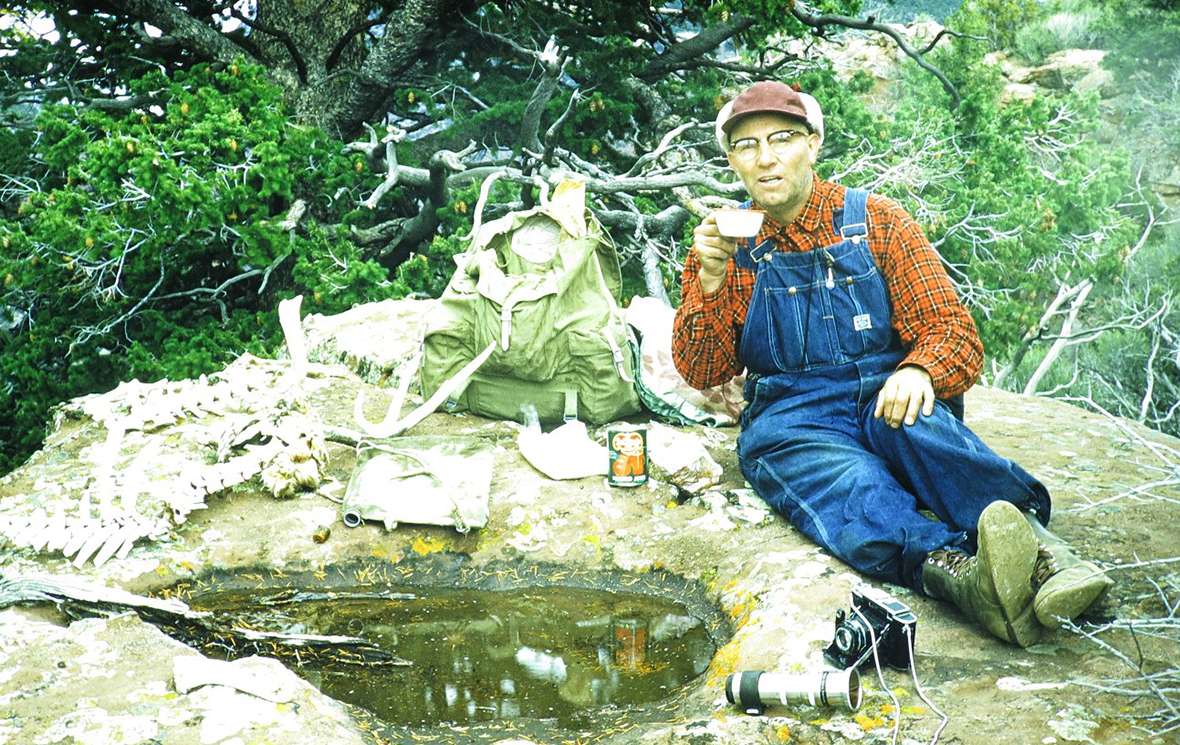
Finis Mitchell was a forester, mountaineer, outdoorsman and conservationist who came to Wyoming as a boy in 1906 with his parents. They arrived in Wyoming in a boxcar with all their possessions and some livestock. They settled on the west side of the Wind River Range. They tried to farm on 160 acres of sagebrush near Boulder, Wyoming. Farming proved unsuccessful on the dry barren land. The family survived on antelope, fish and potatoes, and Finis fell in love with the mountains of the Wind Rivers.
To support the family, Finis’ father took a job working in the coal mines near Rock Springs. Finis’ father became ill with lung problems from working in the mines, so Finis left school in 8th grade to work in a sawmill to help support his family. He never officially returned to school, but continued to study and learn.
Finis married Emma Nelson, a teacher in a one room schoolhouse, in 1925, and they raised two children.
As a young man, Finis took a job with the railroad, but was laid off in 1930 at the start of the Depression. Finis and his wife, Emma opened a fishing camp in the Southern Winds, but few of the alpine lakes at this time had fish in them. With fingerlings supplied by the Wyoming Game and Fish hatchery in Daniel, Wyoming, Finis and his father packed 5 gallon buckets of fish up into the Winds and stocked the lakes and streams. Finis estimated he planted 2.5 million trout into 314 lakes during the Depression.
After the Depression, Finis was rehired by the Union Pacific railroad, but in his free time he hiked and took photos in the Winds. Many of his photos became picture postcards sold to tourists.
Finis Mitchell served in the Wyoming House of Representatives from 1955 to 1958. Finis retired from the railroad in 1966 and continued hiking and guiding in the Wind Rivers. He wrote a guide commissioned by the U.S. Forest Service to the trails of the Wind Rivers before he wrote his guide to the Wind Rivers, “Wind River Trails: a Hiking and Fishing Guide to the Many Trails and Lakes of the Wind River Range in Wyoming.” It is a 142 page book easily carried in a backpack.
In 1975, the US Geological services named a peak in the Wind Rivers, Mitchell Peak in honor of Emma and Finis. It was very unusual to name a peak after a living people. In 1977 the University of Wyoming awarded him an honorary doctorate for his service to conservation.
Dr. David Love, head of the USGS in Wyoming recognized Finis as the authority on the Wind Rivers. Love allowed Finis to recommend many of the names for the peaks and lakes of the Wind Rivers.
In the early 1990s, friends and I packed goats into Atlantic Lake to fish and camp. We were joined by a fisherman from Rock Springs and his dog the next day. We introduced ourselves because we were concerned about the dog and the goats, but the Chesapeake Bay Retriever was more interested in running to the top of a snowfield and sliding into the lake, which he did obsessively, than he was in the goats. The fisherman had caught two fine rainbows. He gave the smaller one to us. The larger fish he was taking to Finis Mitchell. He had visited Finis in the nursing home, and Finis had requested one of the fish from his mountains. Finis Mitchell died November 13, 1995 one day before his 94th birthday.
If you happened to be lucky enough to catch a fish in the Winds and cook it over a campfire, be sure to remember Finis Mitchell, “Lord of the Winds.”
Photo of Finis Mitchell courtesy of WyoHistory.org
May 9, 2025
Ice, Snow, Rock: Gannett Peak
From the Dubois Badlands to the jagged Ramshorn Peak, the Upper Wind River Valley is home to many geological formations that awe and inspire people. Around 25 miles south of the town of Dubois stands another fantastic formation: Gannett Peak.
Protruding from the middle of the Wind River Mountain Range, Gannett Peak is the tallest mountain in Wyoming. The mountain’s highest natural point stands at 13,804ft, surpassing the Grand Teton by a mere 28ft. This mountain was named in 1906 after HenryGannett. Henry Gannett was a well-known geographer considered the “Father of Government Mapmaking,” but he never actually saw Gannett Peak let alone climbed it.
The first successful summit of Gannett Peak occurred in 1922 by an explorer named Arthur C. Tate and his guide, Floyd Stahlnaker. Stahlnaker lived and worked in Dubois as a hunting outfitter and rancher; he knew the region well and led Tate on a harrowing, but successful climb. Tate wrote the following about his first view of Gannett Peak:
“At the far end of the wonderful valley rose Gannett Peak—snow-capped and glacier-mantled, with great clouds partially veiling its summit. How inspiring to the mountain lover is the first glorious view of a great mountain peak, especially when the attendant conditions all enhance its natural wonder!”
“The Wind River Mountains of Wyoming,” by Arthur C. Tate, Appalachia, Vol. 15, pg. 160.
Six of the top ten largest glaciers in the Rocky Mountains south of the Canadian border obscure the mountain’s sides under acres of snow and ice. Gannett Glacier is the largest of these glaciers, measuring just under 900 acres wide. The CM Ranch led pack trips to the glaciers at the base of this peak, providing guests with a breathtaking view of some of the most remote areas in the United States. A CM Ranch guest on one of these expeditions took this article’s accompanying image in the 1940s. Dinwoody Glacier occupies the left side of the image while Gannett Peak soars into the clouds on the right.
Today, mountaineers consider Gannett Peak one of the most difficult state highpoints to summit, surpassed only by Denali Mountain (20,310ft) and Mount Rainier (14,411). Its the crest on the Continental Divide and the highest ground for over 290 miles in any direction. Great crevasses and steep canyons lay between the trailhead and summit of Gannett Peak. The isolation offers physical as well as mental challenges to those traversing the mountain trails, but the allure of experiencing the beauty and power of the Wind River Mountain Range firsthand continues to call people to its rugged ridges.
May 2, 2025
Latest #lookback content, “Blizzard of 1883”
Wyoming Blizzard of 1883
The winter of 1882-1883 began with only a few small snowstorms. But on the evening of January 31, a major northeast snowstorm blasted down hard into Wyoming. The storm blew until Feb 3, 1883 leaving drifts of snow in the streets of Rawlins as much as 10 feet high. Trains were stopped in their tracks unable to continue forward even with three engines straining to pull the cars. A passenger train came to a stop and was marooned in a snowdrift for 22 hours east of Laramie. The passengers made the best of the situation and were warmed by stoves in the passenger cars. Families who had packed picnic lunches for their journey shared their sardines and crackers with about 30 fellow stranded passengers.
As bad as things were for the train travelers, they were far, far worse for the stage drivers and passengers stranded by the storm between South Pass and Green River. Four people lost their lives on the stage line between South Pass and Green River and men lost fingers, toes and feet and ears to the cold.
George Ryder was the driver of the stage that carried Maggie Sherlock and superintendent W.J. Stuart from South Pass to Pacific Springs, a journey of about 12 miles. Superintendent Stuart was marking the road with tall willow switches every 25 to 30 feet, so drivers could follow the switches if the deep snow obliterated the road. Enough snow had fallen that it was decided a sleigh would be used instead of a coach. It was the first time that season a sleigh had been used. Eighteen-year-old Maggie was returning to Salt Lake to attend boarding school after Christmas break. Because of the snow and Stuart marking the route with switches, it was already noon before the sleigh arrived at Pacific Springs. Stuart stayed at Pacific Springs intending to catch the next stage returning to South Pass. After a change of horses George Ryder and Miss Sherlock proceeded on to Dry Creek station a journey of about 11 miles.
When the stage from Pacific Springs to South Pass departed, the storm had not yet started, so stage driver Thomas Scott, Superintendent Stuart and a passenger, Lander Valley rancher W.V. Clark started the journey to South Pass. But an hour later, the full force of the storm pounded the travelers. The stage became hopelessly trapped in the snow and the darkness. The men decided to abandon the coach and the team of horses and walked back to Pacific Springs. This decision would prove fatal for two of them.
The men followed the willow switches Superintendent Stuart had placed on his trip from South Pass to Pacific Springs the day before. Two men stayed at the one switch and the third man walked ahead until he found the next switch and then called for the other two to follow his voice. It was slow going and when nightfall came and the storm intensified the men decided to each go for it alone. It was every man for himself.
Meanwhile, George Ryder and Maggie Sherlock started out in their sleigh from Pacific Springs to the Dry Creek Station, a journey of 11 miles. They reached Dry Creek Station before the storm intensified. It would have been prudent for them to have stayed at Dry Creek Station, but the postal contract which helped to pay for the stage would not pay for missed trips and failure to make an assigned trip could result in a driver being fired. So, after getting a change of horses George Ryder and Maggie Sherlock set off from Dry Creek Station for the station on Little Sandy, which was a 16 mile journey.
After a short distance the driver Ryder became disoriented in the snow and lost his way, but managed to make it back to Dry Creek station. Ryder made a second attempt to leave Dry Creek station, but again lost his bearings as night fell and the wind picked up and the temperatures dropped. He circled in the storm for hours.
The storm’s fury continued through February 1st with the sleigh stranded in a gulch filled with snow. On the morning of February 2nd the storm was finally abated and George, even though he was badly frozen made one last attempt to walk to Dry Creek Station and save his passenger. He made it to Dry Creek, but was so exhausted and frozen he couldn’t tell the stock tender where exactly he had left the sleigh and Miss Sherlock.
Stock tender John Thorn took a fresh team of horses and went searching for the stranded passenger. He finally saw the seat of the sleigh buried in a snowdrift and found Maggie Sherlock wrapped in a buffalo robe buried inside the sleigh. She was alive, but frozen and only semiconscious. Thorn managed to get Maggie back to Dry Creek Station and the station master and his wife tended to the young woman. George Ryder died as the result of his injuries and his body lay frozen in the barn.
From The Carbon County Journal February 10, 1883:
“Special dispatch to the Journal: Green River, Feb 8– I understand they started out from Pacific Springs with a team, Driver Thomas Scott, Superintendent W.J. Stuart, and a passenger by the name W.V Clark. When they started it wasn’t storming, but after they had been out about an hour the storm overtook them. They finally abandoned the coach and team, and started back to Pacific on foot. The driver was found standing straight up in the snow. The superintendent was found standing in the snow, frozen so that he could not move. His hands and feet will have to come off. The passenger hasn’t been found yet. They were out three days and three nights before they were found, and when found they were within two miles of Pacific Springs.
Another stage started out with a driver and one passenger, Miss Maggie Sherlock. The Driver was badly frozen, and the passenger had her hands and feet frozen.”
A young Rev. John Roberts was caught on a train in this storm on his way to Fort Washakie to start his missionary duties. To get to Fort Washakie a traveler would take the train to Green River and then ride the stage for 36 hours to Fort Washakie. When Roberts arrived in Green River he hitched a ride with a mail sleigh headed for Fort Washakie since the stages were not running because of the storm. When the mail sleigh arrived at Dry Creek station Maggie was being cared for and George Ryder’s body was frozen in the barn. Roberts conducted a funeral for George Ryder and buried his body in a snow drift to be recovered when conditions allowed. Roberts chopped the tall sagebrush close to the station for fuel to keep the station where Maggie was being cared for warm. As soon as they were able, Maggie’s family came to get her and take her home to South Pass. For a couple of weeks, it looked like Maggie might recover from her injuries, but she died on February 21st, and was buried at South Pass.
Al Dougherty was another stage driver caught in the blizzard. He had to have one foot amputated at the ankle and his other foot amputated at the instep as a result of frostbite, but he continued to work as a stage driver for many years. Superintendent Stuart lost both hands and both ears and portions of both feet. Four people lost their lives in the storm, George Ryder, Maggie Sherlock, driver Thomas Scott and rancher, W.V. Clark. Clark’s body was finally found three weeks after the blizzard. Maggie Sherlock’s body was moved from South Pass to Mt. Hope Cemetery in Lander in 1924, and George Ryder was reburied from his snowy grave at Dry Creek to South Pass. He rests in an unmarked grave. As a result of this tragedy the stage line and mail route were changed from starting at Green River to starting at Rawlins, avoiding the highest elevations and the harshest conditions.
Author: Liz Farmer, Pioneer Museum
Photo stage driver Al Dougherty
Next up for the Fremont County Museum
May 17, 9am with the Dubois Museum, “Butch Cassidy at Jakey’s Fork” Wind River Visitors Council Adventure Trek Series
May 22, 7pm at the Pioneer Museum, “Lander 1925” Wyoming Community Bank Discovery Speakers Series
May 24, 1-3pm at the Pioneer Museum, “Being a Pioneer Kid” Bailey Tire/Pit Stop Children’s Exploration Series
May 24, 10am at the Pioneer Museum, “Lander Main Street Trek” Wind River Visitors Council Adventure Trek Series
May 31, 11am at the Riverton Museum, “Horned Owl Draper Raptor Experience” Bailey Tire/Pit Stop Children’s Exploration Series
Oct 4, TBA at the Lander Community Center, “Rare Relics Roadshow” Wind River Cultural Centers Foundation
Call the Dubois Museum 1-307-455-2284, the Pioneer Museum 1-307-332-3339 or the Riverton Museum 1-307-856-2665 for detail regarding their programs.
The Dubois Museum, the Pioneer Museum in Lander and the Riverton Museum need your financial support. In the current economic environment, the museums are more reliant than ever on donations from the private sector to continue to provide the quality programs, collections management, exhibits and services that have become their hallmark over the last four years. Please make your tax deductible contribution through the Wind River Cultural Centers Foundation www.windriverccf.com or by sending a check to Fremont County Museums 450 N 2nd Rm 320 or taking it directly to the museum you choose to support.
April 30, 2025
Episode “Opening of the Restervaton”
April 29, 2025
“A Day’s Catch in Fremont County”
Homesteading in the American West offered individuals ample opportunities to test their self-sufficiency against the unpredictability of nature. Fremont County offered its own people such an opportunity through fishing in the Wind, Popo Agie, and Sweetwater rivers as well as in other lakes, ponds, and streams. Fremont locals continue to fish in these areas, though for different purposes and within an entirely different set of circumstances.
In modern America, we often associate fishing with a unique blend of recreational patience and skill; the reward being the pride of the catch and a nourishing meal. During the frontier period, fishing wasn’t so much a fun choice as a true need. Survival necessitated frontiersmen acquire a versatile skill set that would grant them food to sustain themselves and their families (if they had them) consistently. As such, a day spent fishing without a catch was not only a disappointment to frontiersmen but a risk to sustaining the lives of themselves and those they cared for. Fishing (successfully) provided a method to keep people fed and energized enough to complete the manual labor required in daily frontier life.
The fishing technology available to early frontiersmen made a successful catch all the more difficult to achieve. Frontiersmen built their own tools when it came to acquiring sustenance. Homemade fishing gear from the frontier days commonly included a straight stick, fishing lines (made from horsehair or plant fibers), hooks (made from bone, wood, or metal scraps) and bait (worms or insects). These materials were less than perfect tools. Homemade fishing rods do not bend at the perfect angle when a cast is made nor is a high-quality reel, which assists in casting a line further and retrieving a line faster, part of the frontier story. The luxury of a tacklebox full of high-quality gear and a fishing pole with a fast line speed are far removed from the reality of the technology available at the time. With survival on the line, it’s hard to imagine homemade tools being enough to make a catch. Certainly, nets and spearfishing were also tactics used in this period, but both had their setbacks and neither provided the conveniences of today.
Fishing itself evolved in Fremont County due to environmental shifts and human intervention. Some of these changes could have proven helpful to frontiersmen in their quest for survival, had they been accessible. One such shift occurred in the 1930s, when fish cultivated in hatcheries were released into Ocean Lake. Fish stocking, as this process is called, can both manage the populations of various types of fish—helping the desired types of fish to increase while diminishing the less desirable types—as well as encourage local fishing practices. Frontiersmen could not count on such a practice and had to make do with the waters and fish available to them without this human intercession. If they returned home without a fish on the line, they did. If they caught “undesirable” fish, they did. Frontiersmen had far less ability to shift nature or to act within it. Reality loomed large over frontiersmen in Fremont County who hoped to live off of the land and build their lives well into the future.
With all of these historical forces working against them, it’s a wonder how the two men in the above photograph could have made such a large catch in Fremont County!
Author: Jami Cannon, Riverton Museum
Next up for the Fremont County Museum
April 19, 1-3pm at the Pioneer Museum, “Sheep Shearing Day” Bailey Tire/Pit Stop Children’s Exploration Series
April 26, 9-2 with the Pioneer Museum, “Garden Expo Craft Booth” Bailey Tire/Pit Stop Children’s Exploration Series
April 26, 10am at the Dubois Museum, “Wind River Kites: Make Your Own Kite” Bailey Tire/Pit Stop Children’s Exploration Series
May 1, 2pm at the Dubois Museum, “Shippen Family Legacy in Dubois” Wyoming Community Bank Discovery Speakers Series
May 17, 9am with the Dubois Museum, “Butch Cassidy at Jakey’s Fork” Wind River Visitors Council Adventure Trek Series
May 22, 7pm at the Pioneer Museum, “Lander 1925” Wyoming Community Bank Discovery Speakers Series
May 24, 1-3pm at the Pioneer Museum, “Being a Pioneer Kid” Bailey Tire/Pit Stop Children’s Exploration Series
May 24, 10am at the Pioneer Museum, “Lander Main Street Trek” Wind River Visitors Council Adventure Trek Series
May 31, 11am at the Riverton Museum, “Horned Owl Draper Raptor Experience” Bailey Tire/Pit Stop Children’s Exploration Series
Oct 4, TBA at the Lander Community Center, “Rare Relics Roadshow” Wind River Cultural Centers Foundation
Call the Dubois Museum 1-307-455-2284, the Pioneer Museum 1-307-332-3339 or the Riverton Museum 1-307-856-2665 for detail regarding their programs.
The Dubois Museum, the Pioneer Museum in Lander and the Riverton Museum need your financial support. In the current economic environment, the museums are more reliant than ever on donations from the private sector to continue to provide the quality programs, collections management, exhibits and services that have become their hallmark over the last four years. Please make your tax deductible contribution through the Wind River Cultural Centers Foundation www.windriverccf.com or by sending a check to Fremont County Museums 450 N 2nd Rm 320 or taking it directly to the museum you choose to support.
April 17, 2025
Wind River Cultural Centers Foundation Host Inaugural “Rare Relics Roadshow”
Mark Your Calendar!
Inaugural Rare Relics Roadshow
The Wind River Cultural Centers Foundation proudly presents its first-ever Rare Relics Roadshow!
Saturday, October 4th Lander Community and Convention Center
9:00 AM - 3:00 PM: Community Appraisal Event - What's Your Treasure Worth? Don't miss this special chance to have your antiques, collectibles, and intriguing items evaluated by professional appraisers. Select pieces may be considered for our evening auction.
6:00 PM - 9:00 PM: Fundraising Dinner & Auction Gala Join us for a delightful evening of dinner and both a silent and live auction showcasing a diverse array of rare relics and captivating finds. Your participation directly supports the Wind River Cultural Centers Foundation.
"We are thrilled to launch the Rare Relics Roadshow, a unique event offering our community the chance to uncover the value of their own historical items and contribute to the vital mission of the Wind River Cultural Centers Foundation through our evening auction. We hope you will join us for both exciting sessions!" – Mike Zirbel, President, Wind River Cultural Centers Foundation.
Further details regarding appraisal fees, dinner tickets, and auction previews will be shared soon.
Follow us for updates: https://www.windriverccf.com/ and any social media links
Proceeds from the Rare Relics Road Show will support the WRCCF’s mission and efforts on behalf of the Dubois Museum, Pioneer Museum in Lander and the Riverton Museum and help provide critical financial resources for the Museum’s continued operations and success.
January 9, 2025
Wind River Cultural Centers Foundation Seeks Event Planner
Event Planner Job Description:
The Wind River Cultural Centers Foundation is seeking a qualified professional for a contracted nine-month engagement. The successful candidate will be tasked with organizing and executing a diverse set of activities to raise funds for the Wind River Cultural Centers Foundation. The primary event supported by this position will be held in September of 2025, and is inspired by the well-known antique road show series. The event will offer a fresh and dynamic take on showcasing prized collectibles in a unique and interactive way. A comprehensive understanding of event management, donor engagement, and marketing techniques is crucial for maximizing event impact and achieving fundraising targets.
Event planner Job Responsibilities:
- Plan, coordinate, implement and evaluate all aspects of multi-faceted and complex events & projects, including supporting fundraising activities associated with event execution.
- Communicate event scheduling and needs with the Board, museum staff, venues, vendors, speakers, and guests. Attend monthly Board meetings to share updates and address event planning progress and needs (remote attendance allowable).
- Advise and collaborate with museum staff, community partners, and vendors on best practices to produce interesting, memorable, creative, and high-quality events.
- Maintain knowledge of the most up to date trends for effective event planning.
- Stay up to date on current events and civic/community issues and elected leaders, as well as marketing and PR industry developments, to ensure that Foundation content is relevant and timely.
- Provide outstanding customer service to internal and external audiences.
- Anticipate costs, develop initial budgets, and identify, pursue, and negotiate funding sources for events and special projects (including supporting the development of fundraising proposals).
- Maintain records for budget purposes, including but not limited to contracts, receipts, staffing, service invoices and vendor expenditures. Provide a debrief presentation and summary document to Board at the conclusion of the contract period.
- Monitor event and project budgets in real-time.
- Negotiate contracts with vendors and price points with other service providers.
Work Hours: We estimate an approximate workload of 20 hours per month based on the above responsibilities. This position will run from date of hire through October of 2025.
Essential Qualities:
- High level of integrity, professional maturity and sound judgment.
- Excellent time and task management skills as evidenced by a proven ability to handle multiple tasks efficiently and effectively at the same time as well as appropriate delegation.
- Highly resourceful team-player, with the ability to also be extremely effective independently and be proactive with approaches to problem-solving with strong decision-making capability.
- Ability to multitask in a fast-paced, deadline-driven environment.
- Ability to maintain effective working relationships with partners and collaborators and conduct oneself with professionalism.
- Ability to work with diverse groups of people.
- Appreciation for the role of philanthropy in building community, and enthusiasm to help brand our institution as a magnetic, inspiring home base for generosity and social impact in Fremont county through large events.
- Highly motivated, action-oriented self-starter with strong organizational skills, especially planning and coordination.
Desired Experience.
- Three or more years’ experience with project and event management.
- Demonstrated experience planning and managing large and small high-quality events.
- Strong verbal communication, interpersonal, and customer-service skills.
- Ability to exercise good judgement and discretion in handling sensitive matters.
- Ability to work in a highly collaborative team setting.
- Ability to manage multiple, simultaneous projects.
- Awareness of current trends in philanthropy.
To apply: Please send a cover letter and resumé to windriverccf@gmail.com no later than Friday, January 31st.
To apply, please send a cover letter and resumé to windriverccf@gmail.com no later than January 31st.
October 22, 2024
Pioneer Museum Program Coordinator Wanted
Fremont County Museum System
Fremont County Pioneer Museum in Lander, WY is looking for an outgoing, creative and dedicated Program/Event/Volunteer Education Coordinator.
Program/Event/Volunteer Education Coordinator
- Work collaboratively with museum staff to develop/schedule/organize Speakers programs, Trek programs, children’s programs, other interpretive programs as determined.
- Work collaboratively with museum staff to develop/schedule/organize special events that promote and enhance the museums standing and increase revenue.
- Promote programs, exhibits, interpretation, events through effective use of social media.
- Work collaboratively with museum staff to recruit/retain volunteers for programs, events, interpretation, maintenance, collections management, and to enhance daily operations.
- Manage retail area in conjunction with Site Manager.
- Answer visitor inquiries, promote all Fremont County Museum System museums.
- Assist visitors in finding local amenities and promote community events and activities.
- Work with museum support groups to promote and advance the mission of the museum
- Promote a positive image for the Fremont County Museum System and individual museum
- Recruit and manage volunteers
- Work with museum staff to manage and administer rentals of museum facilities
- Other duties as assigned
Qualifications/Experience
- Bachelor’s degree in American Studies, History, Art History or related field preferred
- Three years of public program experience preferred
- Ability to lead treks in sometimes challenging outdoor environment
- Ability to work with children
- Ability to provide excellent customer service and work well with the public to deliver programs
- Ability to work in an environment where teamwork professional respect, personal ethics and character are the foundation for achievement
- Excellent organizational skills, computer literacy skills
- Candidate must possess effective oral and written communication skills and the ability to effectively manage multiple staff and volunteers and projects.
- Experience in social media marketing/pod cast development a plus
- Grant writing/administration experience a plus
- Research and data entry skills a plus
- Must be able to lift up to 50lbs
- Must be able to lead Treks in moderately strenuous outdoor conditions
Salary/Benefits
- Salary $30,000.00 annually
- Excellent County health and retirement benefits
The Pioneer Museum is looking for a creative and dynamic person to fill the role of Program/Event/Volunteer Education Coordination.
Forward a Resume, Cover letter & 3 reference to Fremont County Museum Director, Scott Goetz, 450 N 2nd Rm 320, Lander, WY 82520. Email scott.goetz@fremontcountywy.gov
Dubois Museum Program Coordinator Wanted
Fremont County Museum System
The Dubois Museum in Dubois, WY is looking for an outgoing, creative and dedicated Program/Event/Volunteer Education Coordinator.
Program/Event/Volunteer Education Coordinator
- Work collaboratively with museum staff to develop/schedule/organize Speakers programs, Trek programs, children’s programs, other interpretive programs as determined.
- Work collaboratively with museum staff to develop/schedule/organize special events that promote and enhance the museums standing and increase revenue.
- Promote programs, exhibits, interpretation, events through effective use of social media.
- Work collaboratively with museum staff to recruit/retain volunteers for programs, events, interpretation, maintenance, collections management, and to enhance daily operations.
- Manage retail area in conjunction with Site Manager.
- Answer visitor inquiries, promote all Fremont County Museum System museums.
- Assist visitors in finding local amenities and promote community events and activities.
- Work with museum support groups to promote and advance the mission of the museum
- Promote a positive image for the Fremont County Museum System and individual museum
- Recruit and manage volunteers
- Work with museum staff to manage and administer rentals of museum facilities
- Other duties as assigned
Qualifications/Experience
- Bachelor’s degree in American Studies, History, Art History or related field preferred
- Three years of public program experience preferred
- Ability to lead treks in sometimes challenging outdoor environment
- Ability to work with children
- Ability to provide excellent customer service and work well with the public to deliver programs
- Ability to work in an environment where teamwork professional respect, personal ethics and character are the foundation for achievement
- Excellent organizational skills, computer literacy skills
- Candidate must possess effective oral and written communication skills and the ability to effectively manage multiple staff and volunteers and projects.
- Experience in social media marketing/pod cast development a plus
- Grant writing/administration experience a plus
- Research and data entry skills a plus
- Must be able to lift up to 50lbs
- Must be able to lead Treks in moderately strenuous outdoor conditions
Salary/Benefits
- Salary $30,000.00 annually
- Excellent County health and retirement benefits
The Dubois Museum is looking for a creative and dynamic person to fill the role of Program/Event/Volunteer Education Coordination.
Forward a Resume, Cover letter & 3 reference to Fremont County Museum Director, Scott Goetz, 450 N 2nd Rm 320, Lander, WY 82520. Email scott.goetz@fremontcountywy.gov
Riverton Museum Collection Manager Wanted
Collections Manager: Riverton Museum Riverton WY. Open until filled
The Riverton Museum in Riverton, WY seeks an energetic professional to manage the collections. This individual will work collaboratively with other museum staff and other museum professionals within the Fremont County Museum System.
Position Description
Collections Manager
- Oversee all aspects of collection management including planning, care, loan requests, conservation, accessions, storage, research, exhibits etc.
- Perform historic research and assist with research requests
- Manage part time staff, volunteers, interns
- Work collaboratively with FCMS staff to advance the mission of all three county museums
- Deliver talks and lectures for public programs and special events
- Assist with educational initiatives for various Museum audiences which may include developing and leading public curatorial and gallery talks, meeting with classes and other written materials for various audiences.
- Assist in planning and implementation of special events
- Work with museum support groups to promote and advance the mission of the museum
- Ability to research and write professional historic journal articles
- Archival experience a plus
Qualifications/Experience
- Minimum Bachelor’s Degree in museum studies, history, art history, American Studies or related field:
- 1-2 years of curatorial experience preferred
- Ability to work in an environment where teamwork professional respect, personal ethics and character are the foundation for achievement
- Excellent organizational skills, computer literacy skills, preferred Past Perfect experience
- Candidate must possess effective oral and written communication skills and the ability to effectively manage multiple staff and volunteers.
- Published writer a plus
- Exhibit and Interpretation experience preferred
- Must be able to lift up to 50lbs
- Must be able to lead Treks in moderately strenuous outdoor conditions
Salary/Benefits
- Salary $36,656.33 annually
- Excellent County health and retirement benefits
The Riverton Museum is looking for a creative and dynamic person to fill the role of Program/Event/Volunteer Education Coordination.
Forward a Resume, Cover letter & 3 reference to Fremont County Museum Director, Scott Goetz, 450 N 2nd Rm 320, Lander, WY 82520. Email scott.goetz@fremontcountywy.gov
February 13, 2024
Dubois Museum: Site Manager Vacancy
Dubois Museum Site Manager
The Fremont County Museum System is seeking an energetic and creative individual to lead the Dubois Museum into the future. The Dubois Museum is located in Dubois, WY in the Wind River region of West Central Wyoming. Please email your resume, references and cover letter to scott.goetz@fremontcountywy.gov. This position is open until filled.
Essential Duties
- Oversee all aspects of site management including planning, programs, events, maintenance collections, budget, fundraising, gift shop and delegates accordingly.
- Perform historic research and assist with research requests
- Manage full and part time staff, volunteers, interns
- Work collaboratively with other Fremont County Museums staff to advance the mission of all three county museums
- Deliver talks and lectures for public programs and special events
- Assist with educational initiatives for various Museum audiences which may include developing and leading public curatorial and gallery talks, meeting with classes and other written materials for various audiences.
- Takes the lead in planning and implementation of special events
- Work with museum support groups to promote and advance the mission of the museum
- Work jointly with other Fremont County Museum staff to produce ReDiscover the Winds Podcast
- Ability to promote the Riverton Museum via social media
- Ability to provide comprehensive/accurate written historical content for publication
- Ability to research/prepare/deliver content for ReDiscover the Winds: A Wyoming History Podcast
Qualifications/Experience
- Minimum Bachelor’s Degree in museum studies, history, art history, American Studies or related field:
- Master’s Degree preferred
- 2-3 years of progressive museum/historic site management experience preferred
- Budget Management experience
- Ability to work in an environment where teamwork professional respect, personal ethics and character are the foundation for achievement
- Excellent organizational skills, computer literacy skills, preferred Past Perfect experience
- Experience with Quickbooks POS
- Candidate must possess effective oral and written communication skills and the ability to effectively manage multiple staff and volunteers.
- Published writer a plus
- Exhibit and Interpretation experience preferred
- Non-profit experience a plus
- Collections Management experience a plus
- Experience in full time staff management
- Social Media Marketing and Podcast experience a plus
- Professional, energetic and creative qualities desired
- Valid Driver’s License required
Salary/Benefits
- $42,901.00 Annually
- Excellent Retirement Benefits Including Deferred Compensation
- Excellent Medical/Dental Insurance
- Possibility of hybrid work arrangement
November 9, 2023
Fremont County Museums: Invitation to Bid-Dubois Museum Shop
Invitation to Bid
Fremont County Museums
Dubois Museum Shop
Spring 2024 Construction timeline
Bid Opens: November 13, 2023
Bid Closing: December 1, 2023
Pre Bid Meeting: (open): November 21, 2023 9 am Dubois Museum 909 W Ramshorn Dubois, WY 82513
Bid packets available
Bid Packets: available via call Scott Goetz 307-332-1075
Sealed Bids: Due 1pm December 4, 2023 Fremont County Museums 450 N 2nd RM 320 Lander, WY 82520
Bid Opening: December 4, 2023 2pm Fremont County Map Room
Fremont County Museums: Invitation to Bid- Pioneer Museum Pavement Project
Invitation to Bid
Fremont County Museums
Lander Pioneer Museum Pavement Project
Spring 2024 Construction timeline
Bid Opens: November 13, 2023
Bid Closing: December 1, 2023
Pre Bid Meeting: (open): November 20, 2023 9 am Fremont County Pioneer Museum 1443 W Main Lander, WY 82520
Bid packets available
Bid Packets: available via call Scott Goetz 307-332-1075
Sealed Bids: Due 1pm December 1, 2023 Fremont County Museums 450 N 2nd RM 320 Lander, WY 82520
Bid Opening: December 1, 2023 2pm Fremont County Map Room
Fremont County Museums: Invitation to bid-Pioneer Museum Vestibule
Invitation to Bid
Fremont County Museums
Lander Pioneer Museum Vestibule
Spring 2024 Construction timeline
Bid Opens: November 13, 2023
Bid Closing: December 1, 2023
Pre Bid Meeting: (open): November 20, 2023 9 am Fremont County Pioneer Museum 1443 W Main Lander, WY 82520
Bid packets available
Bid Packets: available via call Scott Goetz 307-332-1075
Sealed Bids: Due 1pm December 1, 2023 Fremont County Museums 450 N 2nd RM 320 Lander, WY 82520
Bid Opening: December 1, 2023 2pm Fremont County Map Room
November 2, 2023
“A Work in Progress, The Art of Jerry Antolik” opens November 11 at the Lander Pioneer Museum.
Lander has a long history of painters, sculptors and photographers who created striking visual art. Many of the artists worked professionally.
A new exhibit at the Lander Pioneer Museum will feature one of these artists. Most area people recognize the name Jerry Antolik, and they certainly have seen his work – his large wildlife murals around the county are hard to miss. “A Work in Progress,” a retrospective of Antolik’s work, will open November 11 at 7 p.m. in the museum’s main gallery.
A reception with music, appetizers and a brief talk by the artist will start at 7 p.m. Followed by a ribbon cutting for the exhibit. The public is invited to come and enjoy the evening. The art will then be on display until the fall of 2024.
“Over the last few years we have featured art and artists of the American west like Joe Scheurle, Frederick Remington and J.K. Ralston,” said Museum curator Randy Wise. “But we feature local artists as well– there have been many talented people over the years in our valley.”
Born in 1946, Antolik earned a degree in illustration from Cooper School of Art, Cleveland, Ohio, before working for the American Greeting Card Company and then Designs Unlimited, a commercial studio in Maple Heights, Ohio.
In the early 70’s he moved to Colorado, and then Wyoming, where he set out to experience the American West, and capture that experience with his art.
He herded sheep in the Wyoming badlands, worked on ranches and explored the vast wilderness of the Rocky Mountains.
Antolik has spent the last few decades as a professional painter. He has also taught many other artists through workshops and as an instructor at Central Wyoming College.
Most people in Lander Wyoming would agree he is the best known artist in the county, and has been for a long time.
Antolik is more modest about his art, considering himself still “A Work in Progress.” He says he is still learning, growing, and finding new ways to express himself artistically. “I have had to overcome my training as a studio artist, letting go of old ideas, and growing into new ones.”
The “Work in Progress” exhibit is the final event in a packed year at the museum. According to Wise all of the museum’s treks, speakers and children’s programs were filled, and events like Halloween Night at the Museum, the White Robe Exhibit, Apple Fest and Sheep Shearing Day brought in hundreds of visitors. “We have a great 2024 planned as well,” said Wise. Still to come this year is a new event at the museum – a light filled Christmas in the Pioneer Village in December.
For more information visit the museum website at www.fremontcountymusuems.com, on Facebook at Pioneer Museum Lander Wyoming or call 307-332-3373.
Press contact Randy Wise, 307-332-3373 or randywisepioneermuseum@gmail.com
Photo captions:
- Antolik at work in the field
October 5, 2023
Cherie Lewis Joins Staff at the Pioneer Museum in Lander
Cherie Lewis is the newest member of the Pioneer Museum staff. Cherie is the Program/Volunteer/Education Coordinator.
Cherie Lewis loves the outdoors, dirt roads, exploring with her camera, and hanging with her tripod dog, Belle. She believe in hard work, no matter what the work is, that every person has creativity in their hearts, and that their history creates the environment they resonate with. Every photograph, book, journal and heirloom tells a story, from a teapot found in an antique store to a quilt discovered in Grandma’s attic. Cherie believes in the power of doing what you’re created to do, and hopes that her presence at the Pioneer Museum represents that work ethic well.
Riverton Museum Welcomes Newest Member of Staff
Kevin Scannell has joined the staff of the Riverton Museum as the Program/Volunteer/Education Coordinator.
Kevin was born and raised in St. Louis, Missouri. He went to school at Connecticut College and wrote a senior honors thesis titled “Bonded by Class, Divided by Race: Labor Radicalism and the Origins of the Freedom Struggle in St. Louis from 1877-1945.” Kevin enjoys playing ultimate frisbee and has competed at high school and college national tournaments. Kevin is very excited to work at the Riverton Museum because of its excellent portrayal and preservation of early local Wyoming artifacts. Kevin has already learned so much in such a short time here and can’t wait to become more involved with the community through our amazing guest speaker program!
July 17, 2023
Ribbon cutting and celebration at Pioneer Museum EV charging station Friday, July 28th
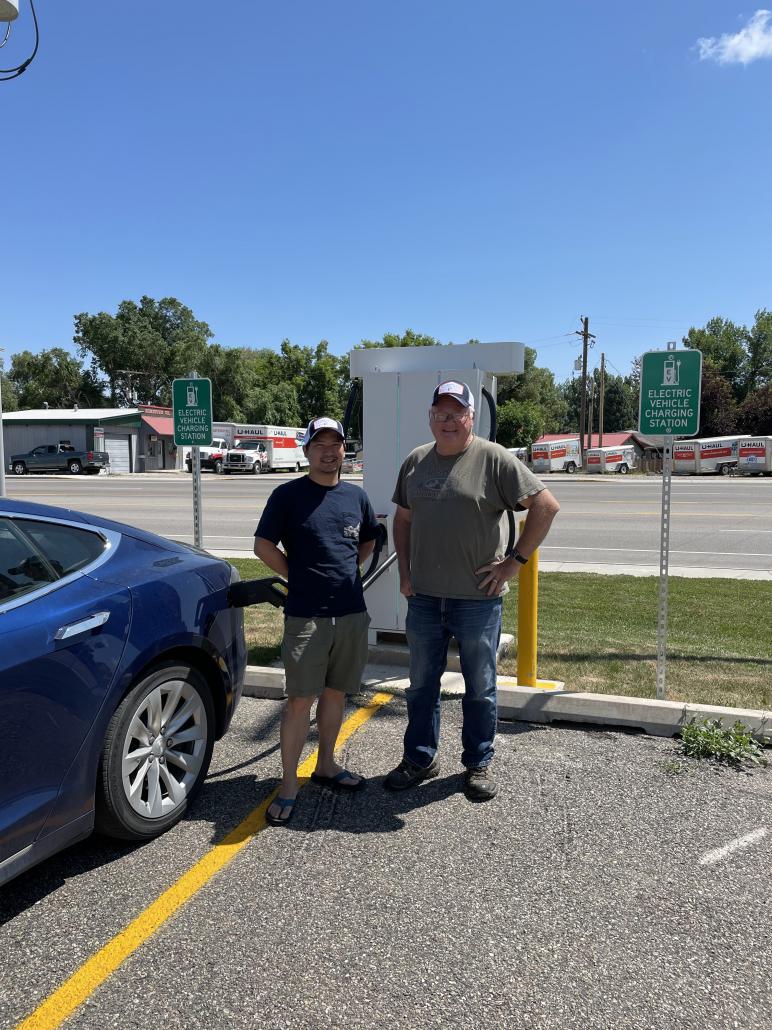
The Fremont County Pioneer Museum and OtterSpace Electric Vehicle would like to invite the public to a ribbon cutting ceremony and celebration at the brand-new fast charging electric vehicle station located at the museum. The event is scheduled for 4:00-4:30 pm on Friday, July 28th, in front of the Museum.
Interested members of the public should come by to enjoy light refreshments, learn some fun facts about the history of electricity and transportation in Lander and Fremont County, and celebrate the opening of the charging station — the first fast charging in Fremont County. You’ll even get to take a look at an EV charging and learn a little about how the process works!
The 120 kW OtterSpace charging station at the Fremont County Pioneer Museum is the first of three total installations that will bring fast charging services to all Fremont County Museums over 2023 and 2024. The station hosts some of the only fast charging available off the interstate in the entire state of Wyoming.
Stay tuned for details on a public celebration of the Dubois Museum charging station!
Founded in 2021, OtterSpace is working to install EV charging stations in communities around the state, with charging stations installed or in progress in Lander, Dubois, Pinedale, and Laramie this summer – and more to come.
For more information, please reach out to Randy Wise at the Fremont County Pioneer Museum (307-332-4137), or Kristen Gunther with OtterSpace (kristen@otterspace.us).
May 16, 2023
WYOMING ELECTRIC VEHICLE CHARGING COMPANY ANNOUNCES 2023 CHARGING PROJECTS IN FOUR COMMUNITIES
OtterSpace Electric Vehicle is pleased to announce partnerships that will bring fast charging and Level 2 charging services to communities around Wyoming in the coming months, starting with Lander, Pinedale, Dubois, and Laramie — with more to come this year and beyond.
By partnering with local governments and businesses in communities around the state, including Fremont County Museums, the Town of Pinedale, and the City of Laramie, OtterSpace is working to help Wyoming main streets, small businesses, tourism and travel attractions, and amenities benefit from growing EV traffic. Beginning in the late spring and running through the fall, OtterSpace will begin installing chargers in these four communities and more, with additional projects for 2023 and beyond to be announced in the coming weeks. All installations will be completed in partnership with AMG Electric, based in Laramie, Wyoming.
About our first projects
Lander’s 120 kW fast charging station will be installed at the Fremont County Pioneer Museum on the west end of Lander. The Pioneer Museum is not only a major tourism asset in Fremont County, but also a major hub hosting educational programming on local history, geology, and wildlife as well as community events. The museum is also walking distance from a City of Lander visitor’s center and a number of local retail stops. Anticipated to be in service by early June, the Lander charger is the first of three projects planned to eventually bring charging to all three Fremont County Museum locations.
The Lander project will be followed by an installation at the Dubois Museum in Dubois later in the summer, which will be supplied with a 200 kW fast charger, providing some of the fastest EV charging in the state. The Dubois station will be installed near the historic Swan’s Service Station, an antique gas station on museum grounds, which will provide travelers with a unique charging stop that delivers an engaging slice of local transportation history. OtterSpace will also initiate planning for the Riverton Museum station this summer, with installation slated for 2024.
In Pinedale, a 120 kW charging station will be installed on public parking at 31 North Maybell, in the heart of downtown Pinedale and adjacent to many attractions and retail amenities, providing a convenient and engaging charging stop for travelers visiting or passing through Pinedale. This station will provide direct access to local food and entertainment options during summer travel months, and encourage drivers to get out and explore the Town of Pinedale and the many downtown destinations available nearby.
Finally, OtterSpace is thrilled to begin a long-term partnership with the City of Laramie with 80A Level 2 charging installations planned for public parking at 1st and University Avenue, just adjacent to Laramie’s busy downtown shopping district. Level 2 charging in downtown Laramie will help provide access for EV drivers to the many downtown amenities and activities offered through Laramie year round.
About OtterSpace
Founded in 2021, OtterSpace primarily focuses on delivering fast charging services, as well as Level 2 EV charging in select locations, and works by partnering with businesses and governments interested in attracting EV traffic. Installations in Lander, Pinedale, and Dubois this summer will bring 120-200 kW fast charging to attractive main street locations; in Laramie, OtterSpace is working to install Level 2 charging in the downtown while looking toward larger fast charging stations closer to the interstate for 2024 and beyond. Charging service, network connectivity, and 24/7 assistance will be provided through OtterSpace’s partnership with EV Connect, a company with an international footprint and over a decade of experience.
“OtterSpace was founded to bring world-class EV charging with local service to Wyoming communities,” said President and Founder Mike Yin. “We’re thrilled to be working in partnership with local governments and business leaders throughout the state to make sure that our main streets and travel destinations can attract this growing class of driver.”
“Electric vehicles need fast charging options to ensure that they can make longer trips,” adds company vice president Kristen Gunther. “It’s a service that is increasingly important as major auto manufacturers like GM and Ford are quickly working to electrify their fleets. Right now, EV drivers don’t have many options outside of interstates for fast charging, which puts so much of our state out of reach.” OtterSpace’s 2023 installations will play a key role in filling those gaps and ensuring that all of Wyoming is accessible to drivers, no matter what consumer choice they make in vehicles.
“We’re proud to be the only Wyoming EV charging company that focuses on fast charging, so that Wyoming businesses can benefit from offering this 21st century amenity while working directly with in-state personnel who understand the real needs of our communities,” says Yin.
Words from our partners:
Todd Feezer, Assistant City Manager, City of Laramie: “We are very excited about our partnership with OtterSpace. By combining forces, OtterSpace and the City of Laramie will be able to quickly provide new EV charging in Laramie. These new stations will be placed in convenient locations in our retail sector, providing shopping and dining options for the EV driver community while they charge their vehicles.”
Scott Goetz, Director, Fremont County Museums: “Fremont County Museums are excited to be working with OtterSpace to complete installation of EV Charging units at the Dubois Museum, Pioneer Museum and the Riverton Museum. We believe providing EV Stations at each museum will increase awareness in our museums and the valuable Cultural Heritage we have to share. OtterSpace has proven to be an excellent partner for the Museums and we are thrilled to play a larger role in the economic development in each of our communities by helping provide opportunities for visitors to Wind River Country the access to services they need to enjoy all Fremont County has to offer.”
Matt Murdock, Mayor, Town of Pinedale: “The Town of Pinedale is happy to partner with OtterSpace to provide EV charging for visitors to and residents of the area. This public-private partnership comes at little, if any cost, to the town and will give Pinedale area residents more transportation options while allowing us to welcome a broader tourism base to strengthen local businesses."
Joe Thell, Senior Vice President of Sales & Business Development at EV Connect: “By deploying at multiple locations and using several types of charging stations, OtterSpace is demonstrating true sophistication in its approach. At the forefront of EV charging, we find organizations that take the time to understand the changing needs of the locations they serve, essential to sustainable growth of EV’s. With an eye towards future needs, and a firm grasp of what it takes to manage and maintain the equipment, OtterSpace has proven to be a forward-thinking leader in its expansion to enable a sustainable future. We are delighted to be able to serve OtterSpace and its many new customers with a digital EV charging network that will not only ensure maximum uptime and reliability for these charging stations, but also ensure seamless growth for years to come.”
****
For inquiries reach out to kristen@otterspace.us or 307-349-8755.
May 5, 2023
“White Robe” The Story of Rev. Dr. John Roberts in Series of Paintings by Renowned Artist Brian Whelan
“White Robe” A contemporary art exhibition by celebrated Irish artist Brian Whelan on life and work of the Rev. Dr. John Roberts of the Wind River Reservation in Wyoming.
Reverend John Roberts is one of the most significant figures in the history of the Lander Valley. A new collection of paintings by Irish artist Brian Whelan tells his life story and will displayed at the Lander Pioneer Museum this summer.
Modeled after the historic Chief Washakie paintings by J.K. Ralston that hang in the Lander Museum, the Whelan paintings tell the story of significant parts of Robert’s life.
The unique exhibition will premiere on the 140th anniversary of The Rev. Dr. John Roberts’ arrival on the Wind River Reservation in Wyoming, in 1883, where he served among the Eastern Shoshone and Northern Arapaho tribes. Beyond commemorating his extraordinary life and ministry, the exhibition also draws attention to the importance of learning from the spirituality, culture and traditions of Native Americans.
Roberts was born in Wales in 1853, and while training for Anglican ordination felt called to serve among his Native Americans in North America. Following a brief time of service within a leper colony in the Bahamas, he began his ministry on the Wind River Reservation in 1883. Not long after his arrival, he conducted the funeral for Sacagawea, who as a young Eastern Shoshone woman, was the celebrated guide on the renowned Lewis & Clark expedition. As a missionary-priest, Roberts was well ahead of his time, as he encouraged Native American expressions of spirituality and faith, embracing and honoring tribal culture and language, and traditional indigenous rituals and customs. He cultivated close friendships with tribal leaders, including the renowned Eastern Shoshone Chief Washakie and Northern Arapaho Chief Black Coal, and was referred to with deep affection as “White Robe” and "Elder Brother.” If there were negotiations with U.S. government officials, the tribes would not proceed without John Roberts being present. His work led him, with the assistance of tribal leadership, to establish two alternative schools on sacred land gifted by the tribes that focused on honoring and preserving Indigenous culture. One of the schools is on the National Register of Historic Places today.
In addition to his ministry on the Wind River Reservation, he founded all the Episcopal churches among white settlers within 150 mile radius, in Fremont County - including among others, the present-day Episcopal churches in Lander, Riverton, Thermopolis, Atlantic City, Morton, Crowheart and Dubois, and churches that no longer exist in Milford, Hudson and Shoshoni.
Brian Whelan grew up in London, of Irish parents. After his training at the Royal Academy of Arts, he lived and worked in the East Anglia area of England near the North Sea. His home and studio are now based in Connecticut, USA. Known for his folk and whimsical style, his paintings have been exhibited in celebrated art spaces, cathedrals and religious institutions around the world - such as Washington National Cathedral and Villanova University of Pennsylvania in the USA, St. Martin in the Field, Trafalgar Square, London, St. Edmundsbury Cathedral and Norwich Cathedral in the U.K., and Parador Dos Reis Catolicos, Santiago de Compostela in Spain. Whelan’s work follows in the tradition of East Anglian narrative painting.
April 21, 2023
Lander Pioneer Museum launches free audio walking tour of historic downtown
Have you ever wondered what that old building at the corner of 2nd and main was originally? What is the oldest building on Main Street? Where the first bank in Lander was? Where Butch Cassidy often had a drink?
A new audio walking tour of Lander will answer those and many other questions. Called "Lander Downtown, where the rails ended and the trails began," the tour is now available for download to your phone or device. The service is free.
You can explore the vibrant history of Lander, Wyoming. From its beginnings as a rough, isolated army fort at the edge of the wilderness, through the frontier days of Butch Cassidy, Calamity Jane and Shoshone Chief Washakie, to the coming of the railroad and growth into a settled, bustling Victorian town, you'll walk in the steps of Native Americans, explorers, gold miners, cowboys, outlaws, ranchers, traders, trappers and dreamers on this walking tour of the past.
To get the tour, go to the App store on your phone and search for TravelStorysGPS. The app is a free download. The Lander tour should pop up on your device, along with other nearby tours, if not search for "Lander." Once the tour has downloaded you are ready to take a walk and learn about Lander's fascinating history.
January 16, 2023
Post Traders – Trade Tokens On Exhibit at the Pioneer Museum in Lander
By the late 1850s in Wyoming trade tokens were being produced and used as a replacement for payment in American dollars to local Native Americans. They were developed for commerce and payroll.
One purpose of the tokens was to place a firm value on a barter or trade between the store and a Native American wishing to purchase basic living supplies and European goods. Native Americans were able to sell their wares, such as hides, pelts or beaded goods such as moccasins or bags, to a trading post and be paid in trade tokens and, then in turn purchase goods and supplies from that post using their tokens. Another use was for tokens was as payment for services rendered such as hauling freight and handy work around the shop.
The tokens were referred to as brass checks by the Camp Brown and Fort Washakie store clerks. Native American’s referred to them as yellow money or Oha-boo-u-way to the Shoshone and Ne-ha-yahbich-thay to the Arapahoe speakers.
Prior to 1870 there were no post traders. Individuals filling essentially the same role were called sutlers, which means a non-military shopkeeper or supplier to an army post. In 1867 there was a congressional joint resolution that replaced sutlers with post traders and in 1870 congress established post traders.
Post traders were appointed by military authority and held their position indefinitely. The stores were created to supply domestic goods to U.S. Soldiers and their families posted at military camps around the United States as an expansion of what commissaries and base exchanges offered. They were also open to the public.
The first Lander area sutler and then post trader was Mr. J.K. Moore who was commissioned in 1869 by the U.S. military to accompany soldiers establishing Camp Brown, in what is now downtown Lander, and set up shop. Lasting less than three years in that location Camp Brown and Moore’s shop moved north in 1871 to a new military base also named Camp Brown but renamed Fort Washakie in January of 1879.
A quote dated March 26, 1878 from J.K. Moore states “It is my belief now that I will have no less than 1000 buffalo robes, and more likely 2000 for shipment” gives us idea of the size and influence Moore’s store had on the residents of the Wind River Indian Reservation and Fort Washakie. The use of trade tokens by post traders went on for about twenty-five years until 1894 when they were withdrawn from circulation.
December 9, 2022
First Fire firefighting vehicle in Dubois
In a dry environment filled with trees, grasses, and lightning storms, it is no surprise that fighting fires has long been a concern for the residents of Fremont County. As fires continue to be a threat to homes and livelihoods, the methods for fighting them have developed in sophistication, growing from simple bucket brigades to developing helicopters that drop thousands of gallons of retardant.
The first firefighting vehicle in the town of Dubois began its life as a Jeep. Following their success in the Second World War, the Willys-Overland company transitioned from building military Jeeps to a civilian counterpart. According to the company, almost 75% of American farmers did not have a truck or trailer, so the “Agri-Jeep” was meant to take the place of both vehicles. Beyond its proposed agricultural uses, the civilian Jeep was used for hundreds of other applications, specially modified to suit each purpose.
One of the many civilian Jeep applications was for a small fire engine. The Boyer Fire Apparatus Company in Indiana produced a variety of fire extinguishers and larger apparatus for controlling fires, and they were one of two companies that converted Willys-Overland Jeeps into fire engines. The back of the Jeep is converted into a storage area, while two hard pipes for pumping water and a ladder are installed on top of the vehicle. To complete the engine, a siren sits above the left wheel. Once the Jeep Fire Engine was completed in 1947, it was sent to Kurland Motors in Denver, Colorado before working its way up to the town of Dubois.
Once it arrived in Dubois, the engine did not sit unused. In 1951, records note that “Quick action by volunteer firemen averted what could have been a disastrous fire ….” Even when not fully operational the engine was put through its paces, two or three people pushing the engine to get it going when the battery was out. In 1955, a fire in the dead of night destroyed the grade school and gym buildings. Arden and Hazel Coad remembered this event as initiating the organization of a proper Dubois Volunteer Fire Department to replace the relatively unorganized prior volunteers. Once the new DVFD had organized and built a new fire barn, a new fire truck was bought, outstripping the Jeep in terms of capacity and utility.
Dubois’ first fire engine now sits behind the Dubois Museum and will soon be sent away for restoration.
December 5, 2022
OCTA Visits Harvey Morgan
Check out this great video from the Oregon California Trails Association. There were in Lander this summer and stopped at the museum to visit our first artifact - the skull of Harvey Morgan.
https://www.youtube.com/@octatrails
September 20, 2022
“Grounded” A touring exhibition of contemporary artists from Northern Plains tribes
Premiering at the Lander Pioneer Museum Oct. 2, 2022.
GROUNDED is an artistic exploration curated by ArtSpirit, the arts initiative of Episcopal Church in Wyoming, to inspire our imaginations about our need of being "grounded" in our relationship with all of creation: the earth and its wildlife, each other and ourselves.
GROUNDED will bring together an inspiring group of premier contemporary artists from Northern Plains tribes, whose artistic practice is a unique blend of their heritage and creative expression.
GROUNDED will be a touring contemporary art exhibition. It will also be offered simultaneously online through a virtual gallery.
Premiering at the Pioneer Museum in Lander, Wyoming October 2 through mid-November, then traveling to select cities in Wyoming.
Following the Wyoming tour, the plan is for the exhibition to be showcased in 2 other key venues within the US, then it will be shown in the United Kingdom and the Middle East.
The organizing curator, Bishop Paul-Gordon Chandler, the Bishop of Wyoming, has had extensive experience in coordinating large-scale exhibitions in the UK, Europe and the Middle East.
This exhibit is a follow-up to the very successful “Abraham” exhibit from 2021, which had a successful run at the Lander museum before appearing around the world.
Pioneer Museum Apple Fest 2022 the biggest yet
Apple pie was cut, judged and eaten, cider was pressed, applesauce was slurped, Lander apples and hard cider sampled, and a fun time was had by over 600 people at the Lander Pioneer Museum Apple Fest this past Saturday.
Lander has a long history of growing apples, dating back to the 1870s, and at one time produced so many apples it was known as “The Apple City.” Getting fresh produce and fruit into the valley in the early days was hard and expensive, so Lander pioneers Ed Young and Jacob Meyer, among others, worked hard to breed trees which would survive Wyoming’s climate, creating unique breeds to the area. Many of these early trees are still producing even today, and Lander apples are sold at the farmer’s market. The museum wanted to create a fun family event to recognize the history of apples in the Lander Valley, and apple fest was created.
The Lander’s best apple pie contest had an adult and a kid’s category this year. In the kid’s contest young baker Isaiah Webb, age 12, won first place and a ribbon along with a $15 cash Prize. Second place went to Alex Wise, age 11, for his pie. He won a $10 cash prize and a ribbon. Third place was won by C.C. Velarde’s pie who took home a museum store gift certificate and a ribbon.
In the adult category Cindy Herman from Lander won first place for apple pie. She won $60 and a ribbon. Cheryl Wise of Lander won second for her pie. She won a $35 prize and a ribbon. Chironne Torrez took third, winning a $25 prize and ribbon.
The judges had a tough time picking the winners, declaring all the pies were good.
“It was hard duty,” said judge Vince Tropea with his tongue firmly in cheek. “There are some great bakers here. I’ll have to be rolled home in a wheelbarrow now!,” Tropea said.
After the contest, the pies were sliced and sold for $2 a slice to the crowd, with the money going to the museum. A line stretched clear off the porch of the Pioneer Cabin for a chance to taste the pies, and not a crumb was left.
A popular activity was the cider press - kids lined up apples in hand to crank the gears and grind and press the apples to make cider. “You’ve never had apple cider until you’d had it fresh from the press,” said Pioneer Association President Bill Elder. “These kids are having a blast running this machine - it’s modern, but built like a traditional 100 - year old press.”
Other kids’ activities included a crafts table, horseback rides around the museum grounds and an applesauce eating contest. Different age groups had to eat apple sauce through a straw - the kid who ate their applesauce the fastest won a gift certificate to the museum store. The Lander High School National Honor Society kids helped run the contest, and dozens of kids lined up with a cup of sauce to slurp away. Braxton Sanders, age 3 won the 5 and under contest. Westley Warren, age 11 won the 5 to 9 competition and Finn Petersen, age 11 won the 10 to 14 age group.
In the crafts barn at the Livery Stable kids and families also had the opportunity to decorate a wooden ornament that will help decorate the museum’s Christmas Tree this winter.
Ian McGregor, Owner/Operator of Farmstead Wyoming from Jackson came to the apple fest with kegs of hard cider he produces from Lander apples. Very popular in Jackson, there was a long a long line to get a taste of the tart hard cider. The cider is also sold locally at Mr Ds.
“What a fun event to honor Lander’s apple history and its present,” said McGregor. “We are excited to be a part of this, to share what we make from Lander apples with Lander people.”
Jack States from the Canyon ranch, which has some of the original apples trees first planted in the valley, was at the festival with samples of Lander apples. Jack talked to many people about the history of apples in Lander. He is active in helping bring back historic orchards and trees in the area. “People don’t realize just how big a part of our local agriculture apples were,” States said.
“It was about as nice a September day as you can get,” said Randy Wise, Director of the Lander Museum. “We were surprised at how many folks came out – but are very happy people want to come to the museum and have fun while learning about Lander’s history.”
Wise gave a special thanks to all the folks who helped with the event. “Our judges worked hard, if you can call sampling apple pies hard work,” said Wise with a smile. “The Pioneer Association, our friends group, helped enormously, as did many other volunteers including kids from the Lander High School National Honor Society.”
Next up for the Museum is the annual “Halloween Night at the Museum,” October 14 and 15. A massively popular kids event, it is a “slightly spooky” tour of the Museum of the American West grounds with many fun activities.
For information call the museum at 307-332-3373 or check the Facebook page at Pioneer Museum Lander Wyoming.
September 14, 2022
Fremont County Museums Installs New Promotion at Riverton Airport
The Fremont County Museum staff has been working with the Riverton Airport Board over the past year to use the space above the baggage carousel to promote Fremont County Museums.
Scott Goetz: Central Director for Fremont County Museums said, "We have finally been able to install the graphics panels that we have been working on and look for them to have a positive impact on visitation and the visibility of each museum. It is important to continue to grow the economic impact that our Museums have on our communities."
August 29, 2022
New Temporary Exhibit at the Pioneer Museum
The Lander Pioneer Museum has a new lobby exhibit of perfume bottles and make-up accessories. The exhibit will be on display through the fall. The origin of makeup and perfume go back some 6000 years to Egyptian peoples.
The use of makeup has fallen in and out of social favor throughout history, tied to religious doctrines and the philosophy of Stoicism along with the traits of vanity and selfishness.
Most early societies embraced self-care, the use of deodorant and moisturizers, but hailed a person should enhance their natural appearance but not decorate it.
By the early 1400s makeup was culturally embraced around most of the world. Queen Victoria disapproved of makeup so for a time in parts of Europe and American it became unpopular. Then came the roaring 1920s when red lipstick and dark eyeliner returned to the Anglo-American world. The beauty industry took firm hold in America and advertisers sold makeup as a woman’s necessity, still attention getting but not wicked or selfish.
This exhibit would not be possible without the loving donations of the families of Victoria (Dickey) Casey-Connors, 1928-2022 of Riverton and Shirley Jean Beers-Heckart, 1936-2022 of Riverton, South Pass, and finally Lander.
Dickey Connors collected objects made of celluloid. Celluloid or French Ivory is a plant-based camphor pre-plastic that was used in manufacturing between the 1860s to the 1950s.
Shirley Heckart found joy collecting and displaying perfume bottles.
March 7, 2022
Hank Overturf of Riverton Appointed to Fremont County Museum Board
Jessica Moore Becomes Riverton Museum Site Manager
November 23, 2021
Riverton Museum Seeks Site Manager
The Riverton Museum is seeking a dynamic, energetic and creative Site Manager to oversee operations at the Riverton Museum. Email your Resume, Cover Letter and References to scott.goetz@fremontcountywy.gov.
Site Manager
Essential Duties
- Oversee all aspects of site management including planning, programs, events, maintenance collections, budget, fundraising, gift shop and delegates accordingly.
- Perform historic research and assist with research requests
- Manage full and part time staff, volunteers, interns
- Work collaboratively with other Fremont County Museums staff to advance the mission of all three county museums
- Deliver talks and lectures for public programs and special events
- Assist with educational initiatives for various Museum audiences which may include developing and leading public curatorial and gallery talks, meeting with classes and other written materials for various audiences.
- Takes the lead in planning and implementation of special events
- Work with museum support groups to promote and advance the mission of the museum
- Work jointly with other Fremont County Museum staff to produce ReDiscover the Winds Podcast
- Ability to promote the Riverton Museum via social media
- Ability to provide comprehensive/accurate written historical content for publication
- Ability to research/prepare/deliver content for ReDiscover the Winds: A Wyoming History Podcast
Qualifications/Experience
- Minimum Bachelor’s Degree in museum studies, history, art history, American Studies or related field:
- Master’s Degree preferred
- 3-4 years of progressive museum/historic site management experience preferred
- Budget Management experience
- Ability to work in an environment where teamwork professional respect, personal ethics and character are the foundation for achievement
- Excellent organizational skills, computer literacy skills, preferred Past Perfect experience
- Experience with Quickbooks POS
- Candidate must possess effective oral and written communication skills and the ability to effectively manage multiple staff and volunteers.
- Published writer a plus
- Exhibit and Interpretation experience preferred
- Collections Management experience preferred
- Experience in full time staff management
- Social Media Marketing and Podcast experience a plus
- Professional, energetic and creative qualities desired
Salary/Benefits
- $38,300.00 Annually
- Excellent Retirement Benefits Including Deferred Compensation
- Excellent Medical/Dental Insurance
September 8, 2021
“The Arapaho Way” photographs by Lander Photographer Sara Wiles
“The Arapaho Way” photographs by Lander Photographer Sara Wiles on display at the Lander Pioneer Museum starting Sept. 24
Contemporary photos of Arapaho people will be on display at the Lander Pioneer Museum’s Western Gallery through the fall. The images were taken by Lander photographer Sara Wiles and published in her 2019 book “The Arapaho Way, Continuity and change on the Wind River Reservation.”
The striking black and white images detail life on the reservation today, showcasing the Arapaho people’s resilience and blend of modern and traditional lifeways.
Described as a profound glimpse into Arapaho culture, the 30 plus images and their accompanying narratives, bridge a gap between Indian and non-Indian communities.
Since 1973 Sara Wiles has worked on the Wind River Reservation, home of the Northern Arapaho and Eastern Shoshone Tribes, as a student of anthropology, a social worker, consultant for language and culture projects, and photographer. Her first book of photographs of Northern Arapaho people, Arapaho Journeys: Photographs and Stories from the Wind River Reservation, was published by the University of Oklahoma Press in 2011. In 2019, a second book of photographs and stories of Northern Arapaho people, The Arapaho Way, Continuity and Change on the Wind River Reservation was published, also by the University of Oklahoma Press.
Sara’s photographs have been exhibited widely in the United States and Europe. Two major exhibits have been mounted at the Plains Indian Museum of the Buffalo Bill Center of the West in Cody, Wyoming. Her photographs have been accepted into juried art and photography shows across the country, and she has won many awards, including the 2000 Wyoming Governor’s Art Award.
The exhibit will be on display at the Lander Museum through the fall. Call 307-332-3373 for more information or check Facebook at Pioneer Museum, Lander Wyoming.
September 3, 2021
Finnis Mitchell: Lord of the Winds
Finis Mitchell was a forester, mountaineer, outdoorsman and conservationist who came to Wyoming as a boy in 1906 with his parents. They arrived in Wyoming in a boxcar with all their possessions and some livestock. They settled on the west side of the Wind River Range. They tried to farm on 160 acres of sagebrush near Boulder, Wyoming. Farming proved unsuccessful on the dry barren land. The family survived on antelope, fish and potatoes, and Finis fell in love with the mountains of the Wind Rivers.
To support the family, Finis’ father took a job working in the coal mines near Rock Springs. Finis’ father became ill with lung problems from working in the mines, so Finis left school in 8th grade to work in a sawmill to help support his family. He never officially returned to school, but continued to study and learn.
Finis married Emma Nelson, a teacher in a one room schoolhouse, in 1925, and they raised two children.
As a young man, Finis took a job with the railroad, but was laid off in 1930 at the start of the Depression. Finis and his wife, Emma opened a fishing camp in the Southern Winds, but few of the alpine lakes at this time had fish in them. With fingerlings supplied by the Wyoming Game and Fish hatchery in Daniel, Wyoming, Finis and his father packed 5 gallon buckets of fish up into the Winds and stocked the lakes and streams. Finis estimated he planted 2.5 million trout into 314 lakes during the Depression.
After the Depression, Finis was rehired by the Union Pacific railroad, but in his free time he hiked and took photos in the Winds. Many of his photos became picture postcards sold to tourists.
Finis Mitchell served in the Wyoming House of Representatives from 1955 to 1958. Finis retired from the railroad in 1966 and continued hiking and guiding in the Wind Rivers. He wrote a guide commissioned by the U.S. Forest Service to the trails of the Wind Rivers before he wrote his guide to the Wind Rivers, “Wind River Trails: a Hiking and Fishing Guide to the Many Trails and Lakes of the Wind River Range in Wyoming.” It is a 142 page book easily carried in a backpack.
In 1975, the US Geological services named a peak in the Wind Rivers, Mitchell Peak in honor of Emma and Finis. It was very unusual to name a peak after a living people. In 1977 the University of Wyoming awarded him an honorary doctorate for his service to conservation.
Dr. David Love, head of the USGS in Wyoming recognized Finis as the authority on the Wind Rivers. Love allowed Finis to recommend many of the names for the peaks and lakes of the Wind Rivers.
In the early 1990s, friends and I packed goats into Atlantic Lake to fish and camp. We were joined by a fisherman from Rock Springs and his dog the next day. We introduced ourselves because we were concerned about the dog and the goats, but the Chesapeake Bay Retriever was more interested in running to the top of a snowfield and sliding into the lake, which he did obsessively, than he was in the goats. The fisherman had caught two fine rainbows. He gave the smaller one to us. The larger fish he was taking to Finis Mitchell. He had visited Finis in the nursing home, and Finis had requested one of the fish from his mountains. Finis Mitchell died November 13, 1995 one day before his 94th birthday.
If you happened to be lucky enough to catch a fish in the Winds and cook it over a campfire, be sure to remember Finis Mitchell, “Lord of the Winds.”
Photo of Finis Mitchell courtesy of WyoHistory.org
Next up for the Fremont County Museum
Sept 3, 9-5 at the Dubois Museum, Pioneer Museum in Lander, Riverton Museum, “First Fridays”
State Farm Riverton – State Farm Lander
Sept 3, Noon at the Riverton Museum, “Jim Bridger: Trailblazer of the American West” by Jerry Enzler
Wyoming Community Bank Discovery Speakers Series
Sept 11, 1-3 at the Pioneer Museum, “Apple Fest”
Bailey Tire/Pit Stop Children’s Exploration Series
Sept 18, 10-2pm at the Pioneer Museum, “Louis Lake Lodge Adventure Trek”
Wind River Adventure Trek Series
Thru October, 9-5 Monday-Saturday, at the Pioneer Museum, “Joseph Scheuerle Western Art Exhibit”
Handle With Care: Reed Schell
The Dubois Museum, the Pioneer Museum in Lander and the Riverton Museum need your financial support. In the current economic environment, the museums are more reliant than ever on donations from the private sector to continue to provide the quality programs, collections management, exhibits and services that have become their hallmark over the last four years. Please make your tax deductible contribution to be used specifically for the benefit of the museum of your choosing by sending a check to Fremont County Museums 450 N 2nd Rm 320 or taking it directly to the museum you choose to support.
August 31, 2021
Lander Souvenir Anyone”
The Lander Pioneer Museum has a new temporary Lobby exhibit on Lander and Wyoming tourist souvenirs. Spoons, plates, cups, postcards and more touting the areas tourist attractions are on display until the fall.
Souvenir anyone? A souvenir, a memento, a keepsake, a reminder, a remembrance. Besides taking up space in your home your souvenir prompts personal memories of a previous experience.
Looking at the image or handling your keepsake brings you back to the event, the date, the place, the environment and your mood when you purchased or picked it up.
Types of Souvenirs
A “piece-of-the-rock” souvenir is one you pocket. Such as a rock, a shell or small piece of wood.
A “marker” souvenir is physically branded with the location it was made to represent.
A “symbolic shorthand” souvenir is a miniature replica. Could be a building, a statue, or that key chain featuring a Van Gogh painting.
A “pictorial image” souvenir is a poster, postcards, photographs, or the images on your phone you are collecting.
August 3, 2021
State Farm Lander & Riverton Are Fremont County Museums Newest Corporate Partner
Fremont County Museums are happy to welcome State Farm in Lander and Riverton to our great group of supporters. Tyler Watson (Riverton) and Justus Jacobs (Lander) are coming on board as the title sponsors for the First Friday program. "First Friday" is a day for kids to visit the Museums for free on the first Friday of each month.
Tyler Watson believes, "The future of our county is our youth. Knowing that my team and I have the opportunity to help them expand their knowledge and learn more about the history of Fremont County brings us a lot of joy. We couldn't be more excited to be involved!" Justus Jacobs believes in supporting Fremont County Museums and our communities, "We are proud to support the youth in our community by sponsoring the "First Fridays" series. As a community we are stronger together."
Take the time to thank Justus and Tyler when you see them.
Joanna Kail Joins Fremont County Museum Board
Joanna Kail was raised in Lander, WY. She earned a bachelor's degree in Communications & Marketing with a minor in International Relations from the University of Wyoming in 1997.
She began her marketing career in Jackson, WY at St. John's Hospital as a Marketing Coordinator shortly after graduating from college. After having their first child Joanna and her husband, Jared Kail moved to Cheyenne where she took care of McKenna and their second child Seneca at home until both children were of school age.
After moving back home to Lander, WY Joanna operated a small marketing and communications company with her husband for six years. Joanna is now the Executive Director of the WyomingPBS Foundation and a graduate of Leadership Fremont County and Leadership Wyoming, as well as a current member of Public Media Women in Leadership Association.
Joanna loves spending time with her husband and is active in the lives of both of her daughters.
July 26, 2021
Friday: Warshinum: Black Spot: Arapaho American
One of the pivotal lives among the Arapaho in the 19th century was a man named Friday. He spoke English and frequently acted as an intermediary between the Arapaho and the Whites. In 1869, Friday told the officers at Fort Fetterman there were 4 principal chiefs of the Arapaho: Medicine Man, Sorrel Horse, Black Bear and himself. Their bands were scattered around Wyoming and numbered about 1000 people. Wyoming territorial governor, John Campbell described Friday as, “an Indian of some education and of considerable intelligence.” His life’s story is worth noting.
In 1831, Tom “Broken Hand” Fitzpatrick, a fur trader and noted mountain man came across three young Native American boys all alone on the Great Plains in the area of what is today Dodge City, Kansas. The boys were hungry, thirsty and scared. Fitzpatrick took the boys with him to Saint Louis. He took a liking to one of the boys, who was called Warshinum or Black Spot by his people. Fitzpatrick renamed the boy Friday, possibly a reference to the book Robinson Crusoe by Daniel Defoe. Friday was enrolled in school, but travelled with Fitzpatrick on his fur trapping expeditions out West. On one of these trips they came across a band of Arapaho and a woman in the band recognized him as her lost son. She claimed him, and Friday stayed with his Arapaho family and resumed his family’s lifestyle. Fitzpatrick and Friday remained close friends until Fitzpatrick’s death in 1854. Friday had spent approximately seven years living among the Whites. What he had learned about the White men became very valuable to his people.
As a youth, Friday worked hard to establish a reputation for bravery including a battle with the Pawnee. He was also an accomplished buffalo hunter often taking several animals in a single chase and was able to use both rifle and bow. These skills and his intelligence helped him to grow into a leadership role as he grew older.
In 1864, Friday’s band camped close to Fort Lyons in Colorado as directed by the Colorado territorial governor. When the Native Americans camped around the fort were told to leave, many of them went a few miles away to Sand Creek to camp. Luckily, Friday didn’t take his band to Sand Creek. The Cheyenne and Arapaho who went to Sand Creek became the victims of one of the worst military atrocities in US military history when peaceful women, children and old men were slaughtered by troops under the Command of General John Chivington. Did Friday recognize the impending danger, or was it just luck? We may never know for sure.
After the Sand Creek Massacre, many Arapaho wanted revenge, but Friday argued for peace and refused to fight the Whites. This stance cost him prestige among his tribe, and his band became somewhat isolated as most Arapaho moved north to Wyoming where there were still buffalo to hunt.
In 1868, Friday was paid $315 to inform the various bands about the peace council at Fort Laramie. Later that Fall, Medicine Man asked Friday, who was camped along the Cache la Poudre River in Colorado to join him along the Powder River in Wyoming. Friday’s band, which by then consisted of mostly older people, was the last band of Arapaho to leave Colorado. With Friday as their interpreter, the Arapaho started lobbying the military and the government to find them a permanent home. They did not want to be placed on the Sioux reservation, but preferred to have their own reservation or to live with the Shoshone.
In 1877, Friday accompanied Arapaho Chiefs Black Coal and Sharp Nose to Washington D.C. as an interpreter to meet with President Rutherford B. Hayes. They tried to persuade the President to give them their own reservation.
The Arapaho were temporarily placed on the Wind River reservation in 1878. The Arapaho were happy not to be placed with the Sioux or sent to Oklahoma. The placement became permanent over the objections of the Shoshone, .
In 1881, several Arapaho children were sent to the Carlisle Indian school in Pennsylvania, so they could learn to assimilate into the White culture. They were also held as hostages to ensure their parent’s good behavior. Many of these children died of disease including two of Friday’s grandchildren. Friday died May 13, 1891.
Until his death, Friday worked as an agency interpreter for $25 a month. He and his multiple wives left many descendants among the Arapaho people with a proud heritage. Roughly, thirty-five hundred out of approximately 10,000 enrolled Northern Arapaho trace their lineage back to Friday.
July 16, 2021
Hermitage/T Cross Ranch
The former Hermitage, now the T Cross Ranch, is located north of Dubois, on Horse Creek. The property was first homesteaded by Earnest O. Hadden round 1900 and although he built a small cabin on the property, he was ultimately unsuccessful in proving up his claim. Henry Seipt, a naturalized German immigrant, was the next homesteader on the property.
In 1918, Henry, who went by Dutch, his wife Ora, and their two children, Max and Bob, moved to the property. At that time there was no road from the Ranger Station to the homestead, they followed the creek bed instead and the family set up camp – literally moving into a large tent. One of Ora's favorite stories about their early days on the ranch was that she would place Bob (then only 6 months old) under the table in their tent when it rained because the table was covered with an oil cloth and it was the only dry place in the entire tent!
Improvements were slowly made to the ranch. Permanent living quarters for the family were built in 1919. Dining cabins, and guest cabins were all built next. Seipt designed the buildings to face east to protect the doors and porches from the harsh winter weather, and he extended the gable roofs to further protect doorways and windows from blowing and drifting snow. Once they were completed, Seipt name his ranch “The Hermitage” and vacationers, fishermen, and hunters began to arrive at the ranch to avail themselves of the scenery and abundant wildlife. According to many, Mrs. Seipt’s excellent cooking skills also helped draw in quite a few visitors! Eventually a road, built with a walking plow and a four-horse team grader, was built and it included two log bridges which allowed greater access even during high water.
Robert S. Cox purchased the property from Seipt in 1929 and renamed it the T Cross Ranch. In addition to renaming it, Cox expanded dude ranching activities. It continues to be run as a dude ranch by its current owners.
Next up for the Fremont County Museums
July 17, 2-4pm at the Riverton Museum, “STEM/STEAM Day”
Bailey Tire/Pit Stop Children’s Exploration Series
July 17 11-2pm at the Dubois Museum, “Dubois Museum Day”
July 17, 11-2pm at the Dubois Museum, “Flint Knapping with Tom Lucas”
July 17, 11am & 1 pm at the Dubois Museum, “Draper Raptor Experience”
July 17, 10am at the Dubois Museum, “From Soldiers to Ranger: The Unique Assignment in Yellowstone National Park” By Brandon Lewis
July 22, 7pm at the Dubois Museum, “Butch Cassidy” By Bill Betenson Wyoming Community Bank Discovery Speakers Series
July 23, 7pm at the Pioneer Museum, “Butch Cassidy” By Bill Betenson
Wyoming Community Bank Discovery Speakers Series
July 23, 6pm at the Dubois Museum, “History Happy Hour with Jackson Hole Still Works”
The Dubois Museum, the Pioneer Museum in Lander and the Riverton Museum need your financial support. In the current economic environment, the museums are more reliant than ever on donations from the private sector to continue to provide the quality programs, collections management, exhibits and services that have become their hallmark over the last four years. Please make your tax deductible contribution to be used specifically for the benefit of the museum of your choosing by sending a check to Fremont County Museums 450 N 2nd Rm 320 or taking it directly to the museum you choose to support.
July 13, 2021
Dubois Museum Seeks Collections Manager
Collections Manager:
The Dubois Museum: Wind River Historical Center in Dubois, WY seeks an energetic professional to manage the collections for one of Fremont County’s three Museums. This individual will work collaboratively with other museum staff and other museum professionals within the Fremont County Museum System.
Position Description
Collections Manager
- Oversee all aspects of collection management including planning, care, loans, conservation, accessions, storage, research, archival management, exhibits etc.
- Perform historic research and assist with research requests
- Manage part time staff, volunteers, interns
- Work collaboratively with FCMS staff to advance the mission of all three county museums
- Deliver talks and lectures for public programs and special events
- Assist with educational initiatives for various Museum audiences which may include developing and leading public curatorial and gallery talks, meeting with classes and other written materials for various audiences, leading group hikes into a variety of historic sites and areas in the area surrounding Dubois.
- Assist in planning and implementation of special events
- Work with museum support groups to promote and advance the mission of the museum
- Ability to research and write professional historic journal articles
- Assist in preparation and production of ReDiscover the Winds: A Wyoming History Podcast
- Fund raising experience a plus
Qualifications/Experience
- Minimum Bachelor’s Degree in museum studies, history, art history, American Studies or related field: 1-2 years of curatorial experience preferred; MA preferred
- Ability to work in an environment where teamwork professional respect, personal ethics and character are the foundation for achievement
- Excellent organizational skills, computer literacy skills, preferred Past Perfect experience
- Candidate must possess effective oral and written communication skills and the ability to effectively manage multiple staff and volunteers.
- Published writer a plus
- Exhibit and Interpretation experience preferred
Compensation/Benefits
- $29,000/year plus very competitive benefit package that includes excellent retirement, health insurance, 10 paid holidays per year, sick leave and vacation leave.
- This position will be open until filled.
Applicants
- Send, resume, cover letter and 3 professional references and unofficial transcripts to Fremont County Museums, Central Director, Scott Goetz, 450 N 2nd Rm 320 Lander, WY 82520 or email to goetz@fremontcountywy.gov
Dubois, WY is a small community located in the gorgeous Upper Wind River Range of Wyoming within an hour and a half of Yellowstone and Grand Teton National Parks. Dubois is an outdoor enthusiasts dream!
May 27, 2021
“First Fridays” Kids are Free at the Fremont County Museums
The three Fremont County Museums (the Dubois Museum, the Lander Pioneer Museum, and the Riverton Museum) will begin a new promotion giving children free admission to the museums with a paying adult every first Friday of each month. The museums are open from 9am to 5pm.
The museums collect, preserve, and interpret artifacts that have direct association with the history of Fremont County, Western Wyoming, and the American Indian communities of the area. Each museum offers a robust program schedule including Adventure Treks, a Children’s Exploration Series, and a Speaker Series as well as rotating exhibits. A full calendar of events can be found at fremontcountymuseums.com.
This monthly promotion aims to allow for a greater accessibility to the museums within their own communities so they can learn, explore, and be proud of their own histories and hometowns.
January 25, 2021
Bates Battlefield
The National Register of Historic Places was created by the National Historic Preservation Act, which was signed into law by Lyndon B. Johnson on October 15th, 1966. This list, compiled by the National Park Service, was created to help support the nation’s efforts to preserve America’s historic and archeological resources. As of 2019, there are more than 95,000 properties listed on the National Register of Historic Places and almost every county in the United States has at least one place on the list. On November 20th, 1974, the location of Bates Battlefield, located in Hot Springs County in the southeast corner of the Big Horn Basin where the Big Horn Mountains merge with the Owl Creek Mountains, was added to the National Register of Historic Places.
The Bates Battle was fought on the Fourth of July in 1874. The battle was fought between a band of Arapaho, who were camping on a grassy slope near Bates Creek, and men from the 2nd Cavalry lead by Captain Alfred E. Bates. There are a few accounts of what took place at the Bates Battle, but there are discrepancies between each account. These discrepancies are related to the motives for the battle, the events during the fight, the number of Arapaho who were attacked, and the losses suffered by both sides. The main sources used in the National Register of Historic Places application to describe the battle were reports made by Captain Alfred E. Bates, Brigadier General Frank Robinson, and Assistant Surgeon Thomas G. Maghee. There is little written about the Bates Battle from the point of view of the Arapaho, who were on the opposing side of the Bates Battle.
Events leading up to the beginning of the Bates Battle created an environment of heightened tension between the Shoshone and their traditional enemies, the Northern Arapahoe. Until the late 1860’s, the traditional lands of the Shoshone were centered around the Upper Green River. The Northern Arapahoe were settled mainly to the southeast of the bend of the North Platte River. On July 3rd, 1868, Chief Washakie, from the Eastern Shoshone, signed a treaty that outlined what is now known as the Wind River Reservation. However, the reservation we have today is much smaller than what was agreed upon in 1868n due to more treaties and successions. The new reservation moves the Eastern Shoshone to land around the Upper Wind River, which brought them to lands that had been traditionally occupied by their traditional enemies, the Northern Arapahoe.
The Northern Arapahoe formed temporary alliances with the Sioux and the Northern Cheyenne, who were also traditional enemies of the Shoshone, to stage sporadic raids due to the Eastern Shoshone’s new claims on their territory. As a result of the increased raids, Chief Washakie asked the United States Government to provide protection from the Northern Arapahoe and their allies. As a result, Camp Augur was established on July 28th, 1869, where present day Lander is located. In 1870, Camp Augur was moved to the Junction of the North and South Forks of the Little Wind River and was renamed Camp Brown. Again, on December 30th, 1878, the government renamed Camp Brown as Fort Washakie in honor of their ally, Chief Washakie, of the Eastern Shoshone.
During late June of 1874, bands of Northern Cheyenne and Northern Arapaho were reported to be raiding the Shoshones who were settled near Camp Brown. In addition, there were reports of horses and other livestock being stolen from the settlers living in the area. Second Lieutenant Frank U. Robinson from the Second Cavalry described the situation as follows:
They could dash in and kill someone, steal what stock they could and then ride hard for their own country. After putting in 75 or 100 miles they were perfectly safe. Our only chance of punishing them was to overhaul them before they could get well out of our lines. That was next to an impossibility for they would usually commit their depredations from 20 to 50 miles from our camp and, by the time we received word and got fairly on their trail, they would be well out of the country. Our force was entirely too small to go further than 60 or 75 miles into the hostile country. Our force at Fort Washakie at this time was Company E, 13th Infantry, Troop B, 2nd Cavalry, and 20 Snake (Shoshone) scouts, a force entirely too small, situated as we were directly west of the vast Sioux country in which all the Sioux and hostile Cheyennes and Arapahos were congregated. It is true we had at this point the Snake Indians as our allies, as they were always deadly enemies of the Sioux, but they numbered, I am quite sure, not more than 300 warriors who were not fond of going very far into the Sioux country. I was resolved to make the best of what we had and give the hostiles a lesson teaching them that they could not raid into our line of country with impunity.
Captain Bates asked Chief Washakie to use his scouts to find the bands of Cheyenne and Northern Arapaho who were conducting the raids and warn him of any upcoming raids. On June 29th, 1874, a group of high-ranking army officers arrived at Camp Brown on a tour of inspection. During the visit, a group of Shoshone scouts returned to Camp Brown to report a camp of Native American lodges ranging in number from 40 to 112 lodges and two thousand head of horses located in a valley near what is now known as Bates Creek. At the time, the residents of the lodges had not been identified, but they were later identified a group of the Northern Arapaho. Since the Northern Arapaho claimed the same land occupied by the Shoshones, their presence near Camp Brown was not surprising. There are two recorded theories about why this band of Arapahoe were camped near Bates Creek. The first theory was that Arapahoe and their allies had parted ways due to disputes over the objectives of the raids against the Shoshone. So, the Sioux and Cheyenne went north and then headed west to head back to Camp Brown, leaving the Arapahoe behind at their camp. The second theory was that the three tribes had met to celebrate the Sun Dance together. So, the Arapahoe were either going to meet up with their allies for the Sun Dance or were returning home after the Sun Dance.
Soon after the announcement made by the Shoshone Scouts, an application was made to Indian Agent James Irwin to allow the Shoshone to assist the Army in an offensive against the camp of Arapahoe lead by Captain Bates. On July 1st, 1974, Company B, which included 63 Cavalry men, 20 Shoshone scouts and white civilian scouts under the command of Lieutenant R.H. Young, the 4th Infantry, and 167 Shoshone Indians lead by Chief Washakie, acting Assistant Surgeon Thomas Maghee, the Assistant Surgeon’s assistants, and a pack train of ten mules left Camp Brown moving along the Little Wind River. The group lead by Captain Bates only traveled at night to avoid detection from the camp of Arapaho reported by the Shoshone scouts. By daybreak on the Fourth of July, the group had arrived at the reported location of the Arapahoe village, but found the location to be empty. After a short survey by the scouts, the village was located about a mile and a half in the direction from which the troops had just traveled. After backtracking along the trail, the troops were halted about halfway back to the camp by Captain Bates, who then rode ahead to survey the location of the camp and develop a plan.
The plan was for Bates to lead 30 of his men and about twenty Shoshones down the grassy slope into the village, while Lieutenant Young and his scouts would approach from the upper end of the village to prevent the villagers from securing a position on the bluff. At first, the attackers had the advantage, and the battle was intense. Later the Arapaho’s scaled the bluff and opened fire on the Army and the Shoshone located below them. After a while, Captain Bates withdrew his men from the village, sent for the troops’ horses, and climbed above the battleground to observe. Then, Bates learned that Lieutenant Young was wounded on the opposite side of the ravine and was being encircled by the Arapaho. After Lieutenant Young was rescued by some scouts, Bates withdrew his forces from the battle and began the long march back to Camp Brown.
The reports of the Bates Battle’s aftermath state that the attackers had four dead and four to five wounded. For the Arapaho’s, there were somewhere between 10 to 125 casualties. In the end, the surprise attack meant to destroy the Arapaho’s camp and to drive away its occupants was not completely successful. Although, the Arapaho experienced a large human loss, they maintained control of their village and the attackers were forced to retreat. The troops were also unable to drive away or steal the villager’s horses, which would have been a blow to the Arapaho’s ability to defend themselves. According to the reports, the loss was blamed on the Army’s allies, the Shoshone. Bates claimed that he knew the importance of the bluff on the other side of the village and stated that he would have been able to occupy the bluff, had the Shoshones been quiet. He explained that he was afraid to try to gain the height before mounting the attack because he believed the Shoshone’s would have aroused the village before he could advance. In addition, Bates accused the Shoshone of cowardice during battle. According to Bates’s report, his instructions to the Shoshones were to follow him and his men down into the ravine and cut off the Arapahoe so they could not reach the bluff. The report written by Brigadier General Frank Robinson claimed that the Shoshone stopped in the middle of the hill and fired over the head’s for Bates’ men. However, Indian Agent James Irwin defended the Shoshone by explaining that the interpreter could not translate accurately because Bates was talking too fast. Bates’ attempt to blame the Shoshone was not supported or denied by Lieutenant General Phillip Sheridan, who was one of the high-army officials on the tour of inspection. General Sheridan’s report declared the battle a success and praised Bates for moving promptly and completely routing the enemy.
After the battle, the Arapahos moved back to the Red Cloud Agency located in Nebraska. Two bands of Cheyenne and Arapahos then sent a delegation to Fort Fetterman asking if the soldiers wanted war. General Sheridan replied with a yes and stated that “we would kill as many of them as we could, unless they stopped their depredations and returned to their agency.” In late 1877, almost 1,000 Arapaho were authorized by the United States Government to settle in the eastern half of the Wind River Reservation temporarily. Chief Washakie knew that this arrangement was a long-term, but he continued to ask for the Arapaho to be removed from the reservation.
Next up for the Fremont County Museums
Joe Scheuerle Art Exhibit: “Native Americans of Wind River Country”, 9-5 Monday-Saturday Pioneer
Museum Lander
Handle with Care: Art Moving
The Dubois Museum, the Pioneer Museum in Lander and the Riverton Museum are seeing significantly decreased visitation this summer as a result of Covid-19. As a result, the self-generated revenue we rely so heavily on to make ends meet is not keeping pace. We are counting on private donations to continue to maintain successful and engaging museums during this time. We urge you to make a tax deductible contribution to be used specifically for the benefit of the museum of your choosing by sending a check to Fremont County Museums 450 N 2nd Rm 320 or taking it directly to the museum you choose to support.
“Native Americans of Wyoming’s Wind River Country”
November was the opening at the Lander Pioneer Museum of a new western art exhibit called “Native Americans of Wyoming’s Wind River Country.” The art, painted by Joseph Scheuerle, features tribal members from many Rocky Mountain tribes including members of the Shoshone and Arapaho from the Wind River Reservation.
Loaned to the Lander Museum by the Montana Historical Society, the exhibit will be on display through the fall of 2021.
“It’s a very big deal that the Lander Museum can host an exhibit like this from such a prestigious organization as the Montana Historical Society,” said Lander Curator Randy Wise. “It shows we have a growing regional reputation as a museum that has the ability to care for top quality exhibits.”
Reid Schell of Handle With Care LLC was instrumental in helping get the collection to the Pioneer Museum. Mr. Schell, of Lander, had become familiar with the Scheuerle collection through some work for he had done for the Montana State Historic Society. Mr. Schell approached the staff at the Pioneer Museum and worked closely with them to receive the collection on loan and to ensure its safe travel to the Pioneer Museum.Joseph G. Scheuerle (1873-1948) was a remarkable but little-known Western artist. Beginning in 1909 he made many visits to Indian reservations in Montana, Wyoming and across the west where he painted exceptional portrait of American Indians that were, in his words, “all finished and done honestly and carefully from life and on the spot.” In many cases he provided notable documentation of the circumstances wherein the portraits were painted by including whimsical sketches and commentary on the reverse. Throughout his lifetime he created more than two hundred skillfully painted portraits, and established rapport and close friendships with his models.
Born in 1873 to German parents vacationing in Vienna, Austria, he and his family immigrated to the United States in 1882. They son settled in Cincinnati where he was enrolled in a local school, but was unable to speak English. Consequently, his teachers placed him in the back of the classroom where he was free to indulge his passion for drawing and to daydream of the west.
Scheuerle attended the Cincinnati Art Academy from 1892 to 1896 where he became lifelong friends with fellow artists Joseph Henry Sharp and Henry F. Farny. After leaving the Academy he became a commercial artist for the famous Strobridge Lithographing Company in Cincinnati. There, he produced numerous circus and “Wild West” posers, among other assignments.
In 1900 Scheuerle moved to Chicago to work for the National Printing Company where he had the opportunity to paint portraits of Indian performers travelling through the Windy City with the Buffalo Bill and 101 Ranch Wild West shows. In 1904 he married Carolyn Lohrey, the couple had one daughter, Margaret. Carolyn and Margaret accompanied Scheuerle on many of his painting trips out west.
In 1910 Louis Hill commissioned Scheuerle to travel to Montana to create promotional art for the Great Northern Railway’s See America First campaign, which featured Glacier National Park and other western wonders. Scheuerle also created the Great Northern’s Iconic mountain goat trademark.
On one of his western sojourns, Scheuerle and Charles M. Russell became fast friends; they painted together and frequented reservations during festival times. While in Montana, the Scheuerles were welcome quests at the Russell’s Bull Head Lodge in Glacier National Park.
Scheuerle made his last trip to Montana in 1938. Ten years later he suffered a fatal heart attack. He loved the portraits of his friends and was reluctant to sell them. Instead he kept them close, treasuring the memories they brought him.
While recognized by his friends and colleagues for his artistic skills, Scheuerle never received the acclaim given Russell and Sharp. Today, however, our knowledge of Plains Indian life is greatly enhanced by Scheuerle’s exceptional art.
September 28, 2020
Pioneer Museum Best Apple Pie Contest Winners
The 2nd annual Pioneer Museum Best Apple Pie Contest was a big success! We had a dozen pies entered and 6 Lander folks took home prizes and ribbons.
In the kids category Brooks Evan won 1st place, Avery and Tiny Tsentas won 2nd, and Alex Wise won 3rd. They all got ribbons and gift certificates to the museum store.
In the adult category Ruth Kress won 1st, Andrea Barbknecht took 2nd and Diane Perez won third. They won cash prizes and ribbons. Thanks to everyone who entered, helped, and donated money to the mini apple pie stand run by the Wise boys. Also thanks to our sponsor Bailey Tire and Auto Service and Pit Stop Travel Centers. Hopefully next year's contest can be part of the full Pioneer museum Apple Fest .
Riverton Museum Pumpkin Trail
The Riverton Museum Pumpkin Trail
The Riverton Museum will be hosting its first Pumpkin Trail on Saturday, October 17th around the museum with carved pumpkins donated from businesses in Riverton. The museum will begin lighting the pumpkins at 5:30pm and the event will conclude at 9:00pm. Admission is free. Hot chocolate and popcorn will be available with a donation.
Additionally, the museum will be offering a haunted walking tour of Riverton with Alma Law. Admission for the tour is $10. The tour will leave the museum at 5:30pm and will last approximately 2 hours.
If you would like to donate a pumpkin, please contact the Riverton Museum at (307) 856-2665 or by email to: rmsitemanager@fremontcountymuseums.com.
September 2, 2020
Megan Ostrenga: New Site Manager at the Riverton Museum
The Riverton Museum is excited to name Megan Ostrenga as their new Site Manager. Megan moved to Riverton from Lubbock, Texas and began working during the last week of August. She has hit the ground running with new ideas for updating the museum’s exhibits and programs and welcomes any ideas for the future.
Megan obtained a M.A. in Heritage and Museum Sciences from Texas Tech University and a B.S.Ed. in Secondary Education and Earth Science with minors in Biology and Music from Northern Arizona University. During her time in Flagstaff, Arizona, Megan worked as a Science Educator at Lowell Observatory, the home of Pluto, and decided to pursue a career in museums because of her experience. While in Lubbock, Megan worked for the Museum of Texas Tech University caring for both Paleontological and Anthropological collections and served as the President of the Museum and Heritage Student Association. Additionally, Megan was a group fitness instructor at the Texas Tech recreation center and discovered a passion for watching college basketball.
Megan was very excited about her move to Wyoming and for all of the outdoor opportunities the area offers. As the Site Manager, Megan is the most excited to learn about the history of Riverton and to weave the town’s story throughout the exhibits and programs offered at the museum. Feel free to stop on by for a visit or to participate in one of our upcoming programs!
May 15, 2020
Fremont County Museums Scheduled to Reopen May 26th.
The Fremont County Museums: Dubois Museum, Pioneer Museum in Lander and the Riverton Museum are scheduled to open to the public beginning May 26th at 9am. All three museums will resume their regular open schedule Monday-Friday from 9-5 at this time.
The museums have been very busy during this closure, creating many new exhibits and taking care of a number of maintenance projects in preparation for our reopening.
Each museum has made changes to ensure the safety of our staff and visitors including changes in disinfection/cleaning protocols, spray disinfection of all areas that don’t contain collections, new signage, sneeze guards, etc.
The staff is looking forward to serving the public once again and playing our part in the economic development of our communities.
Joshua Terry
Joshua Terry was born in 1825 in Ontario, Canada. He was an early convert to Mormonism, and came to Wyoming Territory sometime before 1851 when he met Jim Bridger at Fort Bridger. Bridger offered Joshua a job, and Joshua worked as a trapper and a trader with the Native Americans for two years. He learned to speak Shoshone and worked as an interpreter. Joshua settled around Fort Bridger and took a Shoshone woman, Ann Greasewood as a wife. She was young and beautiful, and Joshua traded two blankets and a gun for his first wife. During this time, he became a friend of Chief Washakie. Joshua celebrated his wedding and acceptance into the tribe with feasting and dancing and sharing a jug of the “juice of life.”
Joshua settled down and ran a ferry and trading post on the Green River for several years and made a good income ferrying hundreds of gold seekers across the river. His son, George Terry was born on February 1st 1853, and a daughter, Jane was born on April 26, 1855.
One day, Ann’s relatives stopped by the Terry home while on a hunting trip. Ann took her children and returned with her relatives to visit her people. She was gone for two years and refused to return to Joshua.
Joshua took a second wife, a widowed woman, Mary. He sold his ferry business and moved to Draper, Utah where he built a cabin and started clearing the land for a farm and orchard. His native friends and relations would occasionally stop by when travelling through. One day Ann’s brother came for a visit and discovered Joshua had taken a second wife. He relayed this information to his sister who then decided to return to her husband. She returned with her children in the company of several members of her tribe.
There was quite a bit of jealousy and animosity between the two wives, and Ann plotted to kill her white rival with the help of her Native American companions. One day while Mary was preparing the midday meal and Joshua was in the fields, a male Native American came after Mary with a butcher knife. Mary heard him sneaking up behind her. To defend herself, Mary reached for a basin of boiling water and threw it on her attacker. He yelped in pain and dropped the knife. Mary then took a poker and bravely fought him off.
Joshua heard the commotion and hurried home to find Native Americans trying to set his cabin on fire. He grabbed his gun and ordered them to leave. Ann decided to stay with Joshua and took up residence in an Indian lodge with her children. Joshua agreed to let her stay, because he wanted to keep his children close.
Joshua bought western style clothes for the children, but Ann destroyed them and dressed the children in the native style complete with war paint. According to his memoirs, Joshua gave Ann a talking to which is a euphemism for a beating, and then she behaved. Soon, Ann became Ill and died of consumption.
George and Jane were raised by Joshua and Mary with their half- brother and sisters. They were educated and raised in the Mormon faith. Joshua eventually became a bishop in the Mormon church. There will be more about George Terry in a later lookback.
Check out more of our #lookback content on County10 and ReDiscover the Winds with Fremont County Museums.
April 2, 2020
Spanish Influenza 1917-1920
The Spanish Influenza 1917-1920 came in three waves. The first wave circulated in the fall and spring of 1917- 1918 and seemed like a regular flu season without exceptional mortality. The second wave started in the fall of 1918; the virus had mutated and became much more lethal and contagious. People who had recovered from the first wave exhibited immunity to the second wave. The second wave was the deadliest wave which reached its peak in the October of 1918.
Fremont County was struck by flu beginning in October 1918, and it lasted until Jan 1919. State wide there were 780 fatalities. One hundred and sixty-nine from flu alone and 611 from flu with pneumonia. The Wyoming Board of Health recorded 26,725 cases of flu in 1918. Out of a total population of about 181,000 or about 1 in 7 Wyomingites were infected by the flu. By 1919 the total number of flu cases was reduced to 7,047.
Symptoms of the Spanish Flu were fever, headache, body ache, pain in the eyes and back, and shortness of breath. This was before the advent of antibiotics so secondary infections such as pneumonia were often fatal.
All ages were susceptible, but young healthy adults between 20 and 40 and pregnant women seemed to be particularly vulnerable to the second wave of flu. Because so many young adults died of the flu, life expectancy decreased by 12 years in 1918.
On October 25, 1918, the Wyoming State Journal in Lander ran with headline: “R.C. Montgomery (Riverton Heath official) becomes overzealous in his attempt to prevent an epidemic of the Spanish Flu by ordering a quarantine in Riverton.”
A little more than week later, Dr. Thomas Maghee, the doctor serving at the State Training School was appointed the health officer of Lander. He issued a quarantine order that read as follows:
A quarantine, with all its objectionable features is imposed for the object, to stamp out and terminate an epidemic, thus preventing much suffering, and even loss of life.
The prime necessity is to PREVENT CONTACT of infected persons with those who are well. Therefore, person will not be permitted to assemble on the street corners, in places of amusement or in business houses.
TWO PERSONS are an assemblage under the law.
Persons who have symptoms of the Influenza or who have recently had it, must remain at home or suffer arrest.
Visiting between families and acquaintances must cease at once. Ladies with children must remain at home and keep their children with them.
Children are absolutely forbidden to be on the streets, or to visit neighbors. Special arrangements will be made by the authorities when necessary to use a child to send on errands. Children found on the street, without a permit will be arrested.
Hotels are permitted to allow only the guests from out of town to remain about the lobbies. And the people of the town must not congregate there.
Merchants will deliver supplies to the quarantined houses, when requested.
Crowds assembling at newsstand, the depot or post office will no longer be permitted. Until further orders, one person ONLY at ANY ONE TIME, will be permitted to enter or remain in a saloon as long as it is necessary to get a drink, nor can persons frequent cigar or candy stand except under the same circumstances.
Lander hired two extra police officers to enforce the quarantine. Gauze face masks were required to be worn. There was a question about if farmers coming into town without a gauze mask should be arrested. Church services were suspended, school cancelled, movie theaters and saloons closed and District Court cases were dismissed or rescheduled and juries sent home. Everyone was required to report any illness among their family or friends.
Even funerals were affected. Visitors could come to view the remains but only one at a time.
Even though WWI had officially ended, U. S. troops were still stationed in France. At least two local families received telegrams informing them their soldier had died of flu in France during the quarantine.
Thirty cases of flu were reported in Pinedale, but because of the war there was no attending doctor.
When the quarantine was lifted at the end of December 1918, the Baptist Church scheduled a memorial service for those who died during the epidemic.
Nationwide 675,000 deaths were recorded from Spanish Influenza.
There is much debate about where the Spanish Flu originated, but it most certainly did not originally come from Spain. During the war, news from the front was censored, but stories of flu came out of Spain which was neutral during WW I. The Spanish king had suffered from the flu, so Spain appeared to many people to be the source of the flu pandemic. The flu probably widely circulated in China during the first wave. The Second wave of flu in 1918 largely spared China. Another theory points to the French battlefields or even a military camp in Kansas. Soldiers living in crowded and unsanitary camps may have enabled the spread of the Spanish flu virus of 1918.
Postscript: Dear Readers, this article was written several weeks ago when quarantine orders were first in effect in China. As students of history, we can learn from our ancestors. Dr MacGhee, as health officer made the unpopular decision to put Lander into a strict quarantine, and saved tens if not hundreds of lives. Today, we are in another pandemic; another quarantine may save many more lives. Be kind to each other. We will get through this.
Next up for the Fremont County Museums
Our April Schedule of events and programs is being rescheduled where possible
Stay tuned for updates on our programs.
Consider supporting The Dubois Museum, the Pioneer Museum in Lander or the Riverton Museum with a monetary donation. The museums are more reliant than ever on donations from the private sector to continue to provide the quality programs, collections management, exhibits and services that have become their hallmark. Please make your tax deductible contribution to be used specifically for the benefit of the museum of your choosing by sending a check to Fremont County Museums 450 N 2nd Rm 320 or taking it directly to the museum you choose to support.
Photo caption: A military hospital. The influenza epidemic hit the military hard.
March 27, 2020
Early Medical Help In Dubois
Esther Mockler titled her memoir Eighty Miles from a Doctor because that was the reality people dealt with for decades in Dubois, Wyoming. When someone asked her how one copes with living eighty miles from a doctor, Esther responded, “you become innovative and you pray.”
The Native Americans who occupied the Wind River Valley and Basin were the epitome of innovative. Not only did they adapt to living at different altitudes throughout the year, but they also used extensive plant knowledge to treat various illnesses or problems. People can find many of the plants they prescribed around the region still today, and some opt to use them in lieu of other over the counter medicines. As white settlers moved in to the valley, they contended with their fair share of breaks, bruises, and illnesses. The fur-trapping mountain men received assistance from the same plants the natives used as well as a few more “modern” remedies like mixed balms made of herbs and chemicals, handmade lancets, bottles of laudanum, or iodoform treatments.
Andy Manseau, the first permanent white settler in the Upper Wind River Valley, had his fair share of injuries and illnesses. From near drownings treated with warm campfires to blood poisoning (sepsis) treated with amputations, near death experiences filled Andy’s life. He survived thanks to the help of neighbors who either treated him with their own home remedies or drove him—by horse, wagon, or (eventually) car—to Fort Washakie. As an army station, Fort Washakie had medical staff on hand. Andy remembers receiving treatment from three specific doctors: Dr. Godfrey, Dr. Lannigan, and Dr. Francis Welty. Dr. Welty would move to Dubois and work as the town’s first resident doctor until his death in 1919.
Even when a medically trained doctors or nurses lived in Dubois, which was an irregular thing, some people still opted for home remedies. They did this sometimes out of preference, but often out of necessity. When Lydia Clark Olson went into premature labor during a winter storm while living in a remote tie camp, she only had her neighbors to assist her. When the baby arrived, tiny and weak, few people thought it would survive the night. Out of options and desperate, one woman on hand suggested they wrap the baby girl and lay her in the still-warm bread drawer of Lydia’s stove. The stove did the trick and Doris Clark lived to marry and have children of her own.
The town of Dubois got an ambulance in the 1930s, which was available for people to use in emergencies. Before then, people either rode wagons or drove their cars over the rutted gravel highway between Dubois and Lander. Finally, Mel Cooper of Riverton built the Dubois Medical Clinic on the edge of town in 1961. The Fremont County Commissioners agreed to underwrite the operating expenses of the clinic in 1969, but physicians only sporadically stayed at the clinic. Today, Dubois has more dedicated medical staff in town as well as easier transportation options for medical emergencies than ever before in its history.
Next up for the Fremont County Museums
(The following programs could be potentially rescheduled. We will address each program schedule about 1 week prior to the program with an update)
April 11th at the Riverton Museum 9-5pm, “2nd Annual Easter Egg Hunt”
April 16th at the Riverton Museum 6:30pm, “Family Documents, Book & Artifact Preservation”
Wyoming Community Bank Discovery Speakers Series
April 18th at the Pioneer Museum 1pm, “Sheep Shearing Day”
Bailey Tire/Pit Stop Children’s Exploration Series
Consider supporting The Dubois Museum, the Pioneer Museum in Lander or the Riverton Museum with a monetary donation. The museums are more reliant than ever on donations from the private sector to continue to provide the quality programs, collections management, exhibits and services that have become their hallmark. Please make your tax deductible contribution to be used specifically for the benefit of the museum of your choosing by sending a check to Fremont County Museums 450 N 2nd Rm 320 or taking it directly to the museum you choose to support.
March 26, 2020
“Song of the Bishop” By Addie E. Holmberg
A Song for the Bishop is Holmberg’s tribute to and history of the Wind River Indian Reservation and Fremont County’s Episcopal minister the Reverend John Roberts, 1853-1949.
Holmberg died in 1941 so this tribute would have been written several years prior to Roberts death.
A Song for the Bishop
Oh, a song for the Bishop, gracious and kindly,
So gentle and old; refusing to pose
Oh, a song for the Bishop, gracious and kindly,
With saints, savants and heroes, eulogized blindly,
Too modest by far to be numbered with those.
He goes on his way, still responding to duty---
A little more frail, as his century mark nears---
Respected, beloved, in a sunset of beauty,
He rounds out the roll of the long, golden years!
Sometime, it may be at daybreak or even,
At noontime, at midnight, a summons may come,
The gates to be flung wide at the portal of Heaven,
And the Bishop be ushered, joyfully, home!
Lovingly, tenderly, brown hands will carry him,
And lay him to rest ‘till the last trumpets sound,
With flowers, and tears, and prayers will we bury him;
But whoso may fathom our feelings profound!
But why should we now seem careless, unheeding?
Ever hide in our hearts the things we should say?
Can we not make a scroll, a book of remembrance,
Or a song for the Bishop, gentle and gray?
‘twere fitting to bring him a tribute, an offering,
Like a wreath of green pine set with bright immortelles,
Though slight be the gift or the worth of the proffering,
If it point to a deep, flowing fountain that wells.
In his rugged young manhood he came to Wyoming,
Far from his hold home, to our mountains and plains;
His life has he given, unwearied, unroaming,
In such unselfish service, here still, he remains!
When, in Wind River Valley he founded this mission,
What prize did he seek? What ever his goal?
To serve the poor tribesmen, improve their condition---
He sought to administer peach to each soul!
The call of the Master, he heard it, obeyed it!
That message, he loved we would give to all men!
Unswerving he taught it, nor ever betray it,
Through each stress and disaster he triumphed again.
All those little white churches, he dreamed of and founded---
School houses, neat manses, great trees by the way---
He planned them and planted them, rooted and grounded
In the soil, and the hearts of his people, to stay!
Birdwoman, Chief Washakie, Chief Lone Bear, and others,
He knew them, baptized them, buried them too!
Their feasts he attended; babes, fathers, and mothers,
He cheered them, advised them, all the way through.
Shoshones and Arapahoes have buried the hatchet,
The old feuds are fading, the peach choral nears!
Still busy, the Bishop finds open each latchet!
He leads the thin line of grand old pioneers!
The old days are past, with their toil and their danger,
Their hardships, their problems, burdens and cares,
When, relieving the soldier, the rancher, the ranger,
Afoot, or ahorse, forth the missioner fares!
Near or far, at each call, his banner went flying,
New chapels to build, roads, bridges, or none!
New babies to christen, to care for the dying,
New couples to wed --- so the long years have run!
But, as long as the ripple shall run in the river,
Warm feelings shall run, that say human hearts;
These shall go on and deepen, forever,
These, these shall go on, though the Bishop departs!
Peoples and nations; men, native or alien;
Cultured or barbarous; passionate, cold
Traditions and creeds, pass; all, Episcopalian
Or other, shall gather, at least in one fold!
Medals and ribbons may honor the soldier,
Medallions and shields be inscribed to the strong;
Their deeds be applauded, heroically bolder,
Be sung or recited, in eulogies long!
But Ah, for the priest, the teacher, the pleader,
What tokens of favor, to these can we send?
How laud, so unostentatious a leader?
Just a lowly advisor, comforter, friend?
No high honors he craved; no rewards would he live for;
Love’s uplifted cross, for that he would die!
He sought out the lost, his life he would give for
The erring’s return, the redemption would buy!
But, Oh! when the mountains break forth into singing,
When all men shall arise, free from evil that mars,
When, for the new earth, all the joybells are ringing---
May the good Bishop wear, then, a bright crown of stars!
March 20, 2020
Trade Tokens from J.K. Moore Store
Part of a recent gift to the Fremont County Pioneer Museum is a set of Post Trader trade tokens from the J.K. Moore store. The full gift will be on exhibit at the museum in the summer of 2020 with select pieces being added to the J.K. Moore store permanent exhibit in the fall.
Post Traders – Trade Tokens
By the late 1850s in Wyoming trade tokens were being produced and used as a replacement for payment in American dollars to local Native Americans. They were developed for commerce and payroll.
One purpose of the tokens was to place a firm value on a barter or trade between the store and a Native American wishing to purchase basic living supplies and European goods. Native Americans were able to sell their wares, such as hides, pelts or beaded goods such as moccasins or bags, to a trading post and be paid in trade tokens and, then in turn purchase goods and supplies from that post using their tokens. Another use was for tokens was as payment for services rendered such as hauling freight and handy work around the shop.
The tokens were referred to as brass checks by the Camp Brown and Fort Washakie store clerks. Native American’s referred to them as yellow money or Oha-boo-u-way to the Shoshone and Ne-ha-yahbich-thay to the Arapahoe speakers.
Prior to 1870 there were no post traders. Individuals filling essentially the same role were called sutlers, which means a non-military shopkeeper or supplier to an army post. In 1867 there was a congressional joint resolution that replaced sutlers with post traders and in 1870 congress established post traders.
Post traders were appointed by military authority and held their position indefinitely. The stores were created to supply domestic goods to U.S. Soldiers and their families posted at military camps around the United States as an expansion of what commissaries and base exchanges offered. They were also open to the public.
The first Lander area sutler and then post trader was Mr. J.K. Moore who was commissioned in 1869 by the U.S. military to accompany soldiers establishing Camp Brown, in what is now downtown Lander, and set up shop. Lasting less than three years in that location Camp Brown and Moore’s shop moved north in 1871 to a new military base also named Camp Brown but renamed Fort Washakie in January of 1879.
A quote dated March 26, 1878 from J.K. Moore states “It is my belief now that I will have no less than 1000 buffalo robes, and more likely 2000 for shipment” gives us idea of the size and influence Moore’s store had on the residents of the Wind River Indian Reservation and Fort Washakie. The use of trade tokens by post traders went on for about twenty-five years until 1894 when they were withdrawn from circulation.
March 19, 2020
“The Leapin’ Lariat” by Addie Holmberg
In The Leapin’ Lariat Holmberg plays with dialect and accent she must have heard in some Lander residents speech. It speaks in combination of the western pioneer either really or in spirit still existing in Lander, the rodeo and the roping skills of residents.
She may also be using the lariat as a metaphor for the attraction of the Lander valley.
This poem was published in The Lariat an Oregon literary magazine in 1927.
The Leapin’ Lariat
By Addie E. Holmberg, circa 1925
Pioneers er getting scurser
In fer corners o’ the yearth,
But ole Lander has ‘em plenty,---
Ther’ the kind that’s really worth,
Wurth to set a lot o’ store by,
Real owlthentic ones, you bet,
Spotted Lander, roped and tied it,
With ther leapin’ lariat!
Leapin’ lariat, got ther bronco good an’ set,---
Spotted Lander, roped an’ tied it,
With ther leapin lariat!
Then others, quite a sprinkling’
Drifted in and stayed till dawn,
The wuz dealt so appetizin’,
Thet they wouldn’t wander on;
An’ then others heered o’ Lander,
Drifted in an’ stayed an’ set,
Lander tied ‘em, snug and pretty
With her leapin’ lariat!
Leapin’ Lariet gets the frisky dudes to set,---
All the West is envyin’ Lander,
An’ her leapin lariat!
Lander’s right fer celebratin’
With a wooley Rodey Oh!
Bronc’s ‘en cowboys, wild and rairin’;
They kin throw a rope en’ go!
Lander’s got the makin’s, likely,
With the Landscape round her set,
She can rope the world and tie it,
With her leapin’ lariat!
Leapin’ lariat get your bronco good and set,---
Spot th’ world an’ rope and tie it,
With her leapin’ lariat!
March 18, 2020
“Wyoming You’re a Grand Old State” by Addie E. Holmberg
Wyoming, You’re a Grand Old State
(Air: There’s a Long, Long, Trail)
By Addie E. Holmberg, circa 1925
Days and nights I’ve been a’roaming,
Weeks and months drag through;
When I’m far from my Wyoming,
All the world looks blue!
All my heart is full o’ yearning, ---
Fears, and dread o’ fate,---
All my hopes are in Wyoming, dear,
Here’s my hand, she’s a grand old state!
You’re a grand, old state, Wyoming
Ohm you’re a reel o’ pictures, rare,---
Rare as priceless pearls, in most states,
Though they’re bountiful, here, as air!
You’re a fine background, Wyoming, mine,
For high, heroic actions, true,
Here’s my heart, and hand, Wyoming, dear,
With a long, strong cheer for you!
So, I’ll hit the trail, a homing.
To where my heart-strings pull
It’s there, in glorious Wyoming,
That hearts and hearths, are full!
All the world I’ll give Wyoming,
To share your crown, and fate,---
All your friends are mine, Wyoming, dear,
You’re my land, my grand old state!
You’re a grand old state, Wyoming,
Full o’scenes and wonders, fair,
Fair and free, as birds in May-time, ---
Hands that help, and hearts that dare!
You’re a grand background, Wyoming, mine,
For high, heroic living, true,
Here’s my heart, and hand, Wyoming, dear,
With a long, strong cheer for you!
March 17, 2020
“AN APOSTROPHE TO WYOMING” by Addie E. Holmberg, no date.
AN APOSTROPHE TO WYOMING
By Addie E. Holmberg, no date.
Awake! Fair Lady, of a sovereign sisterhood!
Wyoming, brightest, though a later star!
Who, that upon your Rocky peaks have stood,
Can fail to feel your glories, beyond par!
Behold! What record of Titanic birth,
Tremendous throes! The labor pangs of Earth,
That rent the vitals of the whirling sphere,
And brought to being the great wonderland!
None may o’er-match the marvels, showered, here!
This, the very masterpiece from Nature’s hand,
And His! Who framed the Yellowstone and triple
Tetons, grand!
Here, on your plains and ranges, wild and high,
The bison thundered! And the Indian warred!
Through Two-Gwo-Tee, and South Pass, there
surged by,
Famed bands of scouts and rangers! And the trap-
-per-horde!
Lewis and Clark, led by that modest guide
Who sleeps, now in her burial-plot, beside
Chief Washakie! Here, splendid Fremont climbed,
The peak that bears his name! Bridger! Sublette!
Moran! And Owen, who first scaled your heights,
sublimed!
With many other heroes, in your annals, set!
Bold Carson, Ashley, Provost, Bonneville!
The trails they broke, the stockmen follow still!
Oh, your patriot pioneers! Some living, serving, yet,
Their chosen state! These, may we never, once
Forget!
But, wake! Fair warden of the shining shield,
Of equal rights! Equality! You gave an equal care
To high and low! All might the ballot wield!
You granted, first, to each an equal share,
Even to woman! Now, as your fields and mines
Their riches yield, you shed a gleam that shines
Afar! The Primitive! The wilderness, untamed,---
Your hidden treasures, that no dreamers, know,
Call, and will call! To future sons, unnamed,
“Come, work and play!” “Come, hunt and fish!”
and, so,
Beyond your skyline of eternal snows,
Afar, the candle of your welcome, glows!
Then, wake! Oh Sleeping Beauty! So, ‘worth
knowing!”
Wyoming! Yours, the breath of sage and pine!
Above the Rockies! Morning-star is showing!
A new day breaks! Awake! Stand forth!
Oh, dream-drenched State! Transcendent State
O’Mine!
January 21, 2020
High Country News: Chronicler of the West
The Fremont County Museum System is excited to host a great traveling exhibit to begin 2020.
December 30, 2019
New Temporary Exhibit Highlights January Schedule at the Dubois Museum
Everyone can always learn new things at the Dubois Museum. The Dubois Museum currently has a temporary exhibit on loan from Fort Caspar Museum showcasing 40 United States Naval ships named after Wyoming people and places, including the USS Yellowstone, USS Wyoming, and USS Shoshone.
The exhibit is currently on display in the Dubois Museum through February 1, 2020. Annual passes are available through a variety of ways including our Trailblazer program. School groups are welcome free of charge. To schedule a visit for a group contact the Dubois Museum at 307-455-2284.
The exhibit was made possible by Fort Caspar Museum, Fort Caspar Museum Association, Casper Memorial VFW Post 9439 & Auxiliary.
August 22, 2019
Apple Fest Is Here at the Pioneer Museum in Lander
 Get ready to celebrate Lander’s apple history. The first Lander Pioneer Museum Apple Fest is set for September 14, 1 to 3 p.m.
Get ready to celebrate Lander’s apple history. The first Lander Pioneer Museum Apple Fest is set for September 14, 1 to 3 p.m.
The event will feature apple cider pressing, crafts for kids, a petting zoo, an apple pie contest, a kid’s apple sauce eating competition and more.
Lander has a long history of apple orchards, and in the early days the community was known as “The Apple City.” A lucky combination of good water and soil, shelter from the wind, and farmers willing to experiment with many tree species to find ones that would grow well here, the Lander Valley developed many fine orchards.
In honor of this history, the Pioneer Museum is creating apple fest, which will highlight the many aspects of apples and apple use in the valley.
“Our spring Sheep Shearing event is hugely popular and looks at that very important part of Lander’s agricultural history,” said Museum Curator Randy Wise. “We hope apple fest will give people an understanding of how important apples were to Lander.” Wise said that attempts are being made to bring back some of the historic orchards in the area.
“This is a family event and should be a lot of fun for everyone,” Wise said. Apple fest will include an apple pie contest with cash prizes for the top three pies. People are encouraged to get out their yummy family recipes. The rules are available at the museum, or online at the museum Facebook page.
The judging will be at 1 p.m. with three lucky judges getting to pick the winners. The pies will then be cut up and slices sold to the audience with the money going to the museum.
Another fun event is an apple sauce eating contest for kids. There will be three age groups and the kid who can eat their bowl of apple sauce the fastest will win a prize in each age group. The catch is they have to eat the apple sauce with a straw and can’t use their hands.
For information call the museum at 332-3373.
Photo caption: A postcard from the early 1900s advertising Lander as the Apple City.
Rules: Lander Pioneer Museum 2019 Apple Fest apple pie contest Sept. 14, 1 to 3 p.m.
1st place $50.00 and a ribbon
2nd place $30.00 and a ribbon
3rd place $20.00 and a ribbon
Open to anyone wanting to bake an apple pie
Entry fee $5.00 per pie
Entry to be a pie that must include at least 60% apples in the filling. It does not need to be a “traditional” two crusted apple pie and it can have a variety of fillings.
The entire pie must be submitted for judging in a disposable pie pan. (All pans, plates, and dishes are considered disposable and will NOT be returned.)
The recipe for the pie and pie crust must be submitted with the entry. The recipe must list all the ingredients, quantities, and the preparation.
Please do not write your name on the pie tin. Your entry will be assigned a number at registration.
Pie MUST be checked in by 12 p.m. on contest day for a one o’clock judging.
After awards are announced, pies will be sliced and individual pieces sold to the public. Proceeds are donated to the Lander Pioneer Museum
Judging:
Overall appearance: crust and filling color, creative detailing, even distribution of filling, etc.
Overall flavor: fresh taste, texture, doneness, consistency, etc.
Originality: creativity in appearance and flavor
August 15, 2019
“Trailblazer” corporate membership program established to support Fremont County Museums
The Fremont County Museums (Dubois Museum, Pioneer Museum in Lander and the Riverton Museum) would like to invite you to join our “Trailblazer” program.
The “Trailblazer” program is a corporate support program that will enhance our ability to serve visitors and provide a benefits for your business and your employees.
Your business receives recognition in our monthly e-newsletter, “Discovery” that goes directly to over 1800 people per month, you receive a family annual pass good for free admission to all three Fremont County Museums and your employees each receive an individual annual pass good for free admission to all three museums. In addition we will add your staff’s email addresses to the newsletter list so they can receive “Discovery” directly and keep up on all of our programs, new exhibits and special events.
Our Museums strive to be the highest quality repositories for our culture and history, we strive to provide the best cultural experience possible to visitors, and we strive to grow our economic impact on Fremont County by attracting 1000’s of visitors from outside Fremont County each year.
Benefits include
- Annual Family Pass for you and an Annual Individual Pass each of your employees. (valid for general admission at all three museums for 1 year)
- Special recognition for your business as a “Trailblazer” in our monthly newsletter “Discovery” and on our website fremontcountymuseums.com
- 15% Discount in Museum Gift Stores for you & your employees
July 10, 2019
Pioneer Museum in Lander: Seeking Gingerbread Builders
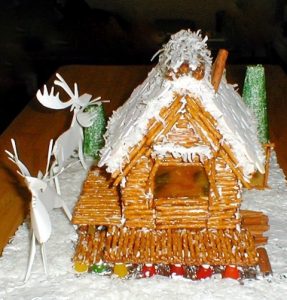 The Fremont County Pioneer Museum would like to display your gingerbread creation for the holiday season. The display will be in the Museum lobby from December 7th, 2019 thru January 2020.
The Fremont County Pioneer Museum would like to display your gingerbread creation for the holiday season. The display will be in the Museum lobby from December 7th, 2019 thru January 2020.
Entries will be due at the Pioneer Museum by December 2nd. This is not a competition, kits and non-edibles may be used and group projects will be accepted.
For more information or to register to participate contact Robin Allison, Collections Manager at 307-332-2273 or robinallisonpm@gmail.com or stop by the museum at 1443 W Main Street in Lander.
Need some inspiration? Think Fremont County 1919!!
Riverton Museum Installs New “Riverton Hero’s” Exhibit at Riverton Library
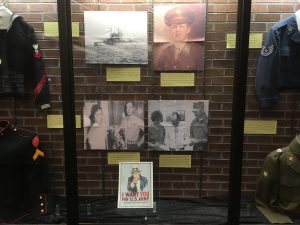 The Riverton Library contains an exhibit organized by the Riverton Museum near the entrance that rotates on a six month basis. The current exhibit on display at the library honors the local heroes of Riverton who served our country in the military.
The Riverton Library contains an exhibit organized by the Riverton Museum near the entrance that rotates on a six month basis. The current exhibit on display at the library honors the local heroes of Riverton who served our country in the military.
This exhibit features uniforms from four of the branches of the United States military which were worn by local Riverton heroes. One uniform was the United States Army uniform worn by Laurence J. Olheiser who was the former manager of the Riverton City Campground and former Post Commander at the Riverton VFW. This exhibit also includes blown up images from the Riverton Museum’s photograph collection and from newspaper clippings gathered from the Riverton Ranger.
One photograph pulled from the museum’s collection is a colorized photograph believed to be of Herman F. Stratton who served in the Air Force in World War II.
May 23, 2019
Camp Dubois POW Exhibit
At the request of Wyoming Tie and Timber Co., who faced a critical labor shortage, a group of 50 German prisoners of war arrived at Dubois in spring of 1944. These men came from a large POW camp in Scottsbluff, Nebraska to build a POW branch camp located about 12 miles west of town. June 2019 marks the 75th anniversary of these men’s arrival in the Upper Wind River Valley. To commemorate this unique part of history, the Dubois Museum installed an exhibit with original POW artifacts and photos that tell the story of “Camp Dubois.” What did they do? How long did they stay? What did townsfolk think about living down the road from their “enemies?” Stop by the Museum to find out!
Grand Opening of the Washakie Gallery
Twenty three epic paintings about the life of Chief Washakie by famed western artist J.K. Ralston will soon be on permanent display in the new Washakie Gallery at the Lander Pioneer Museum. The new gallery will also feature many Shoshone artifacts, and tell the story of Chief Washakie and his people.
The Grand Opening will be held June 1, from 4 to 6 p.m. and the public is invited. There will be light refreshments and a ribbon cutting at 4:30.
The paintings were acquired after a two year fund-raising effort led by the Fremont County Pioneer Association. Dozens of local people and many organizations generously donated money to keep the paintings here in Lander when they were in danger of leaving the state.
The paintings were commissioned by Harold Del Monte, owner of the Noble Hotel in 1945. Del Monte, an avid historian, wanted guests to experience western history while they stayed at his hotel. He amassed a large collection of Indian artifacts, had western style furniture made to create the feeling of a mountain lodge, and used western themes throughout the hotel.
He hired Montana artist J. K. Ralston to create a series of paintings about the life of Chief Washakie, who Del Monte recognized as one of the most important Wyomingites. Ralston, then at the beginning of his career, spent time in Lander researching the landscape and clothing of the Shoshone. He then painted twenty three large scale oil paintings. The paintings cover important parts of Washakie’s life from his becoming chief, to the battle of Crowheart Butte, the coming of white settlers, the creation of the reservation and his death as a revered leader. Ralston went on to become one of the major western artists and his work is highly sought after by collectors.
When the hotel closed in 1969 the paintings went in to storage. In 2015 the trust that owned the paintings approached the Lander museum about showing them and trying to keep them in Lander. “The community really stepped up with money and time to keep this part of our history here,” said museum Curator Randy Wise. “This is a major western art collection that has so many ties to this area: The Chief Washakie story, the connection to Lander and the Noble Hotel. It is an honor to be able to finally show the people of Lander what they put their money into keeping.”
With the creation of the Washakie Gallery, the museum will also be able to dedicate more space to the Arapaho people and their story, said Wise.
For more information visit us on Facebook at Pioneer Museum Lander Wyoming or call 307-332-3373.
photo credit: One of the Ralston paintings “The Battle of Crowheart Butte.”
February 15, 2019
Episode 2 of a ReDiscover the Winds: A Wyoming History Podcast
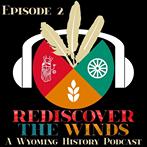 In episode 2 of Rediscover the Winds, Kirsten and Zach talk about life, love, and family in Fremont County's past. We share one love story of a big city girl who moved west to teach in a remote town in Wyoming. Then, we look at some tender letters written by a local dad to his twin girls as they went off and sought their fortune far away.
In episode 2 of Rediscover the Winds, Kirsten and Zach talk about life, love, and family in Fremont County's past. We share one love story of a big city girl who moved west to teach in a remote town in Wyoming. Then, we look at some tender letters written by a local dad to his twin girls as they went off and sought their fortune far away.
ReDiscover the Winds: A Wyoming History Podcast is focused on telling the stories of Wyoming through museum artifacts, expert interviews, and organizational partnerships.
February 5, 2019
For the Love of Water
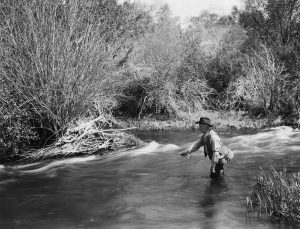 The Pioneer Museum in Lander will debut a new temporary exhibit to the public with a reception on February 16th from 4-6pm.
The Pioneer Museum in Lander will debut a new temporary exhibit to the public with a reception on February 16th from 4-6pm.
The exhibit is a partnership between Healthy Rivers, at Las, Popo Agie Conservation District, Popo Agie Gold, Lander Art Center, Lor Foundation and the Pioneer Museum.
The exhibit explores the historic importance of water in this region and its many uses. This exhibit will feature historic photos and artifacts and will also be on exhibit at the Dubois Museum and the Riverton Museum throughout 2019.
January 25, 2019
ReDiscvoer the Winds: A Wyoming History Podcast
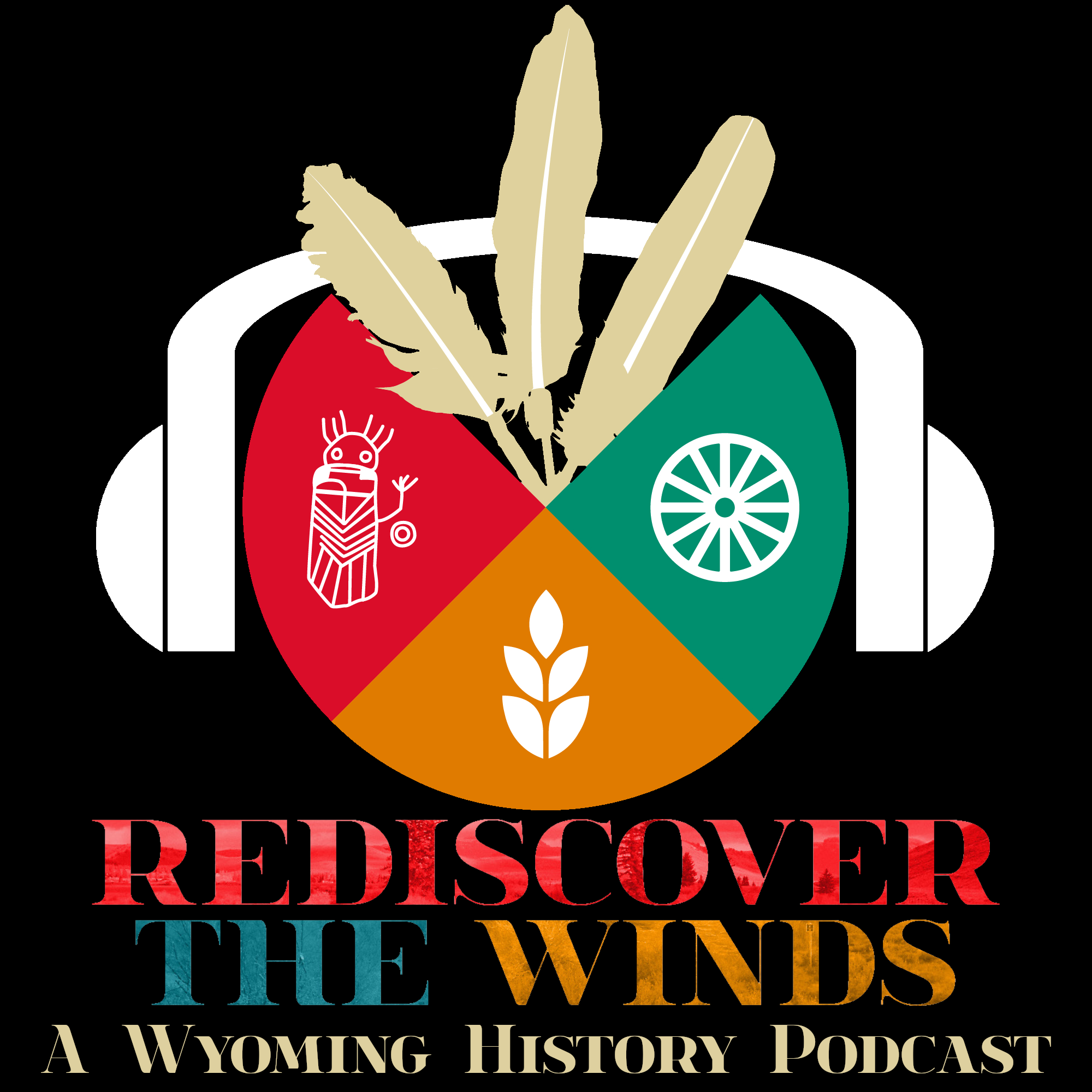
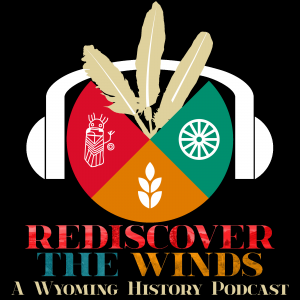 The Fremont County Museum System is excited to announce the creation of ReDiscover the Winds: A Wyoming History Podcast.
The Fremont County Museum System is excited to announce the creation of ReDiscover the Winds: A Wyoming History Podcast.
The Dubois Museum, Pioneer Museum in Lander and the Riverton Museum have teamed up to bring you the great stories, history and culture of the Wind River Region in a monthly podcast.
Each month the Museum's staff will bring you different aspects of the regions history. The podcast will be available on itunes, utube, soundcloud and the Fremont County Museums website. Be sure to like Rediscover the Winds: A Wyoming History Podcast on facebook.
https://www.facebook.com/rediscoverthewinds
https://www.soundcloud.com/rediscoverthewinds
January: Introduction to Fremont County in Wyoming
February: Love Letters
March: Women’s History Month (mini series)
April: Lander History/Industry
May: Riverton History/Industry
June: Dubois History/Industry
July: POW Camp Cheryl O’Brien
August: History of Tourism in Fremont County
September: Yellow Cake/Uranium
October: Lost Cabin/Other Abandoned Places
November: Native American Heritage Month (mini series)
December: 2019 Christmas Bird Count Anna Moscicki
January 16, 2019
Temporary Exhibit at Pioneer Museum Opens
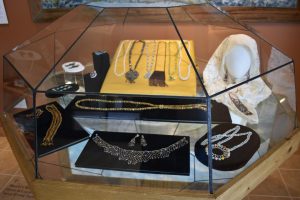 The Lander Pioneer Museum just opened a new jewelry display in the museum lobby.
The Lander Pioneer Museum just opened a new jewelry display in the museum lobby.
Mattie Ellan Darlington was a Lander woman who ran a local beauty shop and was a prolific jewelry maker. Dozens of her original handmade necklaces, ear rings, pins, bracelets and other pieces are on exhibit through the spring. This collection by Mattie Ellan Darlington represents her personal cultural influences and talents in her art as a beadworker.
Born in Byers,Texas, by the 1930s she was in Lander where she married Elmer Darlington. Mattie’s diverse work represents both European and Native American decorative design and reflects the mixed cultural influences she would have grown up with in western North America.
This collection and photograph was donated to the Fremont County Pioneer Museum by the grandchildren of Mattie Ellan Darlington.
January 15, 2019
Murder Mystery Night at the Riverton Museum is Back!
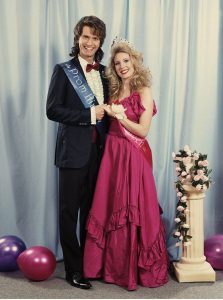 Want something fun and exciting to do during the cold days of February, or better yet to take your sweetheart out on an evening of mystery and murder the week before Valentine’s Day? The Riverton Museum will be hosting their second annual Night of Mystery event this coming February 9th. Join in on a fun evening solving the murder of one of the characters during the event.
Want something fun and exciting to do during the cold days of February, or better yet to take your sweetheart out on an evening of mystery and murder the week before Valentine’s Day? The Riverton Museum will be hosting their second annual Night of Mystery event this coming February 9th. Join in on a fun evening solving the murder of one of the characters during the event.
“We are very excited to be hosting a second Night of Mystery at the Riverton Museum. Our first event in 2018 was such a hit that we had several requests for another party and this year we have chosen Totally Rad 80s Prom – Gone Bad for this year’s theme. So pull out that bottle of aqua–net and tease your hair for this fun evening! All proceeds go to benefit the Riverton Museum to support our educational programs” stated Karline Stetler, Site Director for the Riverton Museum.
Tickets/character packets can be purchased at the Riverton Museum at 700 East Park Avenue, Monday through Saturday, 9am-5pm. There is a limited about of tickets so get yours before they sell out! We hope to see you on February 9th.
Call the Riverton Museum for details at 307-856-2665. Ticket include food and beverages during the event.
November 15, 2018
Simply Support participants volunteer at the Riverton Museum
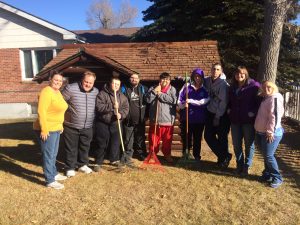 Cooler weather brings leaves that accumulate on the lawn, and create large piles. It makes you want to jump in like we did as children, hoping that there’s no surprises left from a pup or critter. Everyone in town is racing to get the leaves raked up before the winter weather brings in snow to cover the lawns until the spring. The Riverton Museum is no exception. Each year, leaves on the museum’s property need to be raked and taken to the Riverton Bale Station. This year, the Museum received well-welcomed help with their vast collection of leaves from Simply Support – a program designed for adults with developmental disabilities and acquired brain injuries.
Cooler weather brings leaves that accumulate on the lawn, and create large piles. It makes you want to jump in like we did as children, hoping that there’s no surprises left from a pup or critter. Everyone in town is racing to get the leaves raked up before the winter weather brings in snow to cover the lawns until the spring. The Riverton Museum is no exception. Each year, leaves on the museum’s property need to be raked and taken to the Riverton Bale Station. This year, the Museum received well-welcomed help with their vast collection of leaves from Simply Support – a program designed for adults with developmental disabilities and acquired brain injuries.
Simply Support visited the museum earlier in the fall. They learned more about the history of Riverton and the surrounding communities. Following a Seek n’ Find activity, staff with Simply Support inquired about volunteer opportunities for their participants. Cleaning up the leaves came to mind. “We were so appreciative that the participants at Simply Support wanted to help us with our seasonal yard work. With a small number of staff on hand and with so many projects on our plate, it is sometimes difficult to get this task done. Simply Support was generous enough to come in and help the Riverton Museum out,” stated Karline Stetler, the Museum’s site director.
The whole group – Simply Support and Riverton Museum staff – worked together to prepare the lawn for winter. Thanks to the help of Simply Support, the leaves were raked up in just under an hour! Amazing work! The Riverton Museum would like to send out thanks to all past and present community groups and individuals that have volunteered at the Riverton Museum to help out with a variety of projects. Thank You!
October 19, 2018
Zack Larsen: New Collections Manager at the Riverton Museum
 The Riverton Museum has happy to announce the hiring of the new Collections Manager. Zach Larsen comes to the Riverton Museum from the LDS Church History Museum in Salt Lake City. Zach has a B.A. History from Brigham Young University-Idaho and is currently finishing his M.A. History at the Utah State University.
The Riverton Museum has happy to announce the hiring of the new Collections Manager. Zach Larsen comes to the Riverton Museum from the LDS Church History Museum in Salt Lake City. Zach has a B.A. History from Brigham Young University-Idaho and is currently finishing his M.A. History at the Utah State University.
Zach grew up in Fremont County, where he cultivated an interest in Wyoming's history of petroleum, mining and energy production. He is currently researching and writing about Fremont County's Uranium indostry and the towns that it supported.
Zach says, "The Riverton Museum offered me a rare chance to work both in my chosen field, and in my area of expertise! I am very happy to be part of the Fremont County Museum team!"
Zach loves spending time with his wife and their two little boys. He also enjoys photography, relaoding, and shooting, and tinkering with old computers.
October 9, 2018
Ghost Stories and Haunted Tales Spook Audience Members at the Riverton Museum
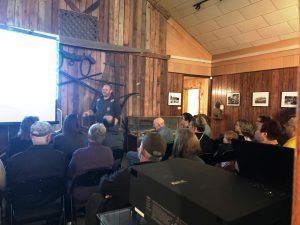 It was a full house at the Riverton Museum on Saturday, October 6th for one of their Discovery Speaker Series, sponsored through Wyoming Community Bank. For the month of October the program focused on ghost stories, urban myths, and legends of the Riverton and Fremont County area.
It was a full house at the Riverton Museum on Saturday, October 6th for one of their Discovery Speaker Series, sponsored through Wyoming Community Bank. For the month of October the program focused on ghost stories, urban myths, and legends of the Riverton and Fremont County area.
“This was a fantastic talk for this time of year,” stated Karline Stetler, site director for the Riverton Museum. “We had a full-house of community members from all over Fremont County that joined us for an hour of spooky tales. From the senior citizen to the ten-year old, everyone reported a great time.”
Alma Law, who is an English teacher at the Riverton High School, was the presenter for the afternoon where he spoke on his research on the various ghost stories from the area. Using photos via PowerPoint to help guide the presentation, Mr. Law regaled the audience with a number of haunting tales from around the area.
September 6, 2018
J.E. Stimson collection of Wyoming photographs on display at the Riverton Museum
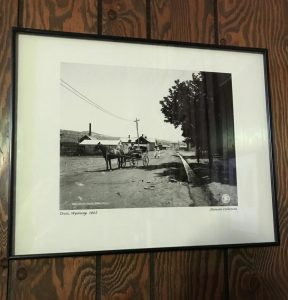 A traveling exhibit from the Wyoming State Museum is on display at the Riverton Museum that examines the work of photographer Joseph E. Stimson, who captured the beauty of Wyoming in the early 1900s. Stimson was noted throughout the United States for his artistic skills with a camera and his hand-colored photographs. Coming from humble beginnings in Virginia where he was born and raised Stimson soon joined two of his brothers in Cheyenne and started up a photography business there taking portraits. He was later asked to join the Union Pacific as their photographer.
A traveling exhibit from the Wyoming State Museum is on display at the Riverton Museum that examines the work of photographer Joseph E. Stimson, who captured the beauty of Wyoming in the early 1900s. Stimson was noted throughout the United States for his artistic skills with a camera and his hand-colored photographs. Coming from humble beginnings in Virginia where he was born and raised Stimson soon joined two of his brothers in Cheyenne and started up a photography business there taking portraits. He was later asked to join the Union Pacific as their photographer.
“I am really interested in this exhibit from the Wyoming State Museum. Joseph Stimson was given the opportunity to take photographs for the Union Pacific railroad as a publicity photographer which provided him the chance to travel across the state of Wyoming photographing various areas. The photographs on display are full of life and you can spend a good few minutes looking over each photograph because they are filled with so much detail” stated Karline Stetler, site director for the Riverton Museum.
Joseph Stimson’s career as a photographer spanned 59 years and he produced more than 7,500 images most of which reside in the Wyoming State Archives. The traveling exhibit on display at the Riverton Museum will run from the first of September into the second week of October where it will be packed up and returned to the Wyoming State Museum.
Stop by the Riverton Museum at 700 E Part Ave to take a look at this wonderful collection and enjoy more of Riverton's great cultural heritage.
July 30, 2018
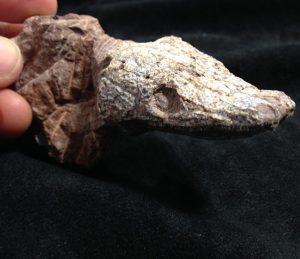 Beginning in 2013, University of Wisconsin-Madison's Geology Museum researcher Dr. David Lovelace began exploring the classic red rocks of the Triassic aged (~252-201 mya) Chugwater Group that are well exposed along the eastern flank of the Wind River mountains. These outcrops stretch from south of Lander all the way up to Dubois. The Late Triassic Popo Agie Formation is the uppermost unit of the Chugwater Group and is thought to be around 230-225 million years old. This formation is named after the Popo Agie River near Lander and it preserves extraordinary fossils that represent an ancient terrestrial ecosystem that thrived during the dawn of the dinosaurs.
Beginning in 2013, University of Wisconsin-Madison's Geology Museum researcher Dr. David Lovelace began exploring the classic red rocks of the Triassic aged (~252-201 mya) Chugwater Group that are well exposed along the eastern flank of the Wind River mountains. These outcrops stretch from south of Lander all the way up to Dubois. The Late Triassic Popo Agie Formation is the uppermost unit of the Chugwater Group and is thought to be around 230-225 million years old. This formation is named after the Popo Agie River near Lander and it preserves extraordinary fossils that represent an ancient terrestrial ecosystem that thrived during the dawn of the dinosaurs.
Lovelace, along with UWGM students have discovered a number of new specimens on both private and public lands throughout the region. Most of the fossils are still being extracted from the rock that has preserved them all this time. A new skull of a phytosaur - an ancient crocodile-like animal - was found on private land near Lander in 2013; it has been more than half of a century since the last phytosaur discovery in the state!
In 2014-2015 two sites were discovered near Dubois on public lands held in trust by the Bureau of Land Management. During the 2016 field season excavation was started and continued again this summer. Both of these sites preserve a mass-death assemblage of ancient temnospondyl amphibians that are most closely related to caecilians, a group of modern legless amphibians. The first site (known as Nobby Knob) has dozens of partially articulated skeletons of giant temnospondyls called Koskinonodon; these animals roughly resemble 6 foot long giant salamanders! The second site (known as Serendipity) preserves hundreds of burrows about the diameter and shape of a Pringles can, many of which preserve articulated skeletons of a new tiny temnospondyl species.
 This year the UW-Madison crew, led by Ph.D. student Aaron Kufner and Calvin So, are spending nearly 2 months documenting and excavating the Nobby Knob and Serendipity sites. Eventually the material that is being collected will be prepared and studied at the UWGM, and will be highlighted in the museum's gallery. It will take years to complete the preparation (it takes about 12-15 person-hours of lab work for every person-hour in the field). Future collaborations with the Fremont County Museums are being developed, so stay tuned!
This year the UW-Madison crew, led by Ph.D. student Aaron Kufner and Calvin So, are spending nearly 2 months documenting and excavating the Nobby Knob and Serendipity sites. Eventually the material that is being collected will be prepared and studied at the UWGM, and will be highlighted in the museum's gallery. It will take years to complete the preparation (it takes about 12-15 person-hours of lab work for every person-hour in the field). Future collaborations with the Fremont County Museums are being developed, so stay tuned!
July 23, 2018
Fremont County Museums Take Part in High Plains American Indian Research Institute Project
The Fremont County Museums are sharing artifacts in a project to help understand and communicate the role of Elk on the Wind River Reservation.
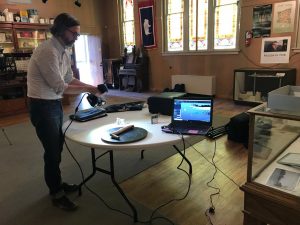 The project, run by the High Plains American Indian Research Institute, the Wyoming Humanities Council and Wyoming School districts #14 and #21 is examining the role that Elk have in the culture of Native American people. Tribal members will play a lead role in incorporating the information into schools and communities on the Wind River Indian Reservation, and the work will help serve as a model to incorporate Native American curriculum throughout Wyoming schools as envisioned by the recent Indian Education for All legislation.
The project, run by the High Plains American Indian Research Institute, the Wyoming Humanities Council and Wyoming School districts #14 and #21 is examining the role that Elk have in the culture of Native American people. Tribal members will play a lead role in incorporating the information into schools and communities on the Wind River Indian Reservation, and the work will help serve as a model to incorporate Native American curriculum throughout Wyoming schools as envisioned by the recent Indian Education for All legislation.
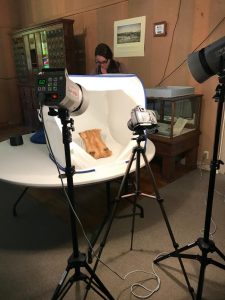 They visited all three Fremont County Museums (Dubois Museum, Pioneer Museum in Lander, Riverton Museum) this week to examine and do high resolution 3D scans of a variety of artifacts made of elk hide, bone and teeth.
They visited all three Fremont County Museums (Dubois Museum, Pioneer Museum in Lander, Riverton Museum) this week to examine and do high resolution 3D scans of a variety of artifacts made of elk hide, bone and teeth.
At the Lander museum a team used state of the art equipment to scan and record Elk hide gauntlets, necklaces made from Elk ivory and other items. The Riverton Museum has two artifacts that were part of the project, an elk antler hide scraper, and a hide purse made out of elk skin. The Dubois Museum participated in the project with a painted elk hide and a beaded elk hide jacket.
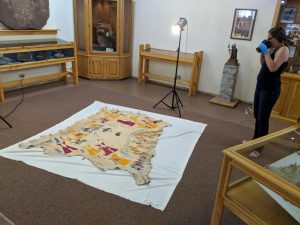 The photographs and video recorded will be added to the Elk Culture Collection in the care of the High Plains American Indian Research Institute and will be available to everyone. The project has received financial support from the National Endowment for the Humanities (NEH) to the University of Wyoming. Private fundraising is underway for UW to match the $150,000 NEH award.
The photographs and video recorded will be added to the Elk Culture Collection in the care of the High Plains American Indian Research Institute and will be available to everyone. The project has received financial support from the National Endowment for the Humanities (NEH) to the University of Wyoming. Private fundraising is underway for UW to match the $150,000 NEH award.
July 20, 2018
Fremont County Museum Board Welcomes Mike Zirbel of 307 Financial
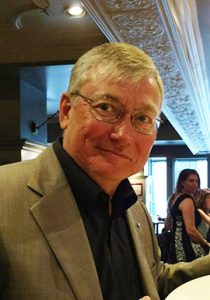 Born in Wisconsin raised and educated in Northern Minnesota I moved to Montana where I ran a small business selling agricultural equipment. There I gained a respect for ag and small business and a love of the Northern Rocky Mountain Region. Thirty six years ago I came to Fremont County with my degree in finance and economics and began my career as a financial advisor. I still enjoy my job, the people I serve and this community. Fremont county and Riverton in particular has been a good place to live and raise my four children who have grown to become fine productive young adults.
Born in Wisconsin raised and educated in Northern Minnesota I moved to Montana where I ran a small business selling agricultural equipment. There I gained a respect for ag and small business and a love of the Northern Rocky Mountain Region. Thirty six years ago I came to Fremont County with my degree in finance and economics and began my career as a financial advisor. I still enjoy my job, the people I serve and this community. Fremont county and Riverton in particular has been a good place to live and raise my four children who have grown to become fine productive young adults.
My motivation to be on the County Museum Board is twofold. One, I enjoy history, the stories of how we came to be the community we are is fascinating to me and stories that I think should be shared with anyone willing to listen. If we can learn to tell those stories to more people in a more effective and interesting way our museums become a more valuable asset to our county. Secondly, I am concerned for the future of our Fremont County communities. With the advent of internet commerce our towns become less important as retail centers. So what then do we become? One of the answers I think is that we become social and cultural centers. That is where museums come in. Museums are not just valuable sources of education but also a reason to come to town and a reason to get together. I hope that my experience gained on numerous community boards and organizations will help make that happen.
Mike Zirbel
July 18, 2018
Riverton Museum Seeks Part Time Museum Assistant
Museum Assistant – Part Time (8 hours a week/$10 per hour)
- Assist Riverton Museum Site director with daily operations of museum
- Assist Riverton Museum Collections Manager with collection operations
- Assist in the gift shop with costumer purchases
- Light cleaning of the museum (vacuum, dust, sweep, bathrooms, etc.)
- Greet visitors as they come in
- Be a presence in the museum as well as the gift shop when visitors are in
- Must be flexible with hours/ come in when scheduled
- Assist visitors with any questions that they may have about the museum, exhibits, gift store, local amenities; promote community events and activities
- Assist in the manual transfer of collection records
- Assist with back-log cataloging, under the direction of the Collection’s Manager
- Assist with research requests
- Other duties assigned by Site Director
Qualifications/Experience
- High School education or attaining education (high school, college, etc.)
- Ability to work in a team environment
- Organization skills a plus
- Computer literacy skills
- Experience with Mac computers
- Experience with Dell computers
- Experience with scanning software
- Knowledge of Riverton’s history a plus
Contact the Riverton Museum at 307-956-2665 to apply.
July 17, 2018
Riverton Museum To Hire Collections Manager
Collections Manager: Riverton Museum, Riverton WY. Open until filled
The Riverton Museum in Riverton, WY seeks an energetic professional to manage the collections for one of Fremont County’s three Museums. This individual will work collaboratively with other museum staff and other museum professionals within the Fremont County Museum System.
Position Description
Collections Manager
- Oversee all aspects of collection management including planning, care, loan requests, conservation, accessions, storage, research, exhibits etc.
- Perform historic research and assist with research requests
- Manage part time staff, volunteers, interns
- Work collaboratively with FCMS staff to advance the mission of all three county museums
- Deliver talks and lectures for public programs and special events
- Assist with educational initiatives for various Museum audiences which may include developing and leading public curatorial and gallery talks, meeting with classes and other written materials for various audiences.
- Assist in planning and implementation of special events
- Work with museum support groups to promote and advance the mission of the museum
- Ability to research and write professional historic journal articles
- Archival experience a plus
Qualifications/Experience
- Minimum Bachelor’s Degree in museum studies, history, art history, American Studies or related field:
- 1-2 years of curatorial experience preferred
- Ability to work in an environment where teamwork professional respect, personal ethics and character are the foundation for achievement
- Excellent organizational skills, computer literacy skills, preferred Past Perfect experience
- Candidate must possess effective oral and written communication skills and the ability to effectively manage multiple staff and volunteers.
- Published writer a plus
- Exhibit and Interpretation experience preferred
Compensation/Benefits
- $27,700/year plus very competitive benefit package that includes excellent retirement, health insurance, 10 paid holidays per year, sick leave and vacation leave.
Applicants
- Send, resume, cover letter and 3 professional references and unofficial transcripts to Fremont County Museums, Central Director, Scott Goetz, 450 N 2nd Rm 320 Lander, WY 82520 or email to scott.goetz@fremontcountywy.gov
July 10, 2018
FC Museum Board Meeting
The Fremont County Museum Board will hold its monthly meeting Juyly 12th at the Dubois Museum. The work session will be at noon and the regular meeting will begin a 1pm.
June 28, 2018
Dubois Museum Completes Extensive Exhibit Changes
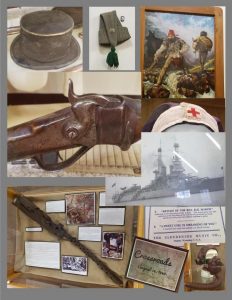 The area known as “Dubois” today acts a main crossroads for all of life, and the Dubois Museum tells the “crossroads” story through several new exhibits. “The addition of artifacts from the James D. and Iva Mae Stewart Collection, most notably the firearms collection, has made it possible for us to tell a better story about the crossroads that is now Dubois.” says Johanna Thompson, Site Director.
The area known as “Dubois” today acts a main crossroads for all of life, and the Dubois Museum tells the “crossroads” story through several new exhibits. “The addition of artifacts from the James D. and Iva Mae Stewart Collection, most notably the firearms collection, has made it possible for us to tell a better story about the crossroads that is now Dubois.” says Johanna Thompson, Site Director.
“Crossroads 1820s-1840s” talks about the Fur Trade era. Items on display include two authentic beaver fur hats, a Russian model 1819 musket from the James D. and Iva Mae Stewart Collection, and several other mountain man artifacts. There is also a painting depicting life of the Fur Trade by the local artist John Phelps.
Buffalo are the center of attention in the Museum’s “Crossroads 1840s-1880s” exhibit. Displayed alongside a buffalo hide coat is an 1874 Sharps Rifle. Also called a “Buffalo Gun,” this firearm could have certainly killed buffalo, but it is not likely the hunting of huge numbers of buffalo actually happened in the Dubois area. Still the demand for buffalo hides and the extensive trade routes that existed found their way to and through Dubois.
Many historical institutions in the United States celebrated the 100th anniversary of World War I, including the Dubois Museum. “Crossroads 1914-1918” illustrates the different activities people did on the Home Front. From practicing food conservation to holding book drives, the people of Wyoming did their part. A Red Cross veil, part of the CM Ranch Collection, and WWI sheet music, including a piece written and published in Dubois by the Clendening Music Co., create a diverse image of the home front for visitors to view.
The Museum’s newest exhibit reflects on the day an Army B24 Liberator bomber entered the crossroads of Dubois and never left. “Crossroads August 14, 1943” has a great deal of information about the history of the crew and aircraft of the ill-fated flight. One of the .50 caliber machine guns recovered from the sight along with the records of eyewitnesses who saw the large bomber before it crashed is on display. This year marks 75 years since the crash that changed the name of Henton Basin to Bomber Basin.
Explore these new exhibits and relive some older ones this summer at the Dubois Museum!
June 27, 2018
5 Roads in America That Define Adventure
There is a great article on Carrentals.com that features the Centennial Scenic Byway in Wyoming (Wyoming Highway 26 over Towagatee Pass). Check it out.
June 21, 2018
Tom Woodyard: Advocate & Benefactor
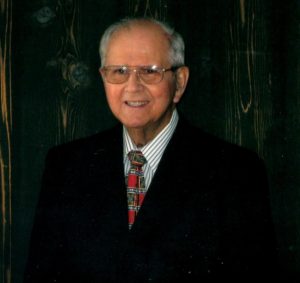 The Riverton Museum is extremely grateful to Tom Woodyard for his bequest to the Riverton Museum this past year. The positive impact of Mr. Woodyard's extremely generous gift on the Riverton Museum cannot be understated. It is so important for productivity and the sustainability of the museum to receive these kind of gifts.
The Riverton Museum is extremely grateful to Tom Woodyard for his bequest to the Riverton Museum this past year. The positive impact of Mr. Woodyard's extremely generous gift on the Riverton Museum cannot be understated. It is so important for productivity and the sustainability of the museum to receive these kind of gifts.
The Woodyard family provide the following information about Mr. Woodyard so members of the community would have a better sense of who he was. Many thanks to Mr. Woodyard and his family for their support and caring for the Riverton Museum.
"Tom Woodyard came to Riverton in 1958 as a 6th grade teacher. He enjoyed the people, lifestyle, and cool weather and was able to remain in his home until his death in October 2016. He was a native of Coles County, Illinois and maintained close ties to his family and friends there. Immediately after receiving his Masters degree from the University of Illinois, he was drafted and served proudly in the Army during the Korean War. He spent three years in Northern Arizona as a teacher and as a Seasonal Ranger at the Grand Canyon.
His Riverton teaching career spanned about twenty-five years and influenced many young people. He was an active member of the United Methodist Church and enjoyed other community activities. As family historian and genealogy researcher, he wrote and published two family books. He enjoyed traveling and was a lifelong learner with many interests. With his numerous charitable bequests his legacy continues."
Thanks,
Judy
May 25, 2018
New Children’s Exhibit Opening in the Riverton Museum
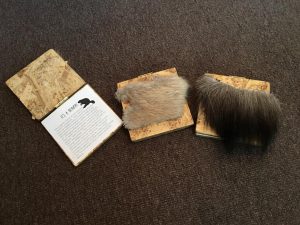 The staff at the Riverton Museum is proud to announce the grand opening of their new Hands on History room for children. This room is designed with younger children in mind (suggested ages range from 2 years to 3rd grade), however anyone is welcome to come in and enjoy what the room has to offer. Displays such as “Who’s Fur is This?” feature hands on interactive and educational items where kids are not only welcome to touch but encouraged to.
The staff at the Riverton Museum is proud to announce the grand opening of their new Hands on History room for children. This room is designed with younger children in mind (suggested ages range from 2 years to 3rd grade), however anyone is welcome to come in and enjoy what the room has to offer. Displays such as “Who’s Fur is This?” feature hands on interactive and educational items where kids are not only welcome to touch but encouraged to.
“Small town museums get a bad rep sometimes because of our “don’t touch” policies but with this room that no longer applies. We’re so excited to offer this unique experience to families especially those with young children. This room has been a labor of love for the staff and we are excited to be unveiling it to the world.”
The room will open with at least 4 interactive activities with more slated to come within the following months/years. The room will have some permanent exhibits with the rest being flexible and able to change as time goes by.
The opening exhibits will include a Weaving Loom, a 1950s typewriter, a touch and feel station for kids to feel animal furs, and a history road map with interactive magnates. There will also be coloring pages and books available for the smaller children to play with while their older siblings learn and play with the other exhibits.
The opening day for this new room will be Friday, June 1st. Free admittance to the museum will be available all day from 9am-5pm for families with children. As part of the grand opening from 1pm-2pm the Riverton Librarians will be having a special craft in the basement of the museum.
May 23, 2018
Yearbook Annuals Digitized through the OCI Yearbook Project now at the Riverton Museum
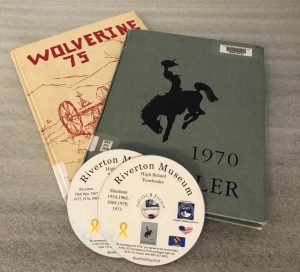 Fremont County residents can now take a walk down memory lane, browsing through Riverton High School and Shoshoni High School yearbooks via PDF format on a DVD. Several years of Riverton and Shoshoni school annuals were digitized by the Oklahoma Correctional Institution (OCI) at no cost. The annuals were sent out, digitized and later returned with a DVD copy.
Fremont County residents can now take a walk down memory lane, browsing through Riverton High School and Shoshoni High School yearbooks via PDF format on a DVD. Several years of Riverton and Shoshoni school annuals were digitized by the Oklahoma Correctional Institution (OCI) at no cost. The annuals were sent out, digitized and later returned with a DVD copy.
“After I spoke with a few other libraries in Wyoming who used the project to digitize their collection of yearbooks, I determined it would be a worthwhile project to help preserve our counties history as well as provide another avenue for researchers that are unable to come to our museum to conduct research,” said Karline Stetler, site director and curator at the Riverton Museum. “While the project is currently only covering the 1950s and upward we are hoping they will move towards the older annuals in the future.”
The yearbooks digitized so far from Riverton are the years 1960 thru 1967, 1975, 1976, and 1989. Shoshoni annuals digitized were 1954, 1968 thru 1970 and 1973. “When we get more annuals in to help fill in those missing years we will send them out to OCI to be digitize which will help further preserve our history,” said Karline Stetler.
If anyone would like to contribute to this project and help the Riverton Museum with the missing years they can contact the museum at 307-856-2665 or stop in at 700 East Park Avenue. The DVDs are available for browsing at the Riverton Museum, Monday thru Saturday, 9:00 AM thru 5:00 PM.
May 15, 2018
The Wild Bunch Discussion with George Yarbarough
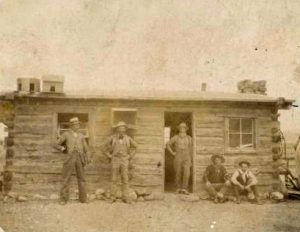 Wyoming Community Bank Speakers Series: The Wild Bunch Discussion: Saturday, May 19, 7pm, Dennison Lodge
Wyoming Community Bank Speakers Series: The Wild Bunch Discussion: Saturday, May 19, 7pm, Dennison Lodge
George Yarbarough was raised in the Brooks Lake, Dunior Valley, Crowheart and Dubois areas. He currently is a volunteer docent at the Pioneer Museum in Douglas, Wyoming.
The Johnson County War and the Wild Bunch are among the top questions that George receives at the museum. The Johnson County War was an attempt by the then ruling class of individuals to stop the newcomers or settlers from changing the game by maintaining the status quo, to freeze time in 1892. Similar examples include Crazy Horse and Sitting Bull trying to halt change in the 1870s, Red Cloud in the 1860s and prior to those times, the Crow tribe resisting the advance of the Sioux and their allies in the early 1800s.
By the late 1800s, might was right: the law of the land was the golden rule, he who has the gold...rules. The once all powerful, absentee, overseas owners of the large, public-land-based livestock operations had been wiped-out by the dry summer of 1886, followed by the hard winter of 1886-1887; only to be replaced by their ex-employees who, knowing an opportunity, were not going to accept new neighbors or homesteaders without a fight. The new arrivals were in direct competition for the limited natural resources, a bloody conflict resulted with many unrecorded atrocities committed by both sides, and desperate people do desperate deeds. When did the Johnson County War end? George thinks it is still occurring...just with lawyers not guns.
The Wild Bunch was a group of loosely organized, well-mounted outlaws that operated mainly in the Rocky Mountain region. The gang could not have moved around the rough terrain so easy without help from the locals, much like Robin Hood. One man’s terrorist is another man’s freedom fighter. Good men can do bad things and bad men can do good things. Did the Johnson County War influence the bandits and their friends? Without a doubt!
Please come share your stories and learn some history with George and everyone else on Saturday, May 19 at 7pm, at the Dennison Lodge. For more information contact the Dubois Museum, 909 West Ramshorn, 307-455-2284 or by email at duboismuseum@gmail.com.
Explore future Dubois Museum events including Wednesday, June 6th, “Create Your Own Fossil”, with Tate Geological Museum.
Photo Caption:
Back of the photo says, “Post Office for Dubois about 1894. Gene Amoretti, Hughey Youman, Lasso Bill?, Butch Cassidy”. The photo also says it belongs to Frankie Moriarty.
Photo credit:
Dubois Museum
May 10, 2018
New Deal documentary featuring Riverton mural to screen June 7th
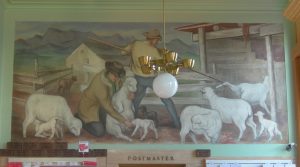 A new documentary about five New Deal era muralists is complete and ready for viewing. “Wyoming Art Matters: The New Deal Artist Public Art Legacy” features stories about Eugene Kingman, Manuel Bromberg, George Vandersluis, Louise Emerson Ronnebeck and Verona Burkhard.
A new documentary about five New Deal era muralists is complete and ready for viewing. “Wyoming Art Matters: The New Deal Artist Public Art Legacy” features stories about Eugene Kingman, Manuel Bromberg, George Vandersluis, Louise Emerson Ronnebeck and Verona Burkhard.
A screening is set for Thursday June 7th at the Riverton Museum. This year marks the 85th anniversary of the New Deal.
The mural in Riverton by George Vander Sluis is entitled “Farm Scene". It was completed in 1942," according the Riverton Museum Site Director Karline Stetler, who is also featured in the documentary. Also at the screening will be Northern Arapaho muralist Robert Martinez of Riverton.
“This is one of those documentary projects that kept getting more interesting the further I got into it,” Producer Alan O’Hashi said of the nearly three year production. “It became a labor of love that took me cross country from California to New York.”
In February 1942, the New Deal Treasury Section of the Arts invited George Vander Sluis of Colorado Springs to submit designs for a mural that would go in Riverton.
The 13×6 foot painting, completed some eight months later, was the last Treasury Section job done in Wyoming. Vander Sluis was picked for the $850.00 Riverton assignment on the basis of an entry he had submitted for a Denver mural competition.
By this time, the country was involved in World War II and complicated the Riverton commission in two ways. The artist was pressed to complete his work before military induction and the Section itself was unsure of its mission, in the new wartime setting.
Each installed mural, in five Wyoming communities - Kemmerer, Riverton, Powell, Greybull and Worland (relocated to Casper, Wyoming).
O’Hashi interviewed relatives or individuals who knew the artists.
“I wanted to get insight into the life of the artist, rather than just historical facts. I was able to catch up with Denver art dealer Norm Anderson who handled many of the Colorado works of George Vander Sluis."
The project funded by the Wyoming Arts Council, the Wyoming Cultural Trust and the Wyoming Humanities Council was completed in time to commemorate the 85th anniversary of the New Deal. For information about screenings contact the Riverton Museum at 307-856-2665.
May 2, 2018
Burlison’s Drugstore Exhibit at Riverton Library
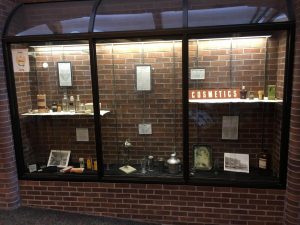 The staff at the Riverton Museum recently installed their 9th temporary exhibit at the Riverton Branch Library. The exhibit features artifacts and photos inspired by the history of pharmacies in America as well as some of the history behind Soda Fountains and Milkshakes in pharmacies and drugstores.
The staff at the Riverton Museum recently installed their 9th temporary exhibit at the Riverton Branch Library. The exhibit features artifacts and photos inspired by the history of pharmacies in America as well as some of the history behind Soda Fountains and Milkshakes in pharmacies and drugstores.
The exhibit also touches on one of Riverton’s best known drugstores, the Burlison’s Drugstore. As many residents might remember Burlison’s Drugstore was one of the oldest drugstores in the state of Wyoming and was family owned and operated until it closed in the 60’s. A collection of items from the store is now housed in the Riverton Museum and a few of those items are included in this new exhibit at the library.
This new display will be up until October of this year
April 19, 2018
Historic Pipe Exhibit at Pioneer Museum
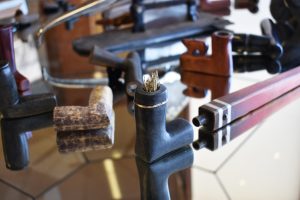 A pipe is not just an instrument used for smoking; it is as much a form of art and a cultural symbol of friendship, hospitality and peace. A new exhibit at the Lander Pioneer Museum explores historic pipes, many used by Native American people, soldiers and pioneers. The oldest pieces in the exhibit are hundreds of years old, the most recent pipes date from the 1870's.
A pipe is not just an instrument used for smoking; it is as much a form of art and a cultural symbol of friendship, hospitality and peace. A new exhibit at the Lander Pioneer Museum explores historic pipes, many used by Native American people, soldiers and pioneers. The oldest pieces in the exhibit are hundreds of years old, the most recent pipes date from the 1870's.
Pipe smoking in North America may go back as far as 3000 years. People who lived in regions where tobacco was a native perennial plant utilized the plant for its narcotic properties.
Tobacco was used for leisure, for medicine, as an appetite suppressant, for ceremonial and religious ceremonies. These people traded or gifted tobacco to people from other regions who they encountered.
The first European explorer’s to the America’s encountered people who used smoking and tobacco in their cultural practices. These explorers brought tobacco and pipe smoking back to Europe.
Referred to as ‘tobacco drinking’, by the early 1700's the pipe making and tobacco cultivation industry was developed.
Tobacco became a form of currency and pipes were mass produced in both the United States and Europe.
Some of the clay pipes on display were made in Ohio and the Carolinas, then brought west by Mountain Men and other traders. Soldiers stationed on the frontier often smoked and would bring pipes with them from the east or buy them at fort sutlers. Several pipes on display were found along the Oregon Trail near South Pass and were likely used by pioneers along the trail, or soldiers that patrolled the trail.
A traditional twist or plug of tobacco is on exhibit. It was easier to store and transport the plant that way in the early days of Westward expansion. Tobacco was an important trade good between tribes, and between white merchants and Native Americans as well as settlers.
On display are a large number of Native American pipes, many from this area. Native people smoked tobacco (often traded over long distances from other tribal groups), and other native plants depending on the ceremony.
The exhibit shows a wide variety of Native American pipe materials, from catlinite, a reddish stone, to clay, steatite (a soft easily carved stone) or metal.
photos:
Chief Washakie, leader of the Shoshone people holding a ceremonial pipe.
Boney Earnest (with pipe) and his wife Mattie who ranched along the Sweetwater River.
Part of the new pipe exhibit at the Pioneer Museum in Lander.
March 26, 2018
World War I Posters Exhibit at Dubois Museum
 Dubois, Wyoming - Fort Caspar Museum has organized an exhibit of World War I-era posters to commemorate the 100th anniversary of the U.S. entry into that global conflict. The posters were created for a domestic audience and depict activities Americans were encouraged to undertake stateside to support the war effort overseas. "Home Front Posters of the Great War, 1917-1918" consists of thirty framed copies of posters in the collection of the National World War I Museum and Memorial in Kansas City and will be on view at the Dubois Museum now through April 21st.
Dubois, Wyoming - Fort Caspar Museum has organized an exhibit of World War I-era posters to commemorate the 100th anniversary of the U.S. entry into that global conflict. The posters were created for a domestic audience and depict activities Americans were encouraged to undertake stateside to support the war effort overseas. "Home Front Posters of the Great War, 1917-1918" consists of thirty framed copies of posters in the collection of the National World War I Museum and Memorial in Kansas City and will be on view at the Dubois Museum now through April 21st.
“Uncle Samuel’s Sons are on Their Way” by HM Clendening and produced by Clendening Music Co. Dubois, WY in 1918, sheet music is on display along with others. For an extra treat, visitors can sample audio clips of the sheet music on an interactive tablet. The tablet also has a speech by James Watson Gerard, American Ambassador to Germany during World War I. The exhibit also highlights the USS Wyoming and the important role that books played on this magnificent battle ship. During WWI everyone got involved in the fight, and on the home front certain food items were limited if they could not be totally removed from daily life. The Red Cross was becoming the organization that we know today and on display is a period appropriate Red Cross uniform veil.
After the exhibit closes in Dubois, the exhibit will continue to travel around Wyoming and the next stop will be Powell. Communities in our state that will or have hosted the posters to display are Wheatland, Cheyenne, Laramie, Green River, Pinedale, Evanston, Alpine, Dubois, Powell, Riverton, Sheridan, and Gillette. The exhibit is sponsored by Wells Fargo Bank, the Fort Caspar Museum Association, and the Casper Memorial VFW Post 9439 & Auxiliary.
Dubois Museum's hours are 9:00 am to 5:00 pm Monday through Saturday. For more information, call the Museum at 307-455-2284 or stop by at 909 W. Ramshorn, Dubois, WY 82513
March 16, 2018
Barber and Beauty Shops in 1940’s Lander
 In 1940 the Lander High School (then known as the Fremont County Vocational High School) Social Studies classes put together a lengthy report on life in Lander in the late 1930s and 1940. 150 students participated, interviewing old timers, business leaders and others. The purpose of the report was “to develop an interest in local history and an understanding of local problems and agencies and to place the information where it might be readily accessible.
In 1940 the Lander High School (then known as the Fremont County Vocational High School) Social Studies classes put together a lengthy report on life in Lander in the late 1930s and 1940. 150 students participated, interviewing old timers, business leaders and others. The purpose of the report was “to develop an interest in local history and an understanding of local problems and agencies and to place the information where it might be readily accessible.
The book length report is a fascinating snapshot of Lander at that time, showing many differences from life in the town today.
Two chapters in the book detail barber and beauty shops in the community. Jim Trimmer wrote his report on barber shops. He reported that there were five barber shops in Lander (there is only one today) in 1940, employing eight people. Barbers did haircuts, shaves, shampoos, neck trims and massages, and made $100 to $150 a month.
One of the purposes of the project was to learn about jobs, how to get them and what training it took. Trimmer reported that a training course for barbers lasted six months and cost $100 for tuition, opportunity for advancement was limited unless you opened your own shop, and that barbers worked long hours.
Ruth Ansell and Betty Newinger wrote their chapter on Lander Beauty parlors. There were seven in Lander in 1940, two in private homes and the others on or near Main Street. They included Bett’s Beauty Shop, Fremont Beauty Shop, Yocum’s Beauty Shop, Dolorese’s Beauty Shop and Mary Janes Beauty Shop.
There were two employees in each shop, except for the ones in people’s homes, and operators had to train for nine months and pass a state of Wyoming test before they could open a shop.
The price for permanents was $2.50 to $6.00. The more expensive permanent was machineless.
In 1940 there were two dry cleaning shops in Lander and one laundry, employing 19 people. Ironers got $10 to $12 a week, while pressers earned $16 a week, the delivery man $17 a week and washers $20 a week.
Next up for the Fremont County Museums
March 17th, 3pm at the Riverton Museum, “Russell Hawley: The Feathered Dinosaurs”
Wyoming Community Bank Discovery Speakers Series
April 14th, 2pm at the Riverton Museum, “Rabbit Hide Painting”
McDonald’s Children’s Exploration Series
April 19th, 7:00pm at the Pioneer Museum, “150 Year Anniversary of Atlantic City” by Bob Townsend
Wyoming Community Bank Discovery Speakers Series
April 21st, 1-3pm at the Pioneer Museum, “Sheep Shearing Day”
McDonald’s Children’s Exploration Program
The Dubois Museum, the Pioneer Museum in Lander and the Riverton Museum need your financial support. In the current economic environment the museums are more reliant than ever on donations from the private sector to continue to provide the quality programs, collections management, exhibits and services that have become their hallmark over the last three and half years. Please make your tax deductible contribution to be used specifically for the benefit of the museum of your choosing by sending a check to Fremont County Museums 450 N 2nd Rm 320 or taking it directly to the museum you choose to support.
photo: The interior of Trimmers Barber shop around 1940.
March 8, 2018
FC Board Meeting Postponed
The regular meeting of the Fremont County Museum Board is postponed due to lack of quorum until March 15th with the work session at noon and the meeting at 1:00 at the Riverton Museum. Sorry for the inconvenience.
March 1, 2018
Bille’s Market
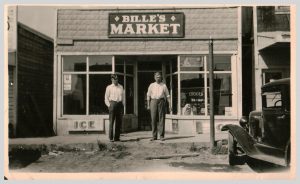 Over the years dozens of small businesses made Lander’s Main Street their home. The Lander Pioneer Museum recently received a donation of photographs, ledgers, a safe, meat cutting tools and more from Bille’s Market. Located in the 200 block of South Main, Bille’s market sold a little of everything. It was a butcher shop, sold tinned food and oil.
Over the years dozens of small businesses made Lander’s Main Street their home. The Lander Pioneer Museum recently received a donation of photographs, ledgers, a safe, meat cutting tools and more from Bille’s Market. Located in the 200 block of South Main, Bille’s market sold a little of everything. It was a butcher shop, sold tinned food and oil.
According to people that still remember him, Hans Bille had a kind heart and extended credit to people that needed it, especially during the Depression. Many of these customers were then unable to pay, which caused the Market to struggle financially. He also gave credit and did business with Native Americans, when many other Lander businesses wouldn’t at that time. Bille’s Market operated until 1956 when it had to close.
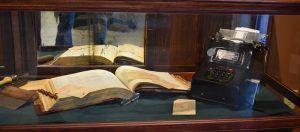 Some of the items from Bille’s Market are on display at the museum in a lobby display through the spring.
Some of the items from Bille’s Market are on display at the museum in a lobby display through the spring.
February 27, 2018
Rodger Weitzel: Cowboy Poet Recites Poems from Latest Book at Pioneer Museum in Lander
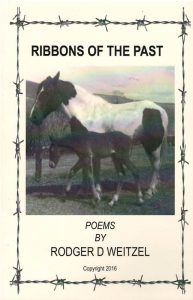 Cowboy Poetry by Rodger Weitzel at the Lander Pioneer Museum Saturday March 3, at 6:30 p.m.
Cowboy Poetry by Rodger Weitzel at the Lander Pioneer Museum Saturday March 3, at 6:30 p.m.
The Pioneer Museum in Lander kicks off its 2018 Speakers Series March 3 with a program by respected local cowboy poet and author Rodger Weitzel.
Weitzel is known for his humorous and poignant poems about life in the Lander Valley from an old time cowboy perspective. Some of his well known poems are “The Fremont” about the old Fremont Hotel in Lander and “Memories in Mother’s Trunk.”
Weitzel was born in Nebraska. One of a family of 8, they raised horses. He moved to Wyoming at age 16 and continued to cowboy. After serving in Vietnam, Weitzel came back to Wyoming and began writing. His new book “Ribbons of the Past” came out last year and signed copies will be available at the program.
The program is part of the Wyoming Community Bank Speakers Series at the museum. The series will feature speakers and programs on the area’s culture and history at all three county museums throughout the year. The programs are free and open to the public.
The next events at the Lander Museum will be a talk on the 150th anniversary of Atlantic City, April 19 at 7 p.m. and the museum’s annual Sheep Shearing Day Saturday April 21. For more information call the museum and 307-332-3373, or on Facebook at: Pioneer Museum Lander Wyoming or on the web at www.fremontcountymuseums.com
February 22, 2018
Cowboy Poetry By Rodger D. Weitzel
 Noted Lander author and poet Rodger Weitzel is known for his humorous and poignant poems about life in the Lander Valley from an old time cowboy perspective. Some of his well-known poems are “The Fremont” about the old Fremont Hotel in Lander and “Memories in Mother’s Trunk.”
Noted Lander author and poet Rodger Weitzel is known for his humorous and poignant poems about life in the Lander Valley from an old time cowboy perspective. Some of his well-known poems are “The Fremont” about the old Fremont Hotel in Lander and “Memories in Mother’s Trunk.”
Weitzel was born in Nebraska. One of a family of 8, they raised horses. He moved to Wyoming at age 16 and continued to cowboy. After serving in Vietnam, Weitzel came back to Wyoming and began writing. His new book “Ribbons of the Past” came out last year and signed copies will be available at the program.
This program is part of the Wyoming Community Bank Discovery Speakers Series and is open and free to the public.
February 14, 2018
Murder and Mayhem at the Riverton Museum
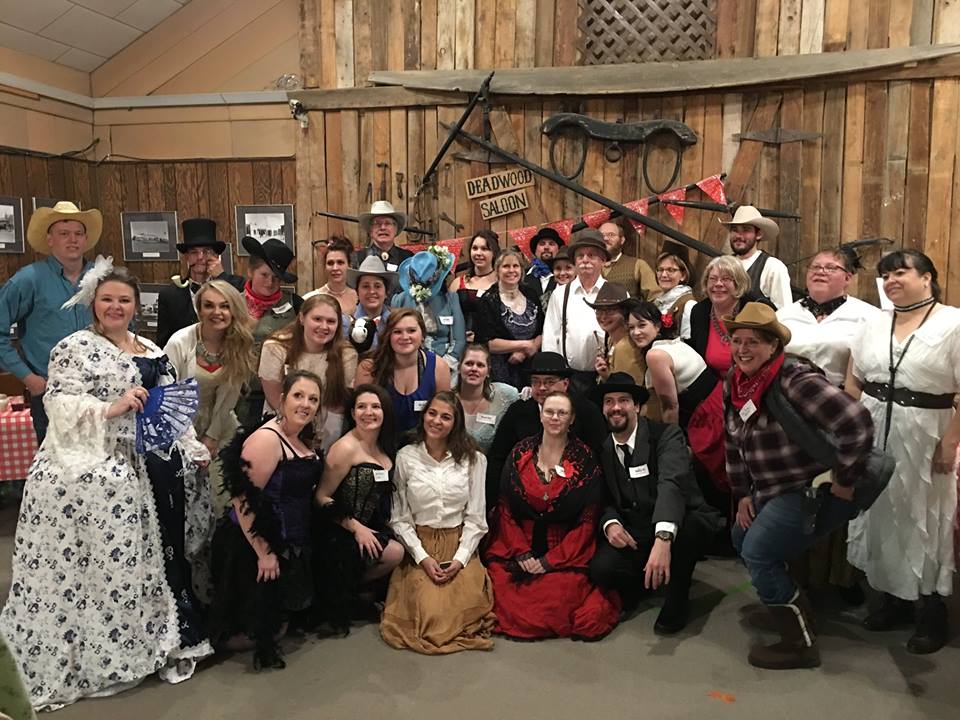
On Saturday February 10th the Riverton Museum hosted its First Annual Murder Mystery and Mayhem at the Museum event. The event’s 40 tickets were sold out almost a week prior to the event itself! The tickets included the price for a light dinner and bar that was catered by the Catering Company out of the Trailhead. Participants arrived at the museum starting at 6pm the night of the event, dressed to the nines in all manner of western wear. Folks received character packets prior to the event that held information about their characters and costume ideas. Characters ranged from Sally Starr the saloon girl to Banker Bob and his wife Banker Bonnie. Folks were encouraged to stay in character all night and many of the participants had no trouble at keeping the act going. During the course of the evening a “murder” occurred and the participants worked together to help, or hinder, the investigation. Many folks stated that they had been working out their costumes since they heard about the program weeks ago. As a whole the event was a smash hit!
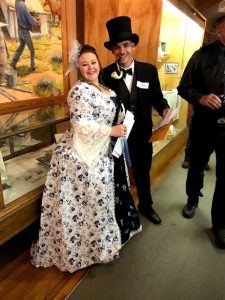 “We’re definitely going to try to do another event like this next year but change up the theme. We got tons of positive feedback from this event, and honestly, it was fun for us to put something like this on. We learned a lot from the experience and we’re hoping to expand upon that knowledge for next year,” said Felicity Boepple, the Riverton Museum’s Visitor Service’s Coordinator.
“We’re definitely going to try to do another event like this next year but change up the theme. We got tons of positive feedback from this event, and honestly, it was fun for us to put something like this on. We learned a lot from the experience and we’re hoping to expand upon that knowledge for next year,” said Felicity Boepple, the Riverton Museum’s Visitor Service’s Coordinator.
Prizes were given out for the first person to solve the murder, Best Costume, Best Acting, and more! The staff at the Riverton Museum would like to thank everyone who participated in the event as well as everyone who helped to make this program a reality.
The event was proudly sponsored in-part by First Interstate Bank out of Riverton.
February 2, 2018
Early Boy Scouts Program in Riverton
 The first Boy Scout Troop in Riverton was founded in 1917/1918. There is some dispute about which year it was founded, the Riverton Chronicle reports that the troop was started in 1918 but later editions of the Riverton Ranger reported that the first troop was started in 1917. However, both news sources agree that by late 1918 the Boy Scout Troop from Riverton was up and going strong. Some of the early members of those first troops were Franklin Sheldon, Charles Wheeler, Lawrence Hunter, Billie Warren, and many more.
The first Boy Scout Troop in Riverton was founded in 1917/1918. There is some dispute about which year it was founded, the Riverton Chronicle reports that the troop was started in 1918 but later editions of the Riverton Ranger reported that the first troop was started in 1917. However, both news sources agree that by late 1918 the Boy Scout Troop from Riverton was up and going strong. Some of the early members of those first troops were Franklin Sheldon, Charles Wheeler, Lawrence Hunter, Billie Warren, and many more.
At this point the Boy Scouts of America was still a fairly new organization, having only been established about 10 years prior to Riverton’s First troop. Never the less, the Folks in Riverton were convinced a troop would do the younger generations good. Through their persistence a Scout Movement was founded. One of the first projects of this early Scout Troop was to play a role in the war effort in Riverton during the First World War. The Scouts would help to sell Liberty Bonds around Fremont County.
The first Scout Master of record was Mr. A. L. Arnold; however, before him there was Rev. Phillips of the Baptist Church in Riverton. The Reverend was the unofficial Troop leader for the first year or so. After he became the Scout Master, A. L. Arnold helped to organize bonds that were sold to many Main Street business owners to help fund the first Boy Scout building. Many of the Scouts themselves helped to build this early building.
By 1923 The Riverton troop was able to send ten Scouts to summer camp at Camp Kemp in the Big Horn Mountains located about twenty-five miles from Arminto. A year later in 1924 sixteen Scouts attended camp at Camp Carrey on Box Elder creek in Casper Wyoming.
In the late 1920s, the Riverton Boy Scouts from Troop 29 would be moving to a new building that was erected under the sponsorship of the Riverton Lions’ Club. This new building was a log cabin with an upper and lower level and a large fireplace on the inside. The new building was located where the Chamber of Commerce is today. The log cabin structure was used for community events as well as the Boy Scouts meeting location.
The early Boy Scouts would spend time camping on North Fork and hiking out in Milford. Later camps were on Rock Creek near Atlantic City. In 1975 the Boy Scouts hosted one of the largest Spring Camporee’s in the Wind River Campground, just north of the Boysen Dam. The troops present at this Camporee included Troop 89 of Lander, Troop 45 of Cody, Troop 45 of Worland, Troop 38 and Troop 2 of Casper, and more.
The early Boy Scout Movement in Riverton proved to be a huge success, teaching boys from around the county many Scouting Skills that they could and would use even later in life.
In the words of Ira J. Bureson, “Boys will be boys-but they need not be juvenile delinquents. The Boy Scout Movement has proved that they will not be if given the right leadership.”…“Let us not forget that the Boy Scout Movement trains boys to be of help instead of a nuisance at a fire.”
Next up for the Fremont County Museums
Feb 10th, 6-8:30pm at the Riverton Museum, “Murder & Mayhem at the Museum”
Feb 10th, 6pm at the Dubois Museum, “What are All the Lights in the Winter Sky”
Wyoming Community Bank Discovery Speakers Series
Feb 17th, 3pm at the Riverton Museum, “History of the Delfelder”
Wyoming Community Bank Discovery Speakers Series
Feb 24th, 2pm at the Dubois Museum, “Jammin’ at the Museum”
The Dubois Museum, the Pioneer Museum in Lander and the Riverton Museum need your financial support. In the current economic environment the museums are more reliant than ever on donations from the private sector to continue to provide the quality programs, collections management, exhibits and services that have become their hallmark over the last three and half years. Please make your tax deductible contribution to be used specifically for the benefit of the museum of your choosing by sending a check to Fremont County Museums 450 N 2nd Rm 320 or taking it directly to the museum you choose to support.
January 29, 2018
Dubois Museum hire new collections manager: Kirsten Belisle
 Kirsten grew up in the suburbs of Rockford, Illinois, but spent many of her summer and winter breaks in Radisson, Wisconsin, her father's rural hometown of less than 250 people. There Kirsten hiked through forests, hunted crayfish in the creek, and skated on the frozen Chippewa Flowage. Kirsten was working as an intern at the Buffalo Bill Center of the West: Cody Firearms Museum during the summer of 2017 when she fell in love with Wyoming, its history, and its people. “When I found out about the collections manager job in Dubois, I knew I had to apply because 1) it was a job in the field I went to school for and wanted to work in, and 2) it was in a region of the country that was ripe with both beautiful views and fascinating history.” In addition, Kirsten felt the job itself sounded interesting and challenging while offering opportunities for professional as well as personal growth as I go about taking care of the diverse collections the Dubois Museum holds.
Kirsten grew up in the suburbs of Rockford, Illinois, but spent many of her summer and winter breaks in Radisson, Wisconsin, her father's rural hometown of less than 250 people. There Kirsten hiked through forests, hunted crayfish in the creek, and skated on the frozen Chippewa Flowage. Kirsten was working as an intern at the Buffalo Bill Center of the West: Cody Firearms Museum during the summer of 2017 when she fell in love with Wyoming, its history, and its people. “When I found out about the collections manager job in Dubois, I knew I had to apply because 1) it was a job in the field I went to school for and wanted to work in, and 2) it was in a region of the country that was ripe with both beautiful views and fascinating history.” In addition, Kirsten felt the job itself sounded interesting and challenging while offering opportunities for professional as well as personal growth as I go about taking care of the diverse collections the Dubois Museum holds.
Kirsten holds a B.A. History from Western Illinois University an M.A Museum Studies from Western Illinois University-Quad Cities, and a Collections Care Specialty Track Certificate from International Preservation Studies Center in Mount Carroll, Illinois. Kirsten loves hiking and visiting historic places; bonus points if the two can be combined. Kirsten’s other interests include paleography (the study of old writing), learning about US railroad history, and researching the role firearms played in developing leisure culture.
January 26, 2018
Murder at the Deadwood Saloon
The Riverton Museum is hosting an evening of Murder & Mayhem at the Riverton Museum on February 10th at 6pm.
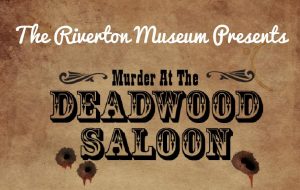 This fun evening will feature a great mystery, "Murder at the Deadwood Saloon", food, costumes, fun, prizes and more! Participants will work together to solve a "murder" at the museum, themed around the 1840's in Deadwood!
This fun evening will feature a great mystery, "Murder at the Deadwood Saloon", food, costumes, fun, prizes and more! Participants will work together to solve a "murder" at the museum, themed around the 1840's in Deadwood!
Their will be a cash bar and light dinner will be served. All proceeds for the event will help the Riveron Museums operations and programs.
Costumes are not required but are encouraged. There will be a prize for the best costume! You must sign up before February 8th 2018 if you want a character packet.
Tickets can be purchased for $20 from the Riverton Museum at 700 E. Park Ave or call 307-856-2665.
December 26, 2017
Fremont County Pioneer Museum in Lander, WY seeks Collections Manager
Collections Manager: Pioneer Museum in Lander, WY Open until filled
The Pioneer Museum in Lander, WY seeks an energetic professional to manage the collections. This individual will work collaboratively with other museum staff and other museum professionals within the Fremont County Museum System.
Position Description
Collections Manager
- Oversee all aspects of collection management including planning, care, loan requests, conservation, accessions, storage, research, exhibits etc.
- Perform historic research and assist with research requests
- Manage part time staff, volunteers, interns
- Work collaboratively with FCMS staff to advance the mission of all three county museums
- Deliver talks and lectures for public programs and special events
- Assist with educational initiatives for various Museum audiences which may include developing and leading public curatorial and gallery talks, meeting with classes and other written materials for various audiences.
- Assist in planning and implementation of special events
- Work with museum support groups to promote and advance the mission of the museum
- Ability to research and write professional historic journal articles
- Archival experience a plus
Qualifications/Experience
- Minimum Bachelor’s Degree in museum studies, history, art history, American Studies or related field:
- 1-2 years of curatorial experience preferred
- Ability to work in an environment where teamwork professional respect, personal ethics and character are the foundation for achievement
- Excellent organizational skills, computer literacy skills, preferred Past Perfect experience
- Candidate must possess effective oral and written communication skills and the ability to effectively manage multiple staff and volunteers.
- Published writer a plus
- Ability to Positively interact with visitors & lead tours
Compensation/Benefits
- $30,000/year plus very competitive benefit package that includes excellent retirement, health insurance, 10 paid holidays per year, sick leave and vacation leave.
Applicants
- Send, resume, cover letter and 3 professional references and unofficial transcripts to Fremont County Museums, Central Director, Scott Goetz, 450 N 2nd Rm 320 Lander, WY 82520 or email to scott.goetz@fremontcountywy.gov
November 27, 2017
Dubois Museum Spirit of Christmas Concert
Dubois Museum, Friends of the Dubois Museum, and Dubois Friends of the Library are once again hosting the Annual Spirit of Christmas. As always Packin’ the Mail will play true western fun dancing music, and some festive songs as well. The event will start at 7pm at the Headwaters Arts & Conference Center on Saturday, December 2nd. Donations are always appreciated at the door.
It is always fun for every age group and this year Mr. & Mrs. Claus have already let us know that they will be attending and look forward to it with joy. They also hope to share the night with kids, it’s never too late to tell Santa what you want for Christmas.
Desserts will be served at intermission and the winners of the gift basket raffle will be announced at this time too. The gift baskets include over $500.00 in value with various items generously donated by Dubois area businesses. Tickets can be purchased at the Dubois Museum Monday- Saturday 9am-5pm or at the High Country Christmas Extravaganza at the Headwaters Arts & Conference Center Friday, December 1st from 4-7pm at the Friends of the Library’s table. Tickets can also be purchased at the Spirit of Christmas event. The proceeds of the gift basket raffle will be split between the Friends of the Library and the Friends of the Dubois Museum support groups.
Don’t forget Saturday, December 9th is our open house with free admission and discounts in the gift shop. Purchase your stocking stuffer annual passes at any of the three Fremont County Museums.
For more information contact the Dubois Museum, 909 West Ramshorn, 307-455-2284 or by email at duboismuseum@gmail.com.
November 17, 2017
November 2017 Wind River Mountaineer
Th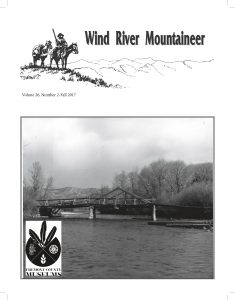 e Fall issue of the Wind River Mountaineer is now available at the gift stores at the Dubois Museum, Pioneer Museum in Lander and the Riverton Museum.
e Fall issue of the Wind River Mountaineer is now available at the gift stores at the Dubois Museum, Pioneer Museum in Lander and the Riverton Museum.
This articles in this issue are, "Outfitters, Artists and Much More: Joe & Mary Back" by Johanna Thompson from the Dubois Museum, "The Landers, an 1860's 'Power Couple'" by Randy Wise from the Pioneer Museum and "The Masonic Lodge" by Karline Stettler from the Riverton Museum.
Click on the link to view the on-line version.

